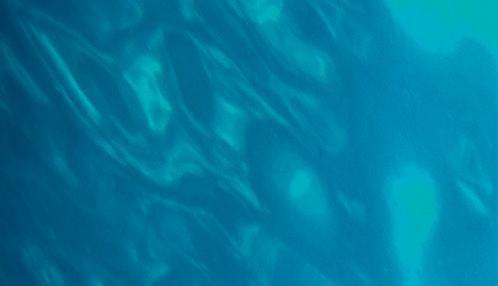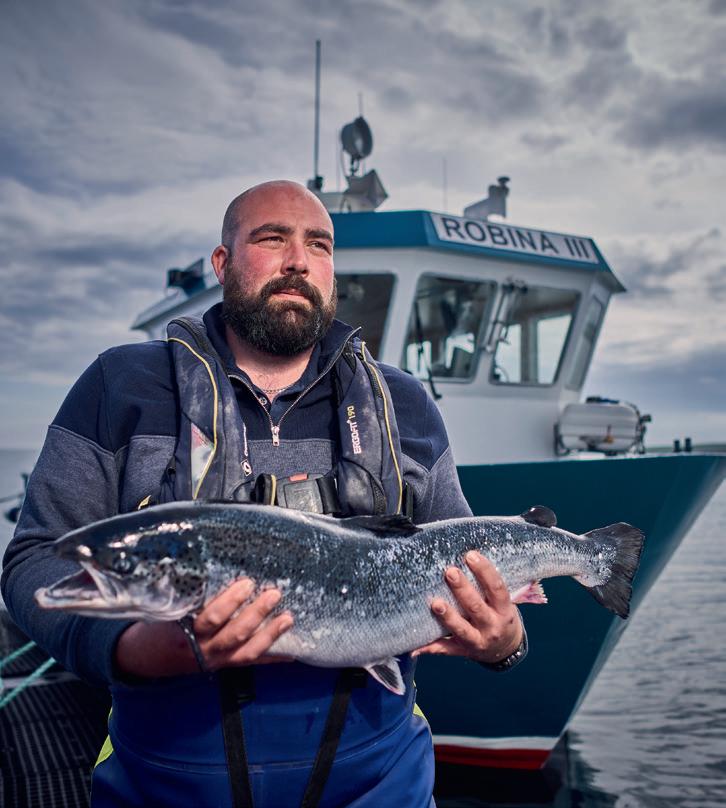









Creating new reefs for native oysters




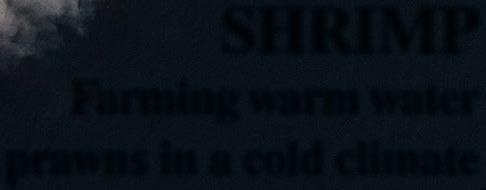
Farming warm water prawns in a cold climate

How is the sector faring?

Free from PFAS chemicals Free from microplastics
Slalåmveien 1, NO-1410 Kolbotn, Norway Ph.: +47 66 80 82 15 - post@netkem.no

05.12.2023 Fish Farmer Magazine for 2024















THIS month, Fish Farmer looks at a broad spectrum of the aquaculture sector, ranging from shrimp and oysters to salmon and trout. Our cover image depicts a boat laden with scallop shells, part of a project to recreate oyster reefs in the North Sea using “cultch”, hard organic material that acts as the perfect surface for native oyster spat to settle on and grow.
By using scallop and oyster shells from the seafood industry, not only is this ideal example of the circular economy helping to restore endangered native oyster populations, but it is also reducing the amount of waste going to landfill.
Also in this issue we look at some of the projects underway to create a European shrimp industry. Farming the world’s favourite tropical shrimp – L.vannamei, better known to UK consumers as “king prawn” – in a cold climate presents many challenges, not least in terms of energy costs, but there are already ventures taking shape that suggest that a sustainable, premium supply of fresh shrimp on our doorstep could be a reality soon.
Our review of the trout industry internationally finds plenty of optimism among the producers of this arguably undervalued salmonid. Trout is in many ways a more robust fish than salmon, and at its best easily stands comparison with its rival, Atlantic salmon.
Martin Jaffa examines sentinel cages, one of the ways used to gather evidence on sea lice populations and finds the science to be wanting.
Salmon Scotland’s Tavish Scott reflects on lessons from a visit to the Faroes, and Nick Joy expresses some scepticism over the rush to RAS production.
Meanwhile, we also feature the embattled salmon industry in British Columbia and a restocking scheme in Washington state, in the USA, involving a helicopter airlift.
Finally we also look at two aquaculture projects in the UK that have run into opposition: the plan for a RAS salmon farm in Grimsby and an ambitious seaweed farming project off the coast of Cornwall.
Best wishes Robert Outram
Editorial advisory board: Steve Bracken, Hervé Migaud, Jim Treasurer, Chris Mitchell and Jason Cleaversmith
Editor: Robert Outram
Designer: Andrew Balahura
Commercial Manager: Janice Johnston
ohnston shfarmermaga ine com
ce Administrator: Fiona Robertson frobertson shfarmermaga ine com
Publisher: lister enne
@fishfarmermagazine
www.fishfarmermagazine.com
Fish Farmer Volume 47, number 10
Contact us
Tel: +44(0)131 551 1000
Fax: +44(0)131 551 7901
Email: editor shfarmermaga ine com
Head o ce: Special ublica�ons e es ark 496 Ferry Road, Edinburgh EH5 2DL
Subscriptions address: Fish Farmer maga ine subscrip�ons arners roup ublica�ons plc The Mal�ngs est Street ourne Lincolnshire PE10 9PH
Tel: +44(0)177 839 2014
subscriptions: £75 a year
subscriptions: £95 a year including postage all air mail
Tavish
Nicki







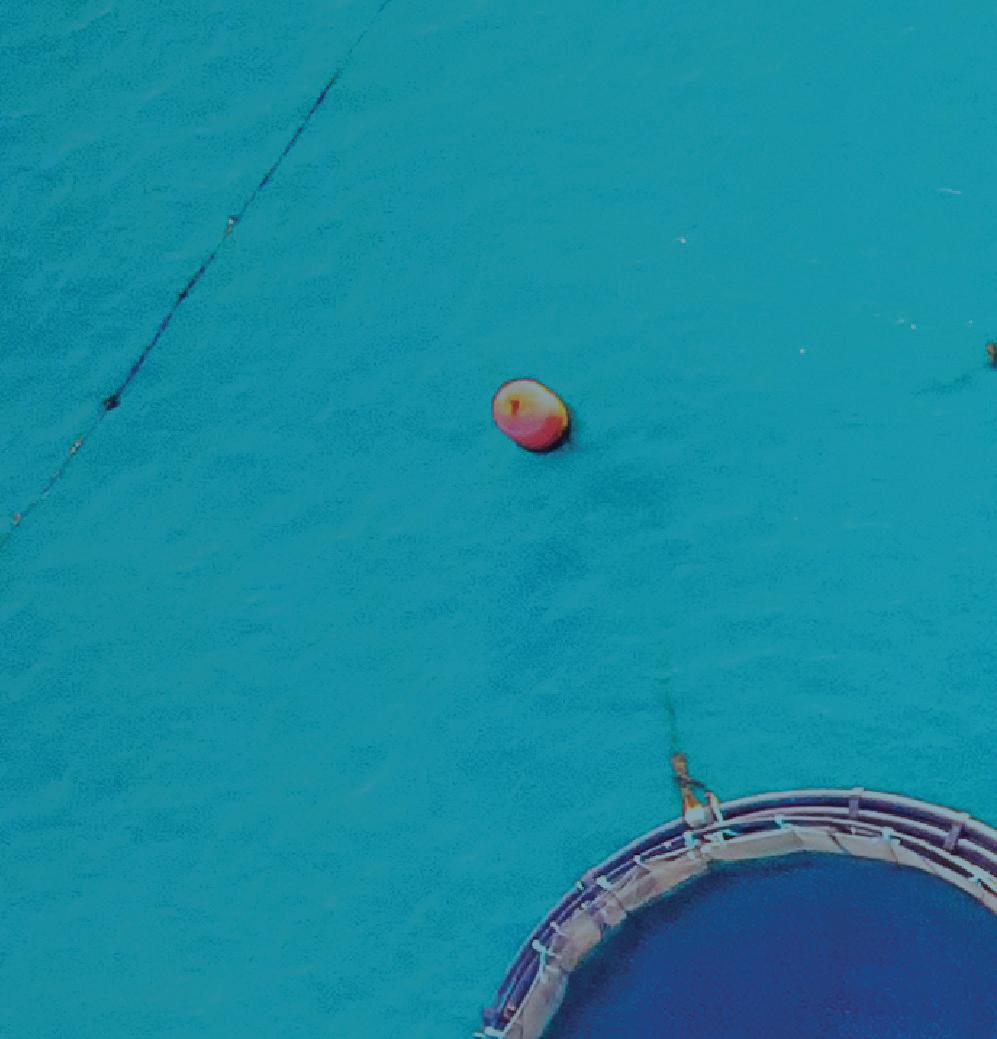

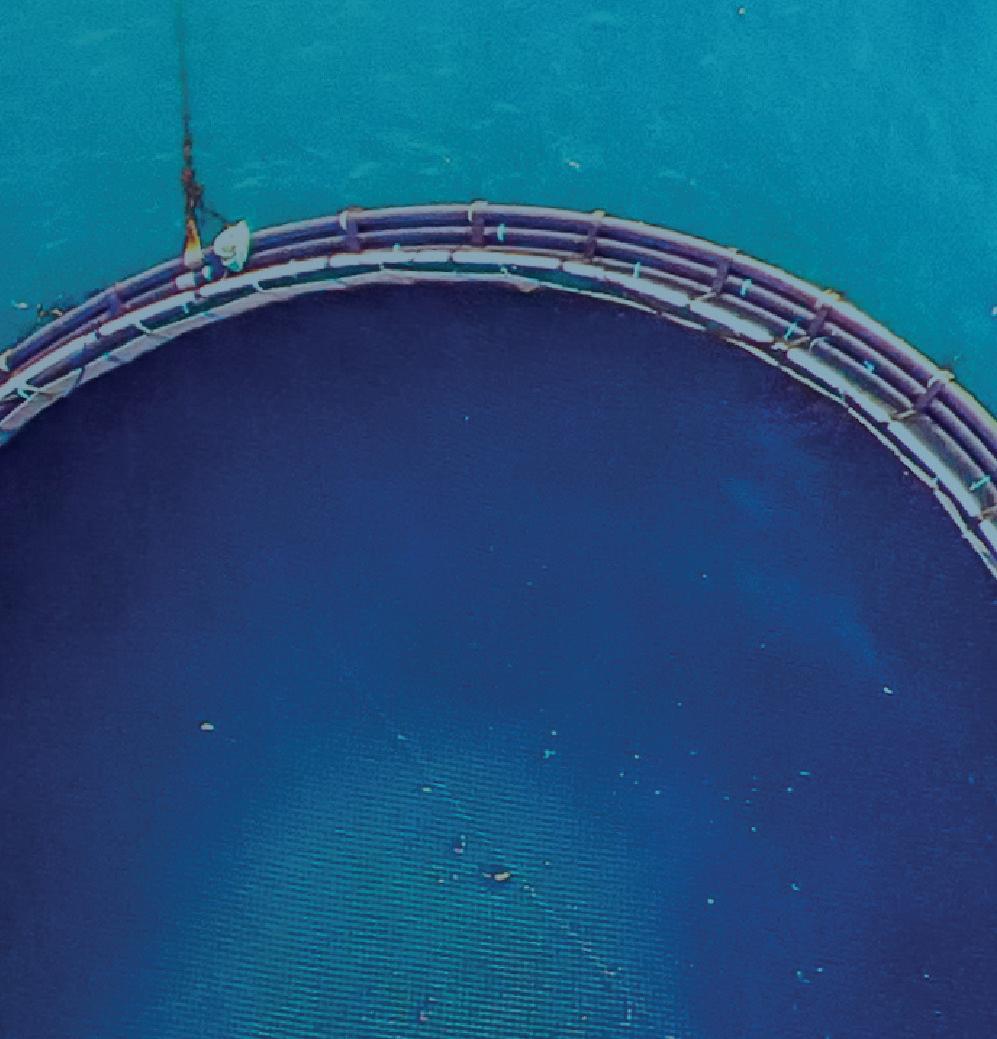














‘No cover-up’,
committee is told

A HEARING held as part of the Scottish Parliament’s inquiry into the salmon farming industry on 2 October was dominated by arguments over an alleged “cover-up” ahead of the MSPs’ visit to a fish farm in the previous month.
The Rural Affairs and Islands Committee of the Scottish Parliament is following up on a previous report, in 2008, on the salmon industry. As part of the inquiry, members of the committee visited a Scottish Sea Farms site at Dunstaffnage, near Oban on Scotland’s west coast, on 23 September.
Later that week, campaigning group Animal Equality UK released video footage which, it said, showed dead fish being removed from the pen in the early morning, ahead of the MSPs’ visit. Animal Equality UK Executive Director Abigail Penny said the removal of dead fish “morts” indicated that the salmon industry wants to “hide the truth” about mortality in farms.
She argued: “We urge the committee to see the industry for what it truly is: deceptive and deadly.”
At yesterday’s committee hearing, MSPs quizzed representatives of the salmon industry about the issue.
Dr Ralph Bickerdike, Head of Fish Health at Scottish Sea Farms, stressed that the morts removal that had been
filmed was a routine e ercise carried out at pens regardless of whether any external visitors were expected.
The pen concerned was one of seven that had been treated with fresh water and a certain number of mortalities could be foreseen. The numbers at the pen concerned were not out of line with typical outcomes, he added.
He stressed: “There was no attempt whatever to cover up.”
The industry’s arguments were supported by the Fish Health Inspectorate (FHI), which in a letter to the committee said that reported mortality levels at the Dunstaffnage site did not appear to be above that which would need to be reported.
a recognised aspect of animal husbandry.”
Tavish Scott, Chief Executive of Salmon Scotland, said: “This committee and our sector have been subject to a deliberate, orchestrated and coordinated campaign by antisalmon farming extreme activists, aided and abetted by some in the media. This is another deliberate attempt to derail the committee’s focus on what has changed in the Scottish salmon industry since 2008.”

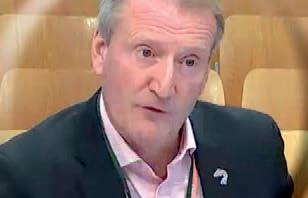
The letter also stated: “The FHI would consider that this procedure would be consistent with the mortality removal procedures on Scottish aquaculture farm sites.”
The FHI stressed: “Whilst any mortality is regrettable and should be minimised, where possible, it is




Later in the meeting, Scott clashed with Conservative MSP Edward Mountain, who suggested that Scott had put him under undue pressure to take a less critical attitude to the salmon industry. Mountain quoted from a conversation Scott had not known was being recorded, but the committee’s Convener Finlay Carson ruled this topic was not relevant to that morning’s hearing. As this issue went to press, Cabinet Secretary for Rural Affairs Mairi Gougeon was due to give her evidence on the industry on 9 October.

NEW restrictions on the use of the in-feed sea lice treatment Slice will impede salmon farmers’ efforts to contro arasites fish farmers ha e arne . he cottish o ernment has re ce the amount of emamectin benzoate, known commercially as Slice, that can be administered, fo o ing a cons tation on a ne en ironmenta a it stan ar .
implementation period is too long, the salmon sector has estione the scientific asis for ma ing the changes in the first ace.
cottish ea arms ea of staina i it an e e o ment nne n erson sai the ha een set so o to rotect a fresh ater s ecies et ice is fe to the fish in a marine en ironment.
“What is the likelihood, if you think about the places where we’re farming, of a sediment which has emamectin benzoate resent in it fin ing its a to a fresh ater ar ae he ho e sector s a erage se of emamectin enzoate has een g ann a o er the ast fi e ears a sma amo nt of me icine se to treat arge n m ers of fish. he sea e area of im act is er sma so the ris is sma . his an the a sence of a i e ath a to the sensiti e fresh ater rece tor rea estions the j stification for hat is in rea terms, a freshwater standard being imposed within the marine en ironment.



he re ise rom te concerns that the treatment is harmful to crustaceans, has been applied since March 2023 to new or increased consents t no the cottish o ernment has irecte the cottish n ironment rotection genc to im ement the re ise stan ar so that a farms i ha e to com ithin months. hi e en ironmenta cam aigners sa the fo r ear





cottish ea arms ea of eterinar er ices onnie o tar sai ets on t ant to e eft itho t ice in their me icina too o . e commente ice which has been around for 25 years, is such an im ortant art of o r ice contro rogramme. We tend to prescribe it in the post-transfer to sea stage to try to delay and control the sett ement of j eni e Lepeophtheirus ice. t s a so er im ortant in managing the seasona in of Caligus lice that come from i fish an can ca se s en more se ere ice amage to arger fish. t s n i e e ha e eno gh consent to se it in those fish n er the ne r es an that orries me.
f o ant to see higher s r i a rates then on t ta e a a a ita me icine that s orts s r i a .
SALMON farmer Bakkafrost Scotland has been granted a licence for a treatment system to turn fish waste into fertiliser.
The pyrolysis unit, which turns organic sludge into inert biochar, will be based at Bakkafrost’s hatchery at Applecross.
The company said it was an important step in establishing its “circular economy” credentials.
The licence for the pyroliser was granted by the Scottish Environment Protection Agency.
The surplus is a by-product of the wastewater treatment process in the hatchery’s recirculating aquaculture system (RAS) facility. It consists of organic and inorganic solids held in water. The process dries the sludge and turns it into inert biochar which is used as a fertiliser and soil improver, refining the structure and water retention in soils. This process also “locks away” carbon permanently.
In the first stage, hatchery sludge, roughly 97% water, is treated by going through a filter belt. The water content is reduced to about 80% and the dry matter content is increased to about 20%.
The next stage requires the licence as it incorporates a pyrolysis unit which dries sludge at about 300°C, generating sludge pellets. These are then heated to 700°C without the presence of oxygen during a pyrolysis process. Heat is effectively absorbed and repurposed inside the system, increasing total energy efficiency. The end product is a biochar which is a material with a high stable carbon content.
Ian Laister, Managing Director, Bakkafrost Scotland, said: “In a RAS facility, substantial quantities of unused ‘waste’ materials are generated, which must be separated from the water
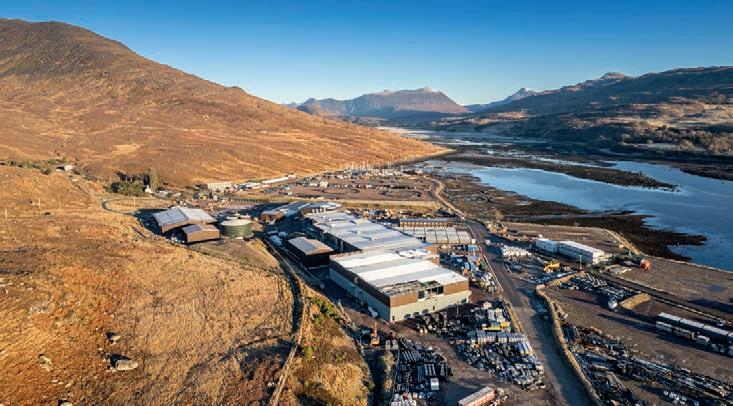
circulating back to the fish.
“Traditionally, that material has been considered waste, but technological advancements have opened the door to a more sustainable management process and that must be good news for helping protect our environment.
“All of this is very much in line with Bakkafrost Scotland’s sustainability goals and supports building a circular economy from farm to fork.”
Bakkafrost Scotland’s ambition for its RAS facilities is to reduce waste by 90 per cent, to use 100 per cent sustainable power and to reduce the water used in the process by 90 per cent. Hydro, solar, recycled material, and heat recovery systems will be used to reduce impact on the environment.

RSPCA Assured suspended three Scottish salmon farms from its animal welfare scheme, following allegations of animal cruelty.
Activists from campaigning group Animal Equality presented RSPCA Assured with drone footage showing that fish had been removed from the water for longer than the maximum 15 seconds allowed, causing them distress and risking suffocation.
The three farms are all on Scotland’s west coast: Loch Alsh, operated by Mowi; Fiunary, Sound of Mull, operated by Scottish Sea Farms; and Bakkafrost’s Ardcastle farm on Loch Fyne.
Animal Equality said: “In over a dozen incidents across the fourmonth period, salmon appearing to show signs of consciousness are left out of water for over one minute; one fish appears to suffocate for over three minutes. These instances of asphyxiation far surpass the RSPCA’s 15 second maximum allowance.”
The drone films also captured other instances of apparent abuse such as live fish thrashing in cages and salmon kicked along the deck of a boat. The incidents appeared to involve unwell fish that had been removed from the pen in order to be humanely despatched.
Abigail Penny, Executive Director of Animal Equality UK, said: “Here we have proof of over a dozen fish desperately struggling in their final moments of life – it begs the question: what else happens when no-one is watching? No industry of this scale, causing mass suffering to millions of animals each year, should ever be left to its own devices and, evidently, the Scottish farmed salmon industry needs far greater scrutiny.”
An RSPCA Assured spokesperson said: “We have launched an immediate investigation into these allegations and suspended membership of the three farms from the RSPCA Assured scheme, pending further investigation. This means they cannot currently market or sell any products under the RSPCA Assured label.
“As our inquiries are ongoing, we are unable to comment further at this time.
“Animal welfare is our absolute priority and we always take any complaints of poor welfare extremely seriously. We would urge anyone with any concerns about the welfare of animals on an RSPCA Assured certified farm to contact us straight away, without delay, so that we can immediately investigate and address any welfare issues as a priority.”
Scottish Sea Farms’ Head of Fish Health and Welfare, Dr Ralph Bickerdike, said: “Last month, we identified unacceptable lapses in best husbandry practice at one of our farms, following which we took immediate remedial action.
“This included issuing further guidance on how best to humanely cull poorly fish without delay; guidance that we issued cross-company in August to ensure all farms conform to best practice, at all times.
“To make doubly sure that this strict protocol is understood and upheld, our fish health team is also delivering and supervising additional refresher training in each of our farming regions.”
Scottish Sea Farms confirmed that its other farms continue to be members of the RSPCA Assured scheme.

SALMON ro cer o i cot an has transferre the first of its post smolts from Loch Etive to the company’s farm off the isle of Muck, on Scotland’s west coast.
o i sai the mo e as a significant mi estone . he och Etive sites were acquired by Mowi as part of its purchase of the fish farming assets of a nfresh in . he ha re io s een used to grow trout, but Mowi has repurposed them to grow post smolt salmon in conditions that, the company hopes, will make the transition from fresh to sa t ater more s staina e for the fish. Previously, individual sites at Loch Etive were fallowed at different times but Mowi’s new production plan includes six-month growth cycles to enable farms to synchronise fallow (empty) periods thro gho t the ho e och s stem. his rea in ro ction combined with the loch’s naturally brackish waters has helped to maintain a low sea lice population in Loch Etive, since sea lice do not o rish in con itions of o sa init .
ea ing a o t the ost smo t transfer en a fie
o i arming cot an re an aroes an t antic ana a sai he ost smo t sa mon ere in e ce ent con ition. am proud of everything we have achieved so far at Loch Etive which is pioneering best practice in aquaculture.
“Not only are we proving that there is a sustainable alternative to land-based post smolt production, we are also using new sea lice modelling to achieve greater monitoring and control of sea lice, combined with a new approach to fallowing, all of which is resulting in hea th ost smo ts rea to contin e gro ing at sea.

sa mon are feared to have escaped from a fish farm in orthern re an . he e artment of gric t re Environment and Rural Affairs is carrying out an investigation into the incident.
he a arm as raise on n a e tem er after a tear in a salmon cage at a site in enarm o nt ntrim.
Glenarm Organic Salmon is Northern Ireland’s only salmon farm, but the company has so far declined to comment.
Local anglers are already reporting the discovery of escaped salmon in the area.
ar o ston hairman of the Ulster Angling Federation, to e s in orthern Ireland that there was a danger that the escaped salmon will mix with the wild population. he ro ince has a re ati e sma so i fish farming sector and escape incidents on this scale are generally rare. he e artment of Agriculture, Environment and Rural Affairs said a report was made on the Sunday evening that “...a rip in the net of a farmed salmon cage had een i entifie at the site in enarm .

ORGANIC Sea Harvest has been given the go-ahead to create a ne fish farm off the coast of e j st a fe ee s after an ear ier attem t ha een t rne o n.
h anning committee ha ear ier ref se a ications for ne farms at a ma een an o igarr es ite anning officers recommen ing a ro a
he com an sai at the time it as isa ointe the ecision an o re ect on hat f rther action it nee e to rocee .
t ointe o t that the com an ha een farming sa mon in north east e since hen ermission for an initia t o cage gro s at n ertote an nacnoc as grante the anning committee. t a so sai it farms to some of the strictest organic standards in the world with accreditation from se era ea ing organisations.
n amen e a ication as asse to the f co nci ith officers recommen ing a ro a for a ma een t not o igarr .
rganic ea ar est ha re ce the n m er of cages from its initia ro osa s to i sa mon cages near o igarr an another at a ma een.
hose co nci ors ho o ose the ans agree that the roject co ring socia an economic enefits to e t sai the ere not consi ere s fficient to o t eigh the a erse is a an coasta im act on the s ecia a ities of the s ecia an sca e area.
ea ing to e s e ac nnes of rganic ea ar est sai e i ha e to re ect on to a in artic ar some of the comments that ere ma e mem ers. e ossi nee to re ert to some of hat as state

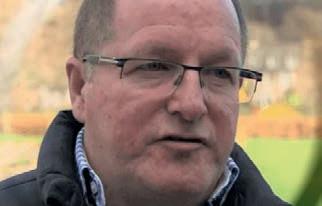

Organic Sea Harvest was established in ith the ision of fi ing a ga in the organic sa mon mar et.
t is a so the first ne
in e en ent o ne an o erate
sa mon farm in cot an for se era eca es going against the tren foc sing so e on raising organic sa mon.













































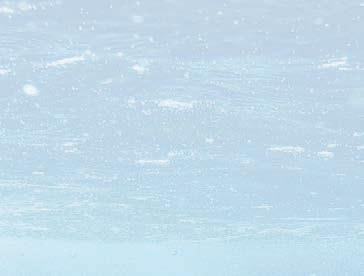





PLANS to build an £80m-plus landbased salmon farm in Grimsby face an extra hurdle following a High Court decision to grant a judicial review of the local authority’s planning decision in favour of the project.
The case was brought by the organisation Animal Equality UK, which has questioned the decision by North East Lincolnshire (Grimsby and Cleethorpes) Council, which granted permission for the project almost a year ago.

nima a it i arg e that the co nci s anning officers misdirected their committee by ruling that animal welfare concerns could not be considered as material factors in the decision-making process.
The company behind the project, AquaCultured Seafood, plans to produce up to 5,000 tones of Atlantic salmon for the UK
market within the next three to four years, in a recirculating aquaculture system (RAS) facility (pictured). Animal Equality is opposed to salmon farming whether on land or on coasts and fjords. It said: “In a bid to stop the construction of the site – put forward by start-up firm a t re eafoo t – Animal Equality now intends to argue in court that the committee’s decision to permit the site’s construction was unlawful, with committee members being told they could not take into account animal welfare.
“As a result, we believe that the highly likely catastrophic and irre ersi e anima e fare ramifications ere not inc e within their decision-making process.”
See special report, page 42.
JULY’S UK General Election saw many new faces elected to the Westminster Parliament – and in September several of them joined industry body Salmon Scotland at a breakfast briefing.
The event was hosted by Western Isles MP Torcuil Crichton, and it brought together several new politicians as well as long-serving MPs.
Those attending the breakfast event on Wednesday included Salmon Scotland Chief Executive Tavish Scott and representatives of member companies.
The MPs heard that Scottish salmon is the UK’s largest food export, with international sales increasing by 41 per cent in the first half of 2024, driven by substantial growth in the Asian and American markets and generating £431 million in value over the six months alone.
Around 12,500 jobs are reliant on the sector, with supply chain roles in every part of Scotland.
Salmon is also highly nutritious and has one of the lowest carbon footprints of any protein production.
Torcuil Crichton, MP for Na h-Eileanan an Iar, said: “Scottish salmon is due a boom in the next decade as global demand for good, low carbon and nutritious food grows.
“The challenge is to accommodate the expansion of farming while ensuring that communities reap the benefit of jobs and added value from this great Scottish product.”
Tavish Scott, Chief Executive of trade body Salmon Scotland, added: “It was great to be joined by so many of Scotland’s newest MPs and have the opportunity to highlight the
impact our sector has in each of the nation’s 57 constituencies.
“MPs were able to meet with representatives from Scottish salmon producer companies and learn about the thousands of supply chain companies which contribute to the sector’s success.”


the com an sa s.
Not only were colleagues helping clear debris from coastlines across Shetland, Orkney and the Scottish mainland, but each participating team was also awarded a £100 Heart of the Community donation for the local cause of their choice.This year’s event, which ran from Friday 20 to Sunday 29 September, was the company’s biggest yet with 16 beach cleans registered.
Kishorn Farm Manager Iain Flack said he and his team had a vested interest in protecting the coastal environment and were looking forward to working with other volunteers to help keep the shoreline pristine.
He explained: “It’s not a question of engaging with the local community, we are part of the local community.The majority of the farm team live in and around the area so it’s only natural that we want to look after it. The more of us locally who pitch in, the bigger the difference we’ll make.”
Scottish Sea Farms Heart of the Community Coordinator Jessica Taylor-McKaig said: “Our farm teams are involved in beach cleans throughout the year... but the Great British Beach Clean is great for enlisting the support of colleagues from across the wider company.”
PLANS to extend marine planning zones in Scottish waters have been put out to public consultation.
ish an she fish farms re ire anning ermission o t to 12 nautical miles, however local authority responsibilities for anning contro s c rrent on e ten to three na tica miles. Under new proposals, the marine planning zones will be extended.
he cottish o ernment arg es that c arif ing res onsi i ities an e ten ing the imits for oca anning a thorities creates the otentia for ne sites to ring in more in estment an jo s artic ar for is an an coasta communities.
nno ations in techno og mean that a ac t re sites can no e ocate f rther from the shore the o ernment sa s adding that these developments have the potential to reduce the en ironmenta im act of marine farming essening interactions ith i sa moni s an s orting farme fish hea th an e fare.
The 12-week consultation runs until 11 December and the document Extending Marine Planning Zones can be accessed online.
Public Finance Minister Ivan McKee said: “These proposals rogress o r ision for staina e ac t re commitment to e ore the reg ator frame or e on three na tica miles and to support innovation. Our proposals could boost the marine fish an she fish farming in str ith more o ort nit for e e o ment an se of ne techno ogies whilst ensuring consistency in roles and responsibilities and ro st assessment of e e o ment ro osa s.
“Protecting Scotland’s marine environment is crucial and supports marine industries. Developments must balance environmental impact alongside the economic opportunities. he enefits to coasta an is an comm nities co e significant an these comm nities in artic ar are encouraged to share their views.”
nforma cons tation has a rea ta en ace ith the oca anning a thorities a ac t re gro on ention of cottish oca thorities ea s of anning cot an o a ac t re reg ators a mon cot an ssociation of cottish he fish ro ers an ritish ro t Association.
tension of the marine anning zones o e carrie o t means of an affirmati e cottish tat tor nstr ment to amen he o n an o ntr anning arine ish arming cot an r er .

Hatch something new and watch your profits grow.
• Higher densities for higher pro ts
• High Market Value
• Low maturation, high survivability, triploid, disease-free
• Available 4 times/year: Oct, Jan, Apr, July
• Special 1st time trial pricing available Please email for more information
Helping you feed the world.







DANISH family-owned fish farming group Aqua ri has entered into a partnership with the van der Wees family, which is now the company’s ma ority shareholder of Aqua ri.
The two families said they share “a common ambition to consolidate and e pand the over 00-year-old company”. Aqua ri was founded by Anders riess in lyng re, enmark, in 00. enning riess and his cousin orten riess are the fourth generation of riess at the helm.
The company’s core business is the farming, processing and sales of trout,
trout caviar and fresh ander also known as pike-perch .
Aqua ri has a total of facilities in enmark, both on land and at sea. ports account for of the company’s business, with key markets including the Nordic countries, apan, ermany, kraine and the A. Aqua ri employs more than 00 employees, all in enmark.
nder the deal, the riess family will retain “a significant shareholding”, and enning and orten riess, who have led the company for the past 0 years, will continue in the management team,
working closely with the new , Ale andre van der Wees.
The van der Wees family is a rench entrepreneurial family with roots in retail.
Ale andre van der Wees said “ y family and I are proud to partner with the riess family, who, over the past years, have developed a beautiful company that provides high quality products and a great place to work I am particularly e cited to oin the team of e perts that make up Aqua ri, and I look forward to continuing to learn about the company through its operations and alongside industry specialists.”
enning riess said the new ownership marks the end of a thorough search for the right strategic partner.
e said “We have been looking for a partner to help us develop and grow Aqua ri for some time. ut we have also allowed ourselves to be picky and take the time needed.We first met Ale andre in 0 , and the ties that we have bound with the van der Wees family through the past five years have convinced us that they are the perfect partner. ur families share the same values and have a mutual and long-term ambition to develop Aqua ri, which is e tremely important to us.”
LAND-based fish farmer The Kingfish Company has signed an agreement with aquaculture supplier VAQ AS for the development and preliminary engineering of Phase III of its yellowtail kingfish farming facility in Zeeland, Netherlands.
The project involves a significant expansion of The Kingfish Company’s existing production facilities. The company has previously completed two construction phases in Kats, Zeeland, and already delivers high-quality yellowtail kingfish to the European market. The agreement with VAQ covers process and engineering services for planning a third facility at the site. Deliverables include the design of production facilities, RAS (recirculating aquaculture system) design, and relevant support systems with process and flow diagrams, as well as wastewater treatment.
The preliminary project began in early September and is expected to be completed by the end of 2024. The results will form the basis for The Kingfish Company’s final investment decision.
Vincent Erenst, CEO of The Kingfish Company, said: “This partnership marks a pivotal step towards scaling our sustainable aquaculture operations and continuing our commitment to delivering premium quality yellowtail kingfish using environmentally friendly practices. We look forward to working closely with VAQ AS to drive innovation and sustainability in the aquaculture industry.”
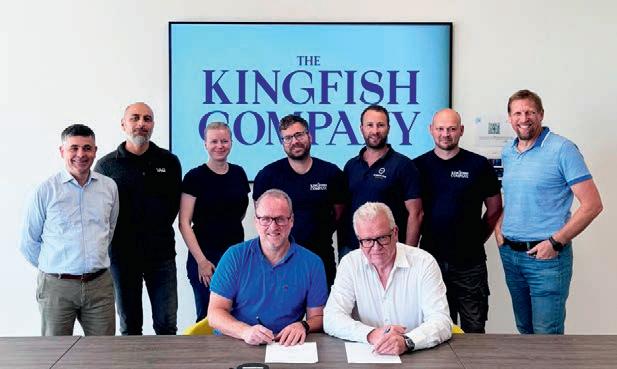
Above: Team photo from the signing ceremony ack ean- harles alette T , elipe squivel A enior ro ect ngineer , Tilla ygard oltermann A ept anager rocess iology , ram ohaan T ead of perations , Wesley arrant T ead lectrical ngineer , uibert ornelisse T Technical pecialist , hristiaan de Wet T ead of esign ngineering ront ondre idalen A , incent renst T
Sondre Høidalen, Managing Director of VAQ AS, commented: “We are very pleased to have won this exciting assignment in a highly competitive environment and look forward to expanding our experience from building complete salmon farming facilities to include a new fish species for us in collaboration with The Kingfish Company.”
ARCTIC-based salmon farmer Nordlaks has purchased a large site for its proposed new smolt facility.The company said the project will create 50 direct jobs and around 100 ancillary employment opportunities.
or a s confirme the mo e after signing a ea ith arsta Municipality for 70 acres of land at Rødskjær. It will be company’s fourth and largest smolt facility to date.
ec ti e irector ri e e sai f e manage to achie e hat e ant here at s j r it i ha e major ri e effects. here co e to jo s here an for e er jo e manage to create in Nordlaks, it leads to at least two more in other industries. In other words, it means up to 150 jobs, work for oca s iers an e en more hea th sa mon.
e a e e are no signing one of the argest an most important agreements of all time with a business operator. It is wonderful news that Nordlaks is approaching the realisation of its am itio s ans for s j r.
arsta har o r an arsta m nici a it are joint e e o ing commercia areas an a har o r on s j r ocate in the middle of northern Norway – and in the middle of the most populous region in the country.
his sho s the o er of the oca o nershi e ha e in the a ac t re in str in the region sai ari nne sa a or of arsta m nici a it .
s j r is a so seen as an attracti e siness area for sea ase in stries for the entire oga an region.
he a ac t re in str is e ecte to ma e a significant ro ortion of the e e o ments that i ta e ace on s j r in the coming years.The industrial area is expected to attract ne com anies an in estments an strengthen the region s economic foundation.
or a s a rea has significant acti it in the m nici a it ith three smo t faci ities in the area. he atest one i ho se se era mi ion fish.
The project will be in the billions (krone) range and will make it possible for Nordlaks to allow the salmon/smolt to grow larger on land before they are released into the sea.Traditionally, the salmon/smolt has been 150-200 grams when released into the
sea, while so-called large smolt is between 500 grams and one kilo.
or a s erations irector i in je ing sai allowing the salmon to grow larger on land, we reduce the time the sa mon i e in the sea. his re ces the ris of isease an the sa mon is ess e ose to ice. t sim ro i es etter fish e fare. o achie e this e nee more smo t faci ities. hat is h Rødskjær is important for Nordlaks, in addition to the fact that it i create man jo s oca .
nother a antage of a shorter time in the sea is that it i e ossi e to ha e greater ro ction in e isting faci ities. n other or s je ing sai there is etter ti isation of the ocations that are already in use today.
rigina the an as to acres of an t the roject was scaled down to 70 acres.
e e sai e en e a ing mi ion [around £5m] in tax last year, an increase of 164% from the re io s ear. hen o r in estment ca ita is so significant re ce there are of co rse conse ences t e are sti er ha to ta e a ste for ar in rea ising this roject.

NORWEGIAN seafood exports continued their record run in September, totalling NOK 11.6bn (£828m) – an increase of 6% by value on the same month last year. The volume, at 141,600 tonnes, represents a rise of 9%.
It was also a strong quarter (July to September) for salmon, which now accounts for 70% of all seafood sold, with 372,442 tonnes sold at a value of NOK 31.8bn (almost £2.3bn).

Seafood Norway said the quarterly value increased by NOK 997m (£71m) or 3% in value and 8% in volume on Q3 a year ago.
As usual Poland and Denmark, which have large salmon processing sectors, along with the United States, were the largest markets.
Seafood Council analyst Paul T Aandahl said growth in Germany, particularly in home consumption, has been particularly strong.
He added: “At the same time, the consumer price is falling compared to the same period last year. This strengthens the competitiveness of salmon compared to other proteins.”
Farmed trout exports also did particularly well with a record 25,033 tonnes sold during the quarter at a value of NOK 2bn (£144m). The value increased by 24% and the volume was up by 34% .
All Norwegian seafood exports hit a Q3 record of NOK 44.1bn (£3.15bn) which was 5% higher than Q3 12 months ago.
Seafood Council CEO Christian Chramer said: “Thanks to a historically high export value in September, we have put behind us the best third quarter ever.
“This time there is, so to speak, no currency effect from a weak Norwegian krone, since we are comparing with the same period last year.
“There were high volumes for salmon, trout, mackerel and prawns which drive up the export value.”
Aquaculture also appears to be compensating for reductions in fishing catch quotas, most notably for cod and haddock.
TONE ellesvik pictured has been appointed as ales anager at Norwegian cod farmer de. he brings over 0 years of e perience in the seafood industry, with e pertise in the sales and marketing of whitefish. ellesvik was previously ales irector at Nordic roup and has previously served as ales irector at companies such as omstein and Terra eafood. de, one of the country’s leading cod farmers, currently operates five sea facilities and has its own hatchery.

THE slo government has persuaded ra il to fully open its market to Norwegian seafood, most notably salmon. nder the agreement, Norway’s ood afety Authority can issue health certificates for aquaculture products e ported to ra il. The health certificate covers all species and products from aquaculture, from fillets to whole, gutted fish and all forms of preservation, including smoked products. owever, farms that have suspected or proven I A or pancreatic disease will not be included.

FOR the first time, more than half the fresh cod e ported from Norway last month was farmed. Two months ago the ratio was a third, which demonstrates the impressive growth in this still relatively young branch of aquaculture. The total eptember fresh cod e port figure was , 00 tonnes and worth N



THE giant ortuguese supermarket and food group er nimo artins Agro-Alimentar
A has purchased two million shares in the Norwegian landbased salmon producer Andf ord almon for an estimated N 60m . m , adding to the retailer’s e isting stake in the company.
The shares were bought from Andf ord oldings A at a price of N 0 each.
er nimo artins AgroAlimentar A A is a company closely associated with Antonio errano, who has been a member of Andf ord’s board of directors since 0 and is also of A. e is a former ortuguese inister of Agriculture and isheries.
Andf ord olding is a company associated with ounder and oard ember oy ernt ettersen, who said he was happy at the purchase as A had played a key role at board level in Andf ord’s success.
The deal makes up a little under three per cent of the outstanding shares in Andf ord almon, but it does reflect the gradual but increasing overseas interest in Norwegian salmon businesses.
ocated on the island of And ya in the Arctic archipelago of ester len, Norway, Andf ord almon has developed an innovative aquaculture system for the shore-based farming of Atlantic salmon, based on its patented fl ow-through technology.
er nimo artins AgroAlimentar A was created in 0 to safeguard the ability of ortuguese food retail companies to supply themselves directly with strategic products, ensuring food security and availability. It operates several hundred food stores in ortugal, oland and in olombia, outh America.
A operates in four principal business areas dairy, agriculture, aquaculture, and fruits and vegetables.
In aquaculture A started to produce sea bass in ines through eaculture in 0 6, followed later by the production of sea bream in adeira in partnership with a local company. In 0 , eaculture was granted licences to build from scratch offshore aquaculture units in the Algarve to produce sea bream and sea bass.
million 6. m . While volumes were slightly down, the value rose by with of that total coming from Norway’s cod farms. eafood ouncil
Analyst Thomas akobsen said this is the first time that cod farm production has overtaken the trawler catch in the fresh category.










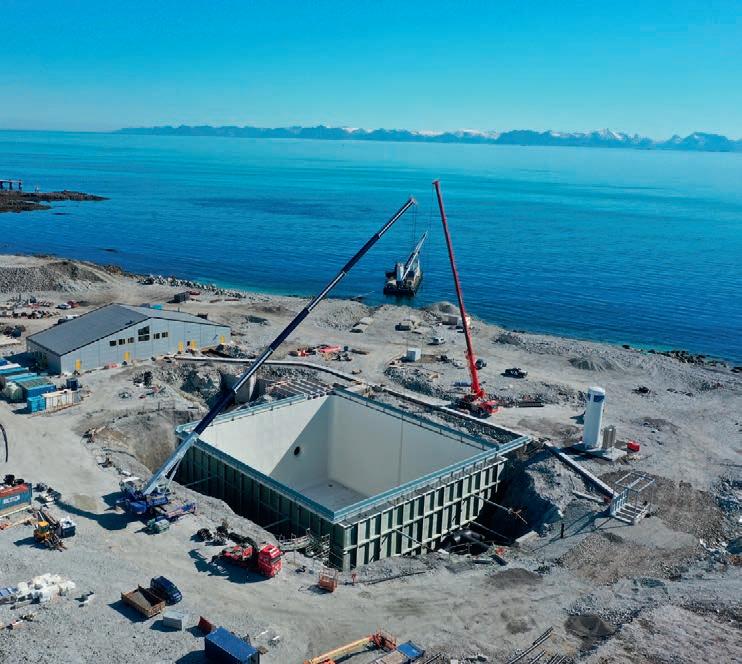

SOME of Norway’s largest salmon companies are in for an anxious time as they await the European Commission’s ne t mo e o er a ege rice fi ing. three a hearing in Brussels with the EU’s competition authorities came to a c ose on e tem er.
If found guilty, the salmon producers face the prospect of eing fine to of their ann a g o a t rno er. n the case of o i ase on its sa es this co tota m aro n m an for a ar it co e to m.
However, it is unusual for the EU to impose maximum ena ties in s ch cases.
It is not known how long the companies will have to wait, t it co e se era ee s. simi ar a egation in the United States has already been settled, costing the salmon farmers m m s an a itiona m . m to c ose ana ian c aims. he sett ement i not inc e an a mission that the com anies ere at fa t. It was thought then that the EU, which takes a strong stand against cartels of any kind, might also settle but that has not ha ene .
he si com anies ha e a strong enie the a egations hich go ac a most fi e ears to hen the as sti art of the . t the time in estigators rai e some of the cottish offices of or egian o ne com anies. he com anies ha ear ier een gi en ermission to st the EU investigation documents, allowing them time to is te an thing the containe . his has no een fo o e up by the hearing last month, which was held behind closed oors.
he sa mon com anies are a so facing a simi ar c aim of aro n m from se era of ritain s ea ing retai ers as e as a c ass action s it re resenting cons mers t if they are cleared by the EU those claims would become har er to s stain.









THE jellyfish scourge which cost Norwegian salmon companies millions of krone last winter may be on the way back.
The Norwegian Institute of Marine Research, through its Jellysafe project, says there have been increased sightings of the “perlesnormanet” jellyfish – also known as string or barbed jellyfish – and estimated numbers are now running at the same level as last year.
So far, however, no salmon farmers have reported any losses from this growing and serious problem.
Jellyfish attacks adversely affected almost every major salmon company in Norway last year – and some in Scotland – leading to the premature deaths of millions of salmon.
Some colonies were up to 30 metres long, but when broken up they got into the cages, killing the fish.
Jellysafe said the number of weekly Apolemia uvaria observations continues to increase in a pattern similar to the autumn last year.
A cluster of Apolemia was observed in salmon farming area PO3 near Bergen.
The institute has been carrying out research on how much of the damage and huge cost of last winter can be prevented. It says that the industry may be able to help. Jellysafe is invitingfish farmers to participate in a discussion forum to share experiences, get quick access to results and help the project to continuously come up with solutions that will prevent major damage in the cage.
The institute also wants samples from along the coast, so it can see if there are genetic differences between the various groups and those from last year, and it has offered to send out sampling kits.

FAROESE fish farmer akkafrost has reported a significantly higher third quarter harvest, with its cotland arm showing a marked improvement.
The aroe Islands produced ,600 tonnes, a rise of , 00 tonnes on the same period months ago.
The harvest in akkafrost cotland, which is now recovering from various biological issues, totalled , 00 tonnes against , 00 tonnes in 0 . All harvest volumes are provided in head-on gutted equivalents.
eed sales in 0 were , 00 tonnes with the group’s feed subsidiary avsbr n sourcing 0,000 tonnes of raw materials in the three months uly to eptember.
esults during the previous quarter were badly affected by a month-long general strike which almost paralysed commercial activity on the aroe Islands.
The stoppage proved costly for akkafrost because the harvest had to be delayed until after the dispute was settled which was also a period when salmon prices dropped sharply.
akkafrost has since highlighted ma or
progress in cotland, resulting in increased revenues and profits.
It said in August that an early harvest policy and sourcing smolts from its own in-house production had helped to achieve ma or improvements.
The company added “ ne key element of this strategy is to harvest around 0- of the planned total harvest volume for 0 during and , ahead of which tends to bring more biological challenges in cotland.”
The full third quarter report, when more details on strategy should become known, will be released on November.


T e port value of Icelandic farmed fish has reached more than 0m I . billion during the first seven months of 0 , according to the latest official figures.
tatistics Iceland said most of this was due to higher salmon sales, which are now starting to rival other northern hemisphere salmon producing countries. Iceland’s salmon e ports between anuary and uly this year totalled I . bn almost m , higher than in the same period in 0 .
The growth in salmon farming over the past few years is little short of phenomenal. In the past seven years they have increased tenfold to I . bn in 0 . They fell somewhat last year, due to a number of farming facilities being out of action for various operational reasons.
Icelandic salmon companies have been stepping up production this year and a
number of new salmon farm pro ects are currently underway, suggesting that e ports will continue to increase at pace.
There was a slight reduction in Arctic char a form of trout sales during the first half of this year which totalled m. tatistics Iceland said it was a similar story for the high tech product fertilised salmon ova, which was worth around I billion . m .
In fact the pace of Iceland’s farmed fish e ports accelerated even further during August, for which figures have ust been published. They were worth I . bn around m , an increase of 60 on a year ago.
Iceland’s salmon output generally speeds up during the high summer months, but there is no doubt that the country’s salmon sector is now becoming a force to be reckoned with.


NORWAY has secured an agreement to sell more seafood into the European Union.







The agreement, which will greatly help Norway’s salmon producers, was reached through the EEA (European Economic Area) which also involves Iceland, another important seafood supplier.
The EU bloc is Norway’s largest salmon buying area with Denmark, the Netherlands, Poland and France the main markets.
Norway’s Fisheries and Oceans Minister, Marianne Sivertsen Næss, said the deal provides higher duty free quotas and export opportunities for Norwegian products, both fisheries an a ac t re.
Negotiations to agree on the next period of EEA-EU trade relations formally began in June 2022. In June this year, the agreement was approved by the Council of the EU, which represents the member states.The agreement will now be submitted to the Storting, Norway’s parliament, for approval.
he minister sai fi e roce res for enacting the agreement mean that it will take a few months before the industry can start using the duty-free quotas.
he sai e are in ia og e ith the to fin a so tion that helps the industry to draw on the duty-free quotas as soon as possible.This is something Norway has worked for all along.”
However, it may still take some months before the seafood industry is able to activate the new export quotas.
UP to 10,000 salmon in northern Norway have reportedly been killed by poison gas.
The regional newspaper Lofotposten said the incident took place at Eidisholmen outside tamsund.The fish had an average weight of around two kilos. The gas is reported to be hydrogen sulphide, sometimes called sewer gas. It is colourless and known for its pungent “rotten egg” odour at low concentrations. It is e tremely flammable and highly toxic and can occur naturally under certain conditions.
According to Lofotposten, the incident affected a site owned by Isqueen, a local family-owned
salmon farming company.
Isqueen was quoted as saying the problem first became apparent earlier this month when gas bubbles, smelling of rotten eggs, were observed.
Production manager Henrik Svendsen told the newspaper that the deaths are believed to have been caused by the period of unusually high summer temperatures.There have also been unusually calm seas, and a reduced water flow in the facility. The company has informed the Norwegian Food Safety Authority.
Isqueen AS is run by the Svendsen family and was previously known by the name of Lofoten Polarlaks.





NORWEGIAN fish farmer
almon volution is moving decisively toward a full year harvest target close to ,000 tonnes, according to the company’s latest market update.
The company operates a landbased salmon farm, using a hybrid flow-through system, at Indre ar y on the Norwegian coast.
It reported a third quarter output of 6 0 tonnes head on, gutted taking the 0 second half total to around , 00 tonnes and the full year to appro imately ,000 tonnes.
almon volution said it had had good biomass build-up during the quarter, with steady improvement in the daily growth rates and continued strong results on key parameters such as feed conversion ratio, mortality and superior grade share.
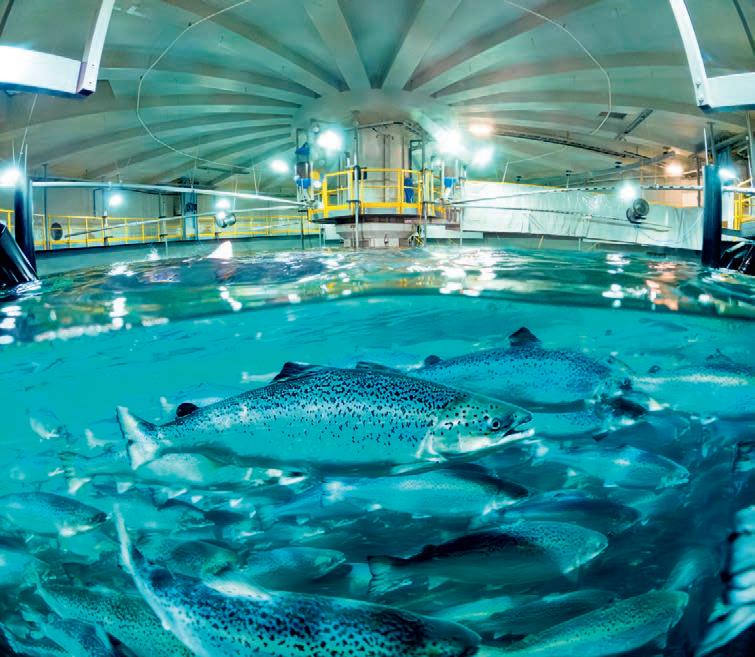
price realisation of N per kg . .
The report said the 6 0-tonne harvest had a superior grade share of , and an all-in
The average weight of . kg was up by 0 from the second quarter this year. The standing biomass had reached , tonnes
by the end of last month.
“The biomass production is steadily improving at Indre ar y, with a wide range of initiatives ongoing to take out the full growth potential”, Trond kon chaug- ettersen said.
e added “The standing biomass is close to record levels going into , which together with a further increase in e pected harvest weights, makes us well positioned to capitalise on the e pected price rebound.”
A few months ago almon volution signed a deal to start building the second phase of its Indre ar y pro ect.
The agreement was with the flow-through, hybrid and A technology company Artec Aqua and the construction firm ent A . With capital now in place through a private placement of equity, construction work is e pected to start this autumn on phase .
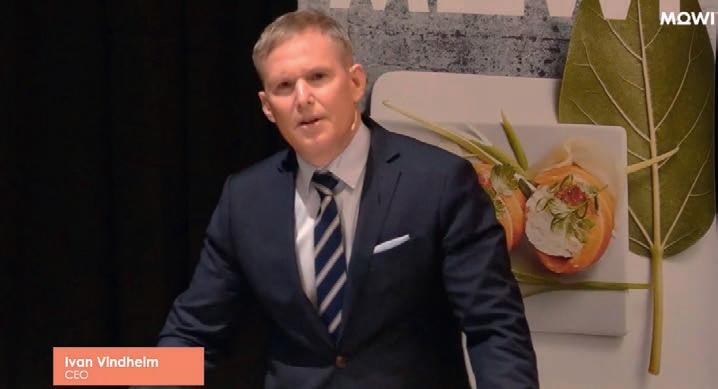
THE world’s largest producer of Atlantic salmon has spelled out a strategy to cement its leading position in the industry in the coming years.
The Mowi group’s plan is to grow production volume by 100,000 tonnes as well as making cost “improvements” of €300m-€400m (£250m-£333m). Mowi is also considering moving to other methods of salmon farming in addition to coastal operations.
CEO Ivan Vindheim (pictured, at the group’s Capital Markets Day presentation in September) said: “After reaching a milestone 500,000 tonnes of salmon harvested in 2024, we are now looking ahead to the next milestone of 600,000 tonnes which we aim to fulfil in 2029.
“We will achieve this through better utilisation of licence capacity, while also improving productivity and biological performance of existing production through our investment in post-smolt.” Furthermore, he added, Mowi is planning an ambitious cost improvement programme, building on a drive launched in 2018, which has led to €300m (£252m) in savings through 1,700 different initiatives.
He said Mowi’s strategy is built on three pillars – volume growth, competitive costs and sustainability. The company has grown from producing 375,000 tonnes of salmon in 2018 to an expected
500,000 tonnes in 2024. Now Mowi plans to continue that trend.
“We have grown faster than the rest of the industry in recent years, and our goal is to continue to do so in the future. By releasing more smolt and increasing our use of post-smolt we will be able to harvest 600,000 tonnes of salmon in 2029, thereby reinforcing our position as the world’s top producer of Atlantic salmon,” Vindheim added.
In addition to the company’s post-smolt venture and the improvements in biological performance that it brings, Mowi’s digitalisation and automation strategy is also central to the company’s plans.
“We launched Mowi 4.0 in 2021 and since then have invested heavily in a range of measures to introduce greater efficiency and automation across our value chain. We are already seeing the positive impact this has had on sustainability, productivity and cost reduction, and we expect to reap further benefits in the years to come,” Vindheim said.
Continued growth in Mowi’s farming operations will in turn lead to growth in its two other divisions,namely consumer products and feed. “The rest of the supply chain will grow in line with farming going forward. To produce more salmon we need more feed, and more salmon means more raw material for our 20 secondary processing plants around the world,” the CEO added.
The company estimates revenue growth of 7-8% per year over the next five years, resulting in revenue of €8.5bn (£7.1) in 2029, compared with €5.5bn (£4.6bn) in 2023.
Mowi’s focus has been and will continue to be sea-based salmon farming and related technology, Vindheim stressed. He said, however, that the company is nonetheless closely observing developments in other technologies and is prepared to adopt new technologies as and when the time is right and they show themselves to be profitable.
The company said it is also looking to grow through selective acquisitions, provided they fit into the company’s operational strategy.
CHARLES Høstlund, the former head of Norway Royal Salmon (NRS), has been appointed as CEO of Nordic Aquafarms, the land-based fish farmer.


He had been chairman of Nordic Aquafarms and his elevation follows the departure of the previous CEO, Bernt Olav Røttingsnes, who had earlier indicated he wanted to step o n after si ears in ost. Høstlund is a highly e erience fish farm executive, who helped to build NRS into a leading salmon company which at one time had exciting offshore am itions.

we are now in a phase where the focus will be on successfully farming yellowtail ingfish an e are sure that Charles is the right person to lead the group in this hase.
He also thanked the outgoing CEO Bernt Røttingsnes, who will continue to carry out work for the company in future, for his contribution to or ic afarms.
Charles Høstlund said:
“I know the group and the employees well after several ears on the oar .

The Hydrotech Drum Filter Value series focuses on reduced maintenance, increased component quality and simplified operation – all to give your plant maximum filtration performance at a minimum operational cost.
It was later to become part of the integrated seafood group NTS, which as then o ght a ar.
Nordic Aquafarms said Høstlund will add valuable expertise to the company in the phase the company is now entering, with the aim of becoming the leading a er in e o tai ingfish farming.
Nordic Aquafarms Board Member Haakon Aschehoug said: “We are very pleased that Charles Høstlund is ta ing o er as . fter several years of developing our land-based facilities in Norway and Denmark,
“The company has three well-functioning landbased facilities for breeding e o tai ingfish an controls the entire value chain from broodstock to sale, which makes us well equipped to develop the group to become the leading player in the production and sale of e o tai ingfish.
Nordic Aquafarms has an impressive yellowtail ingfish ortfo io ith a hatchery with its own broodstock in BedstedThy, Denmark, and growth facilities in Hanstholm, Denmark, and in re ri sta . he gro is also working to launch a facility for the production of e o tai ingfish in re a a ifornia.
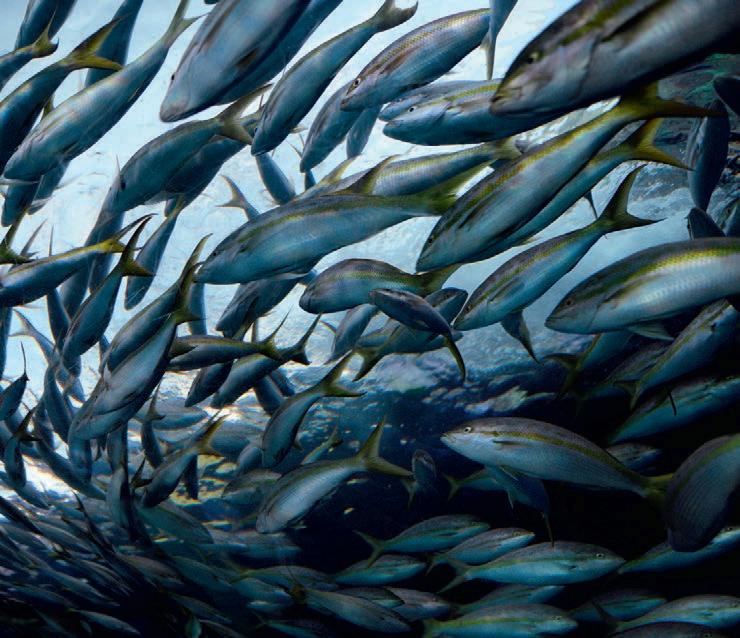
Contact us!
Call +46 (0)40 42 95 30 or visit www.hydrotech.se


PROXIMAR eafood has sold the first salmon from its ount u i facility straight into the apanese market. This achievement for the company also marks the first harvest in apan of domestically produced farmed salmon. oachim Nielsen, of ro imar eafood, declared “The completion of the first commercial harvest is marking an operational and commercial pivotal milestone.
“ ro imar is the only supplier of domestically produced Atlantic salmon in apan, years ahead of competition.”
e added “We have since ctober 0 proven great production capabilities and fish growth, and I am now immensely proud to see all the hard work from our e cellent team being commercially validated through the first harvest.”
There was strong interest in the sale with the fish fetching attractive prices. The harvested salmon averaged kg head on, gutted with 00 superior quality, and ro imar confirmed the price achievement aligned with the company’s e pectations
of premium prices compared to the import price to apan of Norwegian Atlantic salmon. Nielsen said “ ur Atlantic salmon shows high quality and based on the feedback from our partners and others, I am confident that we are providing apanese consumers with a longed-for local product with unparalleled freshness.
“The harvested fish will be shipped to customers in the reater Tokyo region. This was a trial harvest of appro imately . tonnes, to confirm that all equipment and processes work smoothly. ro imar plans to initiate daily harvesting in late ctober.”
ro imar is also releasing a new brand name and logo “ u i Atlantic almon”. This trademark will be used to build ro imar’s brand in apan and Asia, positioning the company as the market leader of apanese-produced Atlantic salmon to Asian consumers.
“ ount u i is an iconic landmark in apan, and the area is known for high quality water resources. The location of ro imar at the foot of ount u i is believed to have a positive value in terms of marketing and branding, not only in apan but also in the entire Asian region,” Nielsen said.
NORDIC Aqua Partners, the Norwegian company operating a land-based salmon farm in China, has raised the equivalent of another £25m in capital.
Nordic Aqua Partners produces salmon at Ningbo near Gaotang in eastern China and successfully completed its first harvest six months ago, with the first operational harvest of 523 tonnes following a few weeks later.
But in late July the company was forced into a surprise cull after detecting a high concentration of the off-flavour compound geosmin, which is harmless to both fish and humans but can affect the taste of the salmon.
On 26 September, Nordic Aqua Partners confirmed the issue of 4.676 million shares at a price of NOK 75 (£5.39) which brought in a total of NOK 350m (£25m).
The company said: “The net proceeds from the private placement will be used to, together with indicative debt financing and cash on hand, (i) to fully fund the estimated Stage 2 build out, (ii) to repay short-term debt facility, (iii) for Geosmin improvement capex, (iv) towards working capital build up and (v) for general corporate purposes.”
Nordic Aqua is actively focusing on building market
distribution and brand exposure in the current phase. It is particularly prioritising the establishment and development of lasting customer relationships in important premium segments, in order to optimise the value achievement of its premium product, Nordic PureAtlantic.
Located in Ningbo, China, Nordic Aqua describes itself as the first local producer of truly sustainable and super-fresh Atlantic salmon to the Chinese market.

SALMON production is forecast to grow by 3.5-4.0% in 2025, resulting in a slight decline in spot prices for the full year, according to the latest research from market research firm ontali.
This growth, the firm says, is driven largely by a recovery in Norwegian and uropean productivity.The difference in price achievement between the first and second half of 2025 is expected to be around €3 per kg (£2.53).
In terms of volume for 0 , Norway’s will increase by at least 0,000 tonnes Whole ish quivalent W and the rest of urope by at least ,000 tonnes W , the ontali forecast predicts.
This pro ection for 0 comes on top of an increase in harvest volumes for 0 o for aroe Islands, Iceland, Norway, and the . emand from high-value food-service segments such as sushi restaurants in urope, North America, and Asia hina and ong ong has recovered strongly following the ovid- pandemic and continues to support high prices in the first half of 0 .
owever, the regulatory regime ma imum allowable biomass and sea temperatures will determine final production levels. loser to 60 of global volume is e pected to be harvested and sold in the second half of 0 , with retail as the primary end-sales channel to consumers. or producers, value growth in 0 is anticipated to be driven by increased volumes, particularly through retail promotions and campaigns for farmed salmon, rather than higher spot prices.

THE big Chilean salmon farmer Nova Austral, which fought back from the brink of bankruptcy earlier this year, is continuing to remain positive.
Publishing its 2024 second quarter report, the company said that although prices experienced a downward trend in the April to June period, they were still expected to remain higher than the general market due to contracts that had been agreed earlier.
evenues were down by to . m 0. m due to a smaller harvest but the gross loss however fell by 00,000 to . m . m .
Nova Austral’s Trim prices at the end of June 2024 were 6 above the rner Barry prices. Urner Barry is a renowned business publisher which specialises in accurate and unbiased reporting of food related market information.
uring the period, ,000 smolts were delivered, with ,000 of them stocked in Nova Austral sites and 330,000 sold to third parties.

The company said there were no extraordinary mortality incidents experienced during the last months.
The company had six farm sites operating and planning to stock three more farm sites before the end of the year.
On sales, the company said it was continuing to focus on value added products, with the United States and Europe expected to remain its main ob ective markets. It said the strategic focus will be on fresh products and frozen portions.
A salmon and a rare breed of skate can co-exist around Tasmania, new data has shown.
Last year there were calls to the authorities for aquaculture on Australia’s southern island province to be scaled back due to fears about the future of the Maugean skate.
But the latest information is that the Maugean skate population has not only stabilised but there are as many uveniles in acquarie arbour now as there was 0 years ago.
The highly respected Institute for Marine and Antarctic Studies research found that the population of the skate stabilised in 0 , with no overall further decline in the three years since.
It also found an increased presence of young Maugean skates back to 0 levels, and labelled the findings a “positive sign” and a “ray of hope” for the future of the skate.
Salmon Tasmania CEO Luke Martin said the new IMAS research, coming on top of other data indicating water conditions had recovered to the best levels in over
a decade, confirmed it would be a very unreasonable response by the ederal nvironment inister Tanya Plibersek to consider shutting down salmon aquaculture in Macquarie Harbour.
“As an industry we have never shied away from concerns about the Maugean skate, and indeed we have invested heavily in the scientific research and analysis that is now shaping the conservation response to ensure the future of the species in Macquarie Harbour.
“We have also consistently said we expect all regulatory decisions made about our industry’s presence in the harbour to be based on science, and not political agendas, or in response to pressure from single-minded activist groups.”
e continued “Today, we have further science that confirms the Maugean skate population stabilised three years ago and that the number of uveniles is at a decade high,” Luke Martin said.
“This follows science from the independent EPA last week

Above: Fish farm, Macquarie Harbour, Tasmania
that showed the oxygenation of acquarie arbour is the best it’s been in more than a decade.
“The science irrefutably shows that the skate and the harbour are on the improve, all while salmon aquaculture continues.
“It confirms the adaptive management approach adopted by regulators, with the full cooperation of our industry, is working and can
continue to support an industry presence in the harbour that is so critically important to the economic and social wellbeing of the local community. “
artin added “We also e pect other stakeholders in Macquarie Harbour, particularly Hydro Tasmania, to step up and share responsibility for the long-term management of the harbour.”

anuary to uly 0 , cumulative fishmeal production increased by almost 6
compared with the same period in 0 , according to the latest update from the marine ingredients organisation I . This, I said, was due to a significant year-on-year increase of the eruvian supply after a productive first fishing season of 0 in the North- entre of eru. ish oil’s global cumulative output through uly 0 was appro imately 0 higher year-on-year.
a iet a ese fish far s estro e as t hoo agi ta es its toll
Typhoon agi, as it has been called, swept through parts of southern Asia in recent days tearing up aquaculture and fishing facilities. The damage is estimated to be at least 0m m with some businesses likely to find it difficult to recover. According to local reports many small fish
farming businesses have been left with little but a great deal of debt, with their livestock and facilities all but wiped out. ietnam’s eputy inister of Agriculture and ural evelopment hung uc Tien said the storm has had a severe impact on aquaculture and livestock farming.

COOKE eafood’s A division is celebrating 0 years of aquaculture operations in the state of aine. The group has more than 00 employees in the east coast state which is now arguably the most important salmon farming area in the .
roup lenn ooke said “We have many long-term employees who have been with us from the start, and we thank them for their dedication and are grateful to all those who have oined us over the years to grow a sustainable local business.”


THE anadian ederal overnment has finally published its transition plans to end open pen farming in ritish olumbia.
The move comes almost five years since the government first said it would formulate a transition policy. It then said in une that a scheme was on its way but that it was further delayed.
The plan outlines how the government intends to move forward with support for irst Nations, communities and workers that depend on the industry.
It says its aim is to make ritish olumbia a world leader in “innovative and clean aquaculture technology”.
The ttawa government has come under strong criticism from the industry and some irst Nations groups who want traditional salmon farming to remain.
ther irst Nations groups support the government, claiming that open pen farming is a threat to wild salmon on which they depend.
The almon armers Association, which represents more than 60 businesses, said at the weekend it had received the draft transition framework and would now take the necessary time to review it.
Its statement continued “ ur sector has submitted thousands of pages of documentation to the federal government to show its commitment to this process, and our hope is that these efforts are reflected in the draft transition framework.
“ owever, we continue to stress that the timeline for the transition to closed containment by 0 is unrealistic, unachievable and risks significant negative impacts on our sector and the communities that depend on it.
“We remain committed to evolving responsibly in partnership and or agreement with irst Nations in whose territories we operate to enhance wild salmon recovery efforts, support self-determination and the path of reconciliation with irst Nations, reduce any potential risks from farming, foster economic growth in rural and coastal communities, drive technological innovation and development, and build a thriving lue conomy in .”
It added “We will have more to say in the coming days as we review the draft transition framework in more detail.”
FLORIDA-based salmon farmer
Atlantic Sapphire has reported a much brighter picture for production during the third quarter of this year.
The company processed 1,300 tonnes against 365 tonnes during the July to September period 12 months ago when temperaturerelated challenges resulted in slower growth.
Atlantic Sapphire said that the harvest weight had increased during the quarter, as the standing biomass had been adapted to the current, more limited feeding capacity during the quarter.
During Q3, the statement said, biological development progressed favourably with stable water quality and temperatures, low mortalities, and increased harvest weight throughout the quarter following the operational measures taken to
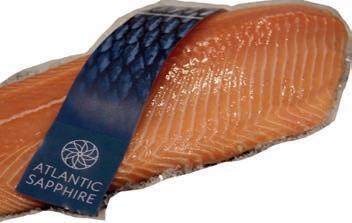
increase harvest size.
The realised average harvest weight was 1.42 kg (head on, gutted) in July, and 1.55 kg (HOG) in August, and 2.19 kg (HOG) in September.
Atlantic Sapphire expects further increased average harvest weight in the fourth quarter this year.
CEO John Andreassen said in the company’s annual report that the first part of a “challenging” year had been focused on resetting the biofilters, which he described as “an enormous task” as the company had to continue fish farming at the same time.
NEW Zealand is planning to move into commercial kingfish farming as part of a plan to further develop its growing aquaculture sector.
The southern hemisphere country is already a major producer of salmon but it sees this high value white flesh species, which is becoming increasingly popular in Europe and the US, as an important addition.
The research body NIWA (National Institute of Water and Atmospheric Research) says such a move is now a reality for the country.
The kingfish are grown at NIWA’s state-of-the-art land-based farm, which was officially opened last month.
The facility at NIWA’s Northland Aquaculture Centre in Ruakākā, North Island, has been designed to demonstrate the commercial viability of landbased aquaculture, and it can produce up to 600 tonnes of kingfish each year.
NIWA’s Chief Executive, John Morgan, said the farm introduces a new species to help New Zealand meet the huge global demand for seafood, and it will help the industry reach its ambitious target of NZ $3bn (£1.4bn) by 2035.
The RAS is a joint venture by NIWA and the Northland Regional Council, which constructed the premises that are leased to NIWA, and it represents a significant investment in North Island’s economy.










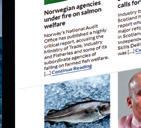

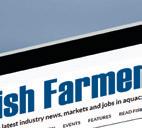


























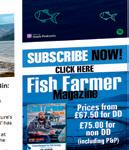





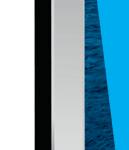


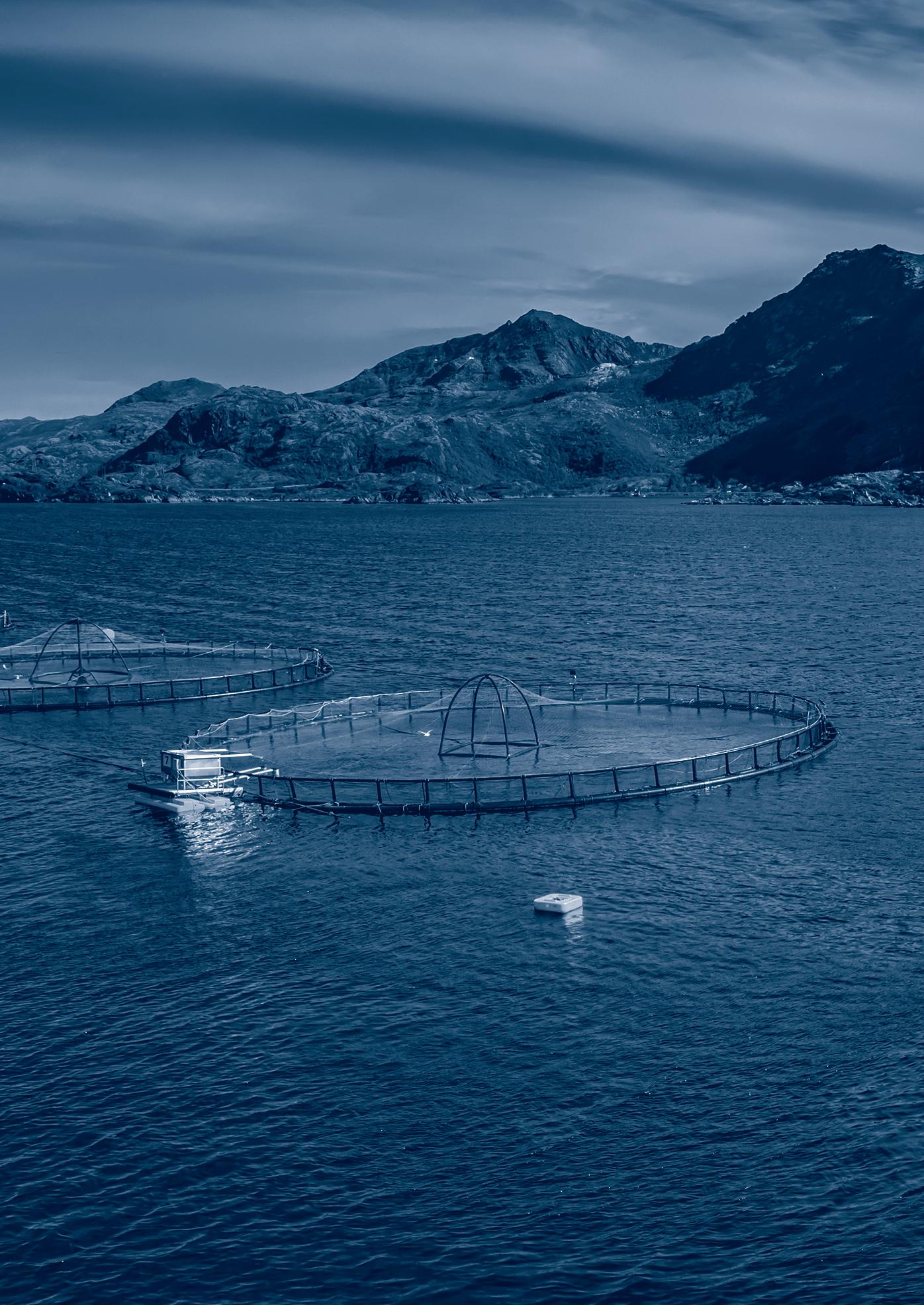






INDUSTRY body Scotland Food & Drink has revealed the finalists for its pilot Bookable Food and Drink Experiences training programme.
The companies involved include a shellfish farmer, Caledonian Oyster Co, and two seafood suppliers: Isle of Bute Smokehouse and The Tobermory Fish Company.
The programme, designed to help Scottish producers make their experiences more easily discoverable and bookable for both international and domestic tourists, has been oversubscribed, attracting far more than the 50 businesses initially sought and reflecting the growing awareness among Scotland’s food and drink businesses of the crucial role tourism plays in their future growth and success.

Participants will benefit from tailored workshops and expert-led training that will help them capitalise on Scotland’s booming tourism sector, which continues to thrive as both a domestic and international destination.
A group of 50 businesses have been selected for the first round of training. Each of these businesses will participate in a series of workshops, networking events and one-on-one mentoring aimed at refining their tourist offerings and making them more accessible.
Led by Scotland Food & Drink on behalf of the food tourism leadership group, which includes VisitScotland, the Scottish Government and the Scottish Tourism Alliance, the programme builds on insights from the national tourism organisation’s Scotland Visitor Survey 2023, which revealed that nearly half
(46%) of visitors engage in food and drink activities during their stay, with nearly a fifth (19%) of long-haul travellers specifically choosing Scotland for its culinary offerings.
Fiona Richmond, Head of Regional Food at Scotland Food & Drink, commented: “We are absolutely thrilled with the overwhelming response from businesses across Scotland. The level of interest truly highlights how integral food and drink tourism is to the future of our local businesses. This programme is designed to provide them with the tools, training and confidence to enhance their offerings, reach new audiences, and help build Scotland’s reputation as a must-visit destination for food and drink lovers.”
Sally Swinbanks, from Tobermory Fish, added: “This is an invaluable opportunity for us to not only develop our offerings but also to connect with like-minded businesses and share ideas.
“As Scotland continues to grow as a tourism hotspot, both domestically and internationally, it’s crucial that we understand how to tailor our services to meet the needs and expectations of visitors, particularly in the food and drink sector.”
“We are absolutely thrilled with the overwhelming response ”
SALMON producer Mowi has denied that its Scottish processing plant was responsible for an apparent pollution incident in the River Lochy, near Fort William.
On 29 September, local people noticed what appeared to be blood and fish scales, as well as a number of dead fish, in the river, coming from a waste pipe at the Lochyside flood defences.
BBC News quoted activist Jamie Moyes, who campaigns with the group Abolish Salmon Farming, as saying the incident was “nothing new” and locals see blood in the river “all the time”.
Mowi’s processing plant at Blar Mhor is situated nearby. The company has responded in a statement that declared: “Mowi has undertaken its own investigation into the incident at the River Lochy where local people reported a red discharge. Mowi is confident that the discharge did not come from its facility at the Blar Mhor Industrial Estate.
“Mowi has checked all its operating procedures as well as the effluent system and CCTV. The effluent is cleaned onsite by a water treatment process that removes contaminants from water. Following this process, the effluent is only discharged to the Scottish Water treatment works at Caol Point.
“Mowi is not the only business which processes this type of
material on the Blar Mhor Industrial Estate but is the only one regulated by SEPA under IPPC regulations.”
The Scottish Environment Protection Agency and Scottish Water are investigating the incident and Mowi said the company would co-operate with the authorities in that process.

CENSEA , a Captain Fresh group company, has announced the appointment of Peter Schonman as National Culinary Director, a newly created role designed to spearhead innovation and new product development within the company.
Peter Schonman joins CenSea with a diverse and accomplished career in the culinary field, most recently serving as Corporate Executive Chef and Sales Manager at Pasta Montana.
He spearheaded culinary ideation, menu development and educational support, significantly contributing to the company’s year-over-year sales growth and earning Pasta Montana a place among Sysco Canada’s “Top 10 Suppliers of the Year” for two consecutive years. Prior to Pasta Montana, Peter was Director of Culinary Innovation at Anova Food (a subsidiary of Bumble Bee Foods).

CenSea is one of the largest importers and distributors of frozen seafood in the US. Early this year, the 60-plus-yearold company was acquired by Captain Fresh, a tech-led vertically integrated global powerhouse of seafood brands.

JAPANESE seafood conglomerate Hanwa Kogyo has taken a controlling stake in seafood processor Marugo Fukuyama Suisan. Marugo, based in Wakkanai City, Hokkaido, Japan, freezes and processes seafood caught in northern Hokkaido, such as scallops, salmon, hairy crabs and giant octopus. Scallops make up the biggest proportion of its business.
Its latest recorded accounts, for 2023, show revenue of JPY 3.8bn (about £19m)
Hanwa Kogyo now owns 80% of Marugo Fukuyama Suisan.
Hanwa said: “By incorporating Fukuyama Suisan into our food division, we believe that we will be able to strengthen the processing capabilities that are the strengths of our existing group companies and further promote sales to overseas markets such as North America and ASEAN, thereby creating synergy effects throughout the food division.”





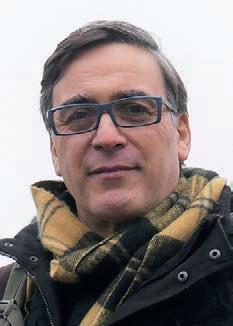









IHAVE always been sure that it was unnecessary for Scottish Ministers to appoint a regulator to manage sea lice. As the weeks go by, I am also increasingly convinced that the appointment of SEPA to this role was a major mistake. Having watched their efforts from the outset, I firmly believe that SEPA have little understanding of sea lice and the interactions with wild fish. I suspect that SEPA have simply listened to a narrative promoted by Scottish Government scientists based on mathematical modelling and have adopted the narrative as their approach to regulation but, critically, without any real understanding of what it means.



Dr Martin Jaffa argues that the methods being used to estimate sea lice numbers are expensive – and unreliable


world. If sentinel cages were such a good method for predicting sea lice infestation, then why have they not been in regular use?
The last time they were employed in Scotland was over 10 years ago and over a period of three years, these sentinel cages did not provide a shred of evidence that modelled infective sea lice larvae caused any threat to wild salmon during the key migration window. This has not deterred SEPA from pursuing this approach.
The regulation is based on a sea lice dispersal model which assumes that sea lice found on farms will produce millions of infective larvae which are dispersed away from the farm, infesting all the fish they subsequently encounter. Unfortunately, they have been unable to validate their model because so far no-one has ever found the clouds of sea lice larvae predicted by their or anyone else’s sea lice dispersal model. Instead, the salmon industry is to be regulated based on the outcome of a theoretical model.
The Scottish Government has collected masses of data on wild salmon and sea trout since the beginnings of the salmon farming industry. This data provides clear evidence that salmon farming is not the reason why wild salmon and sea trout numbers have collapsed. SEPA are not interested in this data because of their failure to understand such interactions.
SEPA plan to validate their model by using sentinel cages. However, sentinel cages will never validate the model because the infective stages that the model predicts do not exist in the real





Sentinel cages are small, enclosed net pens which are stocked with up to 50 farmed salmon smolts and left tethered to the seabed in key locations. After a prescribed length of time, the cages are recovered and the numbers of lice on each fish counted. If sea lice are found on the fish, then the presence of a salmon farm is blamed even though the infective lice larvae have never been recovered in large numbers from the surrounding seas. The possibility that any lice are the result of transfer from passing wild fish is dismissed out of hand because the model says otherwise.
Back in March, SEPA’s Head of Ecology, Peter Pollard, had told the audience at the Fisheries Management Scotland Conference: “We now have got a grant funding arrangement with the Institute of Marine Research [IMR] in Norway, and they will be working alongside us on the sentinel cage work.”
This leads to the obvious question: why does SEPA need to work with IMR on sentinel cages? Certainly, Marine Directorate scientists have used sentinel cages previously, with the biggest study running for three years from 2011 to 2013 in Loch Linnhe. The data from that study was used in the more recent SPILLS project involving scientists from the Marine Directorate, Scottish Association of Marine Science and from some salmon farming companies. If sentinel cages were considered such a key indicator of lice infestation, why were they not deployed as part of the SPILLS project especially as the project concerned salmon parasite interactions?
Turning to Norway, IMR still uses sentinel cages as part of the Traffic Light System assessment but interestingly not across all 13 Production Areas (POs). In fact, last year, it deployed sentinel cages in just two of the POs, which suggests that their value is extremely limited. If sentinel cages were considered a key part of the assessment process, then surely IMR would deploy them in every PO, and it doesn’t. The most effort it has employed to utilise sentinel cages was in 2017 and 2018 when they were installed in seven out of the 13 POs but by 2020, the number was reduced to just one. For the last three years, IMR has deployed sentinel cages in two of the POs but not always the same two. IMR clearly does not consider sentinel cages to be an integral part of the assessment process, yet SEPA does.




Whilst SEPA see sentinel cages as an important tool in validating their model, they are obviously not very confident how this should be achieved which is why as Peter Pollard told the FMS conference, SEPA have a grant funding arrangement with IMR to seek its advice.
Of course, the obvious question is what this grant funding arrangement is and to answer that a Freedom of Information request was submitted.
The official response stated: “The recipient of the grant from SEPA to develop an international standard for sea lice monitoring is the Institute of Marine Research in Norway. The grant value is £200,000.”
The infective stages that the model predicts do not exist in the real world
I had to read this more than once to make sure I was not reading it wrong. SEPA are paying IMR £200,000 to help develop a sentinel cage strategy to prop up their already weak sea lice framework. SEPA say this is to develop an international standard but as SEPA operate just in Scotland, why do they need an international standard?
It should also be remembered that if sentinel cages were such a good measure of sea lice infestation, then why have the Marine Directorate not continued a programme of sentinel cage monitoring rather than just fund the wild fish trusts to assess lice numbers on a few fish they catch?
However, SEPA’s willingness to splash the cash when it comes to regulating salmon farming does not stop with sentinel cages.
In his presentation to the FMS conference, Peter Pollard also stated: “We’ve also just awarded a big grant to develop a new model, a better model for Shetland and parts of the West Coast.”
SEPA’s response to the FOI included reference to this project: “The recipient of the grant from SEPA to extend and improve sub-area models of the Scottish Shelf Model, is the National Oceanography Centre. The Scottish Shelf Model is held by Marine Directorate and made available as an open service to support development in Scottish coastal waters. The grant value is £400,000.”
I had mentioned that the only area SEPA appear to be confident about was their modelling, yet they appear to be willing to spend £400,000 trying to improve the model as well as extend it to include the Northern Isles. I am left wondering how much confidence SEPA have in any part of the framework. Certainly, there are questions as to why SEPA want to extend the framework to include the Northern Isles.
The Scottish Government’s own catch data shows that there is no data recorded for Orkney despite the well-publicised activities of the Orkney Trout Fishing Association. By comparison, there is a record for fishing in Shetland, although this is mainly for sea trout as salmon hardly feature in the catch record. Shetland sea trout catches since 2000 are shown in the following graph and as can be clearly seen, are not affected by the presence of salmon farms.
Instead of rushing to spend £600,000 on the sea lice framework, SEPA might want to consider talking to those people in Scotland who possibly know more about sea lice than the official regulators appear to know.


Salmon Scotland chief executive Tavish Scott reflects on a recent visit to the Faroe Islands and the geopolitics of the seafood economy
THE Faroese economy depends on seafood, reminding me of home in Shetland.
At the end of September, my opposite numbers from Canada, Norway, Chile, Iceland and Ossur from Faroe all met in Tórshavn.
We discussed the opportunities for seafood in an ever-growing worldwide population with an insatiable appetite for protein.
How will the world be able to produce sustainable food for a global population projected to grow by 10 million by 2050?
The obvious and only answer is seafood. Consumers will not allow the destruction of the Amazon rainforest to allow large scale cattle ranching, nor will people accept other forms of production that cannot meet sustainability criteria or metrics on CO2 emissions.
On the other side of the debate, consumers will not wear the hypocrisy of green politicians or anti-protein campaigners who claim that they alone want to protect the planet.
Here is the reality: China buys resources including food from wherever. It also produces food with standards that would not necessarily accord to the level that consumers here take for granted.
And China is by no means alone. The Ukrainian war has
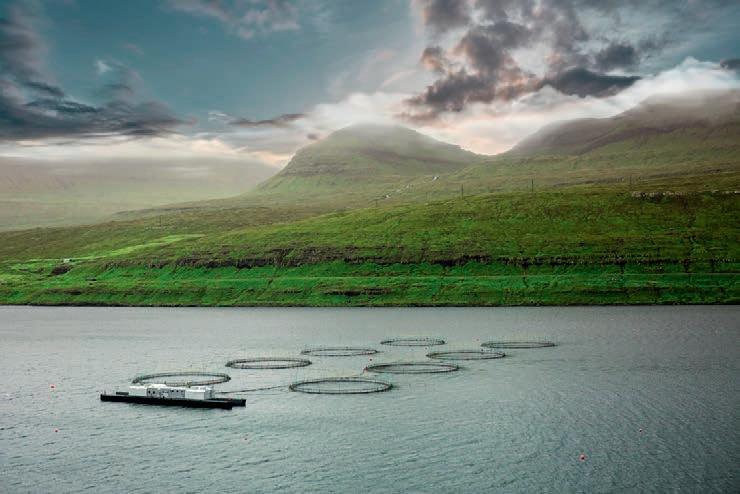
disrupted trade to eastern Europe, Russia and other nations that are keeping close to Moscow for geopolitical reasons, such as an arms deal or some such equivalent. That means for all the pious talk in various international capitals by presidents and prime ministers, international trade continues.
So given an imperfect world, what is the position back at home? The Faroes provides a striking contrast to the ambivalent attitude towards business from the Scottish Government and Scottish Parliament.
Islands with a pride in seafood
I flew into VágarAirport on a bright, sunny day; the Airbus A320 banked hard left over the mountains and down the fjord. Ewes appeared out of the starboard windows, and we landed on a runway first built by 6,000 RAF staff in the Second World War.
Salmon farming is at the heart of the modern-day Faroese economy.
As much as 95% of the islands’ exports are seafood, and salmon is more than half of that.
We spent a day with Bakkafrost on its feed business, a hatchery at Strond near Klaksvík, and then with CEO Regin

Salmon farming is at the heart of the modern-day Faroese economy


Jacobson at the company’s headquarters based around a processing facility exporting 6kg fish to China.
The Faroes embrace business innovation, success and are proud of what seafood brings, means and is to the country’s economy.
Klaksvík is a town of around 6,000 people:
a seafood town a little smaller than Lerwick, while the Faroes have 55,000 people across 18 inhabited islands.
The latest tunnel – all 11km of it – was completed in 2020 between the capital Tórshavn and Eysturoy. It is economically transformational, allowing salmon, fish and everything else to cut journey times. Just what Shetland and other Scottish islands need but seem so far from achieving.
Amid a successful pelagic fleet, salmon farming is evolving and growing; every Faroese salmon farm site has moved in the last 15 years.
A policy based on environmental and economic criteria has adapted to the needs of a modern sector. But in Scotland the opposite is true. Despite the independent Griggs report of February 2022 saying that fish farms should move, the consenting and planning system has not moved one inch.
Faroes is a good place to consider feed
Rich fishing grounds are on the doorstep; the local pelagic industry catches blue whiting to be used in fish feed.
While the marine content of Faroeseproduced feed has declined, it is still notably higher than elsewhere as my colleagues from across the globe observed.
As the Faroese point out, fish taken from
an internationally negotiated quota that is managed as a sustainable fishery is the right thing to do.
The alternative would be to import raw material produced elsewhere. The sustainability of that option is not attractive.
The continuing war in Ukraine, which shows no sign of ending, has been a disrupter of fish feed ingredients just as it has slowed the availability of grain to countries dependent on that. Bakkafrost’s feed company demonstrated that all plant proteins and oil is non-GMO, while soybeans are certified, and there is no use of palm oil nor any use of ingredients that would be grown in areas threatened by deforestation.
When there can be a reasoned discussion about marine content, based on fish performance and biology, certification and sustainability criteria, then we can move forward.
But where the debate dips into black and white – marine content good or bad, then it is more challenging.
The EU and coastal states around the North Atlantic are in the middle of pelagic quota negotiations.
As if there are not plenty of issues to deal with at a domestic sea farm level, keeping an eye on the geopolitics of fish matters too. Especially in Tórshavn.






WILDER Humber, an ambitious five-year conservation programme to restore marine habitats and species throughout the Humber estuary, will see more than £2.5m invested to enable the planting of saltmarsh and seagrass to provide nutrient-rich habitats ideal for wading birds, plus the introduction of half a million native oysters (Ostrea edulis) to create a biogenic reef.
The project is a partnership between Lincolnshire Wildlife Trust, Yorkshire Wildlife Trust, and international green energy leader Ørsted.
According to Wilder Humber, 95% of native oyster reefs have disappeared from the estuary since the early 1900s, due to overfishing, poor water quality and disease. Records suggest that one historic oyster reef spanned over 300 acres, but today, native oysters are fragmented and isolated which hinders their natural recovery.
The native oyster is known as a particularly vulnerable species. It is characterised by a slow growth rate and sporadic recruitment success, resulting in a large variation in the number of oysters surviving to maturity year to year.
It is hoped that by creating a reef through the introduction of native oyster larvae, the restoration project will provide a critical habitat for commercial fish species, protection from coastal erosion, a reduction in nitrogen levels, and an overall improvement of the water quality in the estuary through the filtering action of the animals.
Oysters are being provided by the Oyster Restoration Company, which will trial a remote setting method for the first time on a restoration project in the UK, in collaboration with The Nature Conservancy. Remote setting is a technique for setting oyster


spat from larvae in the field, rather than placing juvenile and adult oysters directly onto the seabed. It is common practice in commercial Pacific oyster Magallana gigas hatcheries.
At the company’s hatchery in Aultbea, Scotland, adult oysters will be induced to spawn, resulting in the production of millions of larvae. The next step is to transport the larvae to Spurn Point National Nature Reserve in Yorkshire, where they will be put into tanks filled with scallop shells.
Over three days, the larvae will undergo metamorphosis and attach themselves permanently to the shells.
The oysters will then be monitored at a nursery until they are ready to be released

This innovative approach allows us to produce oyster larvae closer to their eventual home
into the Humber estuary to grow into adult oysters.
It is anticipated that if successful, this project could point the way for future native oyster restoration efforts in the UK and Europe.
“This innovative approach allows us to produce oyster larvae closer to their eventual home, minimising stress and improving survival rates,” Dr Nik Sachlikidis, CEO of The Oyster Restoration Company, explains.
Oyster restoration in Essex
As oyster restoration projects gather momentum across the globe, there is need for a greater volume of cultch, the material laid down for oyster spat to settle onto. Lack of availability of suitable seabed substrate is one of the biggest barriers to oyster restoration and holds back the UK’s capability to build new oyster reefs.
Shore” circular oyster recycling scheme that aims to address this challenge. Shell to Shore’s solution is to collect waste oyster shells from restaurants in London and make them available for use as cultch to native oyster restoration projects, initially in Essex, then to others in the wider UK. A secondary benefit of this project is that it will reduce the amount of shell waste going needlessly to landfill.
The self-funding project will be trialled this autumn with seafood restaurants in London. This follows a scoping study to determine project feasibility, restaurant interest and likely shell volumes. Matt Uttley, Blue Marine’s Restoration Project Manager, says that responses have been “extremely positive.”


Shells are the ideal substrate, whether scallops or oysters, but unfortunately, a great deal of the most suitable material has been lost from the marine environment. However, the Blue Marine Foundation (also known as “Blue Marine”) has just set up a “Shell to

Seafood wholesaler Wright Brothers, which supplies more than 200 restaurants in London, will arrange to supply the oysters and uplift the shells, which restaurants will collect in sealable barrels.



Once full, the barrels will be transported to Wright Brothers’ holding facility at Billingsgate Market, for onward transport to Essex Native Oyster Restoration Initiative (ENORI), in conjunction with Essex Wildlife Trust.
“To prevent any risk of transferring a
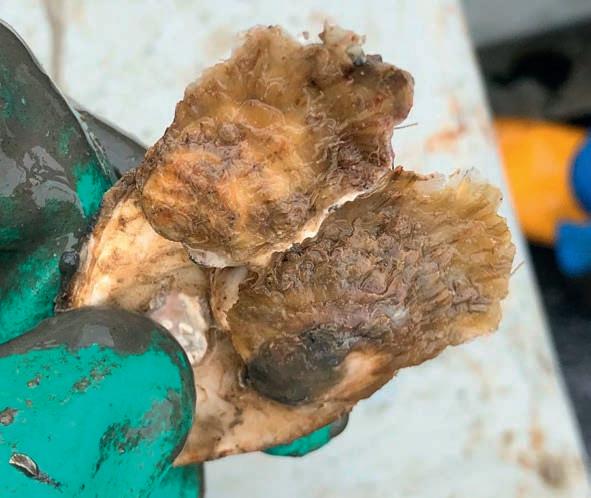
disease or invasive species back into the marine environment, the shells have to be weathered in the open air for a minimum of six months and ideally 12,” Uttley advises. This practice has been used by ENORI since 2019, using shells purchased from large scale food processors. The move to using shells recycled from restaurants will significantly reduce the cost of the restoration project.
Shell recycling initiatives are commonplace in the USA and Australia, in, for example, the Billion Oyster Project. Shell to Shore has borrowed its protocol for curing the oysters, which so far, has ensured that all bacteria and non-native species are eliminated.





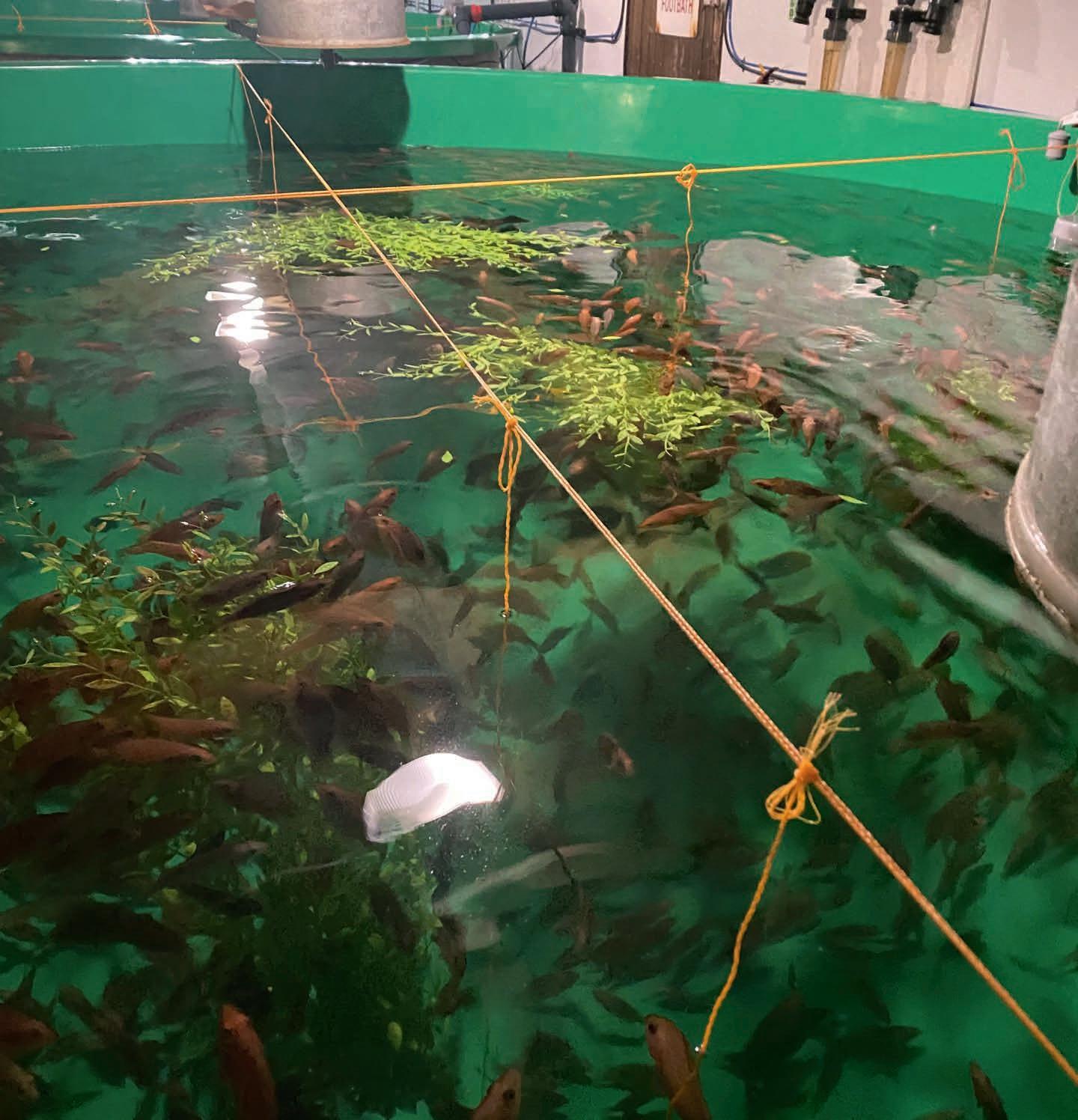
OTTER Ferry Seafish, based on the shores of Loch Fyne on Scotland’s west coast, has a history of succeeding through a process of reinvention.
Starting as a trout farm in the 1960s, Otter Ferry moved on to salmon in the 1970s and 1980s, becoming focused on broodstock and ova production rather than grow-out. In the 1990s Otter Ferry added halibut to its repertoire, and still functions as a halibut hatchery, although its dedicated farm, Gigha Halibut, has now closed.
Otter Ferry now grows halibut juveniles for a farmer based in Norway, but in principle there is still an interest in halibut farming in Scotland – if the right site can be found, says Managing Director Alastair Barge.
Over the past decade or so, Otter Ferry has also become a specialist in cleaner fish breeding, and still produces wrasse to help the salmon industry control sea lice numbers.
The latest chapter in Otter Ferry’s story, however, involves a collaboration with the

UK Agri-Tech Centre, an innovation body supported by the UK Government which was created through the merger of several related organisations, the Centre for Innovation Excellence in Livestock (CIEL),
The expertise at a long-established fish farm is now being put to use in a collaboration aimed at benefiting the whole industry
Crop Health & Protection (CHAP) and the Agri-EPI Centre, in April this year.
The deal makes use of Otter Ferry’s undoubted expertise in the marine sector to create the Marine Aquaculture Innovation Centre (MAIC), a facility dedicated to research and development in the aquaculture industry.
The UK Agri-Tech Centre’s role is to provide expertise, advice and specialised assets and facilities for the UK’s agricultural sector – including aquaculture.
In terms of aquaculture, key areas of interest for the UK Agri-Tech Centre are:
• Resilient production systems for a changing environment;
• Technologies to reduce and mitigate carbon/GHG emissions;
• Innovations enabling enhanced control of pathogens and parasites;
• Production methods that improve aquatic biodiversity;
• Effective adoption of advanced genetic improvement techniques; and
• Implementation of measures to improve the welfare of farmed aquatic animals.
Collaborative projects currently underway include “InSuRAFeed”, with Pontus Group, which is aimed at developing viable feed ingredients sourced from the UK and with a lower carbon footprint than conventional animal and aquafeed, and a plan to develop an alternative protein source for poultry feed based on cultivated macroalgae from Seaweed Generation.
The collaboration with Otter Ferry began with the establishment of a trials facility at Otter Ferry in 2021, supported by the former Agri-EPI Centre. The centre’s Aquaculture Adviser Robin Shields worked with the Otter Ferry team to develop the site’s existing capabilities.
The venture, co-funded by Innovate UK, provides much-needed capacity for developing innovative production technologies for diverse marine aquaculture species, including salmon to near market size. The facility is configured to undertake a wide range of studies, such as evaluating feeds and pharmaceuticals, instrumentation testing and validation of operational welfare indicators.
The MAIC trials facility comprises six 20m3 and 12 2m3 aquaculture rearing tanks, equipped with programmable lighting, automatic feeding, and oxygen and pH monitoring systems. All tanks are supplied with filtered, UV-disinfected seawater, with waste feed collectors fitted to the outflows. The facility is suitable for rearing diverse species including fin fish, shellfish and seaweed.
To date, combined set-up and funding costs have totalled around £500,000.
Otter Ferry Managing Director Alastair Barge explains: “We have always been doing R&D as part of our commercial development. Every species [that we have worked with] has involved commercial trials, and we have also done some external research.”
He met with representatives of the former Agri-EPI Centre, who were looking to encourage more research in aquaculture.
Barge says: “For a relatively small investment, we managed to put in place a unit which can take fish from any size up to market size, in a controlled trial situation.”
By the end of 2021 the new unit was installed. The first trial involved wrasse, but the facility soon moved into salmon. It is also capable of handling other species, including shellfish and seaweed.
The set-up is ideal for the evaluation of diets and nutritional















trials. It has also run trials on vaccination response, health diagnostics and imaging technology.
One thing that the unit will not undertake, however, is disease challenge trials – even with high levels of biosecurity, the facility is not configured to deliberately introduce dangerous pathogens into any part of the system.
The UK Agri-Tech Centre, as successor to Agri-EPI Centre, has invested in more equipment including advanced monitoring systems, waste collection and treatment and temperature control.
The facility now deploys: programmable LED lighting to all tanks; individual, programmable auto-feeders; alarmed oxygen delivery to all tanks; CCTV monitoring of individual tanks; and waste feed collectors for all tanks (outflow).
Barge says: “It’s been a great marriage. UK Agri-Tech Centre’s professionalism has married with our practical nature.”
It’s been a great marriage
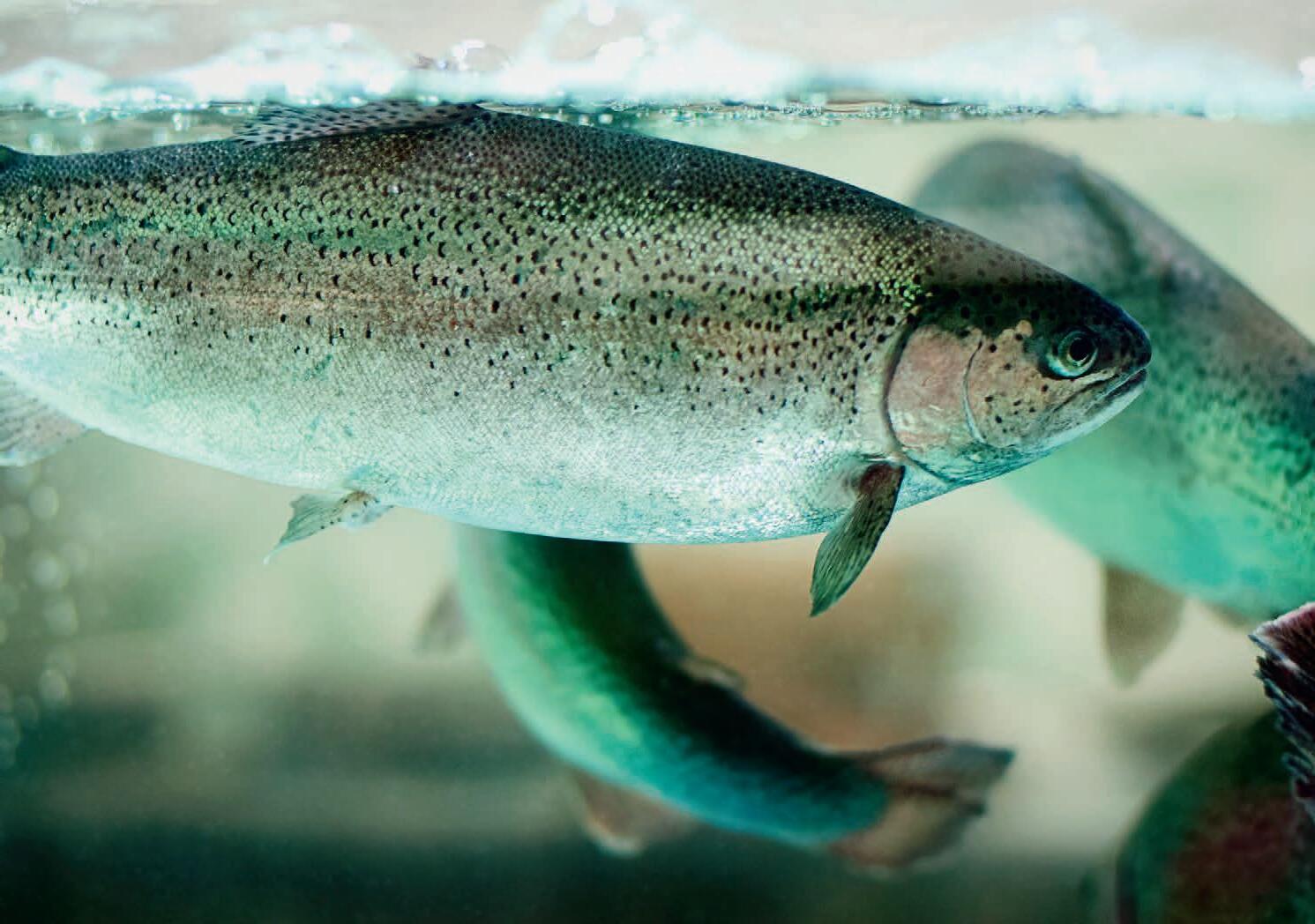




Trout producers in the UK and around the world are confident that they have a great story to tell
OLIVER Robinson, Chief Executive at the British Trout Association (BTA), is upbeat about how things have been going for the industry this year.
He says: “Things are looking good. The restocking market is very positive, with high demand. The sector has managed to increase some prices and we are seeing some cost recovery which is great news for restocking.
“Generally throughout the table market demand has been very strong. There are concerns of cheaper trout from Europe being offered to the UK market which poses a threat to UK trout farmers trying to achieve a stable price and cost recovery. At the BTA, we are getting enquiries from people looking to buy trout.”
Another factor has been the UK’s miserable (for humans, anyway) summer. Cooler temperatures and plenty of rainfall have meant a good supply of freshwater, with good oxygen levels in rivers and ponds and, so far, very few disease problems.
Robinson notes that the nature of the demand is changing, however, as the trend away from portion trout (smaller, whole fish) continues, with fillets and steaks from larger trout becoming more popular.
This has been accelerated by the demise of Dawnfresh Seafoods’ processing arm in 2022, since it was one of the leading processors for portion trout. Robinson says: “There is a big demand for large trout, around three kilos.”
He cites Kames Fish Farming and Chalkstream Trout as examples of producers that have marketed this approach to trout very successfully, as well as some smaller members who have also been successful with marketing.
Meanwhile there are several initiatives underway on health and
welfare in the trout sector, involving collaborations between the industry, academics and government.
One of the issues is fish welfare at the time of slaughter. This was a topic addressed by the UK’s Farm Animal Welfare Committee (FAWC) in a report published in February 2023 (Update to the 2014 FAWC Opinion on the welfare of farmed fish at the time of killing).
The larger firms are certified by Global GAP and RSPCA Assured, who are satisfied their systems are adequate. Some smaller farms




For taste, we’d come above salmon
have their own stunning systems.
No major issues were found with farm systems, but with tighter animal welfare regulations expected, the BTA may need to come up with guidelines for members. Salmon Scotland will be doing the same for salmon.
Also, a joint project funded by SAIC, involving Aberdeen University, Nottingham University, Kames and the BTA is looking at the problem of PKD (proliferative kidney disease), a salmonid disease spread by the tiny parasite Tetracapsuloides bryosalmonae
Another, European, project, also involving Aberdeen, is also looking at the PKD problem and Robinson hopes that vaccine trials for PKD will start next year.
A third PKD-related project, also involving Aberdeen and Nottingham, is looking to develop a non-invasive test, based on blood samples and eDNA, to detect the presence of the parasite.
Later this year the 2040 Vision for Trout will be launched, as part of the “2040” initiative involving Seafish, Defra and the seafood industry.





One regulatory development the industry is viewing with concern, however, is environmental protection legislation (EPR). Led by Defra and the Environment Agency, it will involve switching from a “licence” system for water abstraction to a “permit” system. Details are still unclear, but it is possible this could mean time-limited permits, in contrast to licences which are typically indefinite. Robinson points out that responsible trout farming entails “borrowing” water and flowing it through a farm. When water is returned to the waterway it is in a clean state.
As he puts it: “Trout, and aquaculture in general, is a non-consumptive industry.”
Another issue for the industry is the supply of eggs. The UK trout industry largely relies on imported eggs and, in recent times Denmark has been effectively quarantined, thanks to the prevalence of IHN (infectious hematopoietic necrosis).
That leaves the USA as a source of trout eggs, but Robinson would like to see government encouragement for a UK hatchery, to establish a broodstock resource nationally.
He argues that, in contrast with agriculture, there are no government grants for aquaculture producers: “If government is talking about food security, aquaculture is one of the ways to achieve that.”

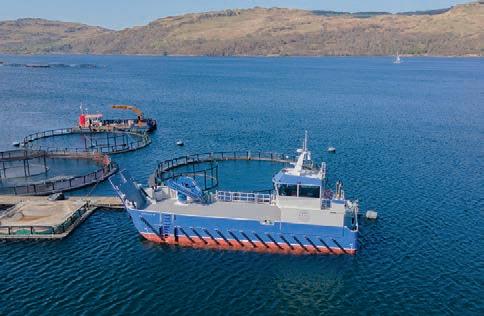
Kames: taking on salmon
Kames Fish Farming is Scotland’s oldest family-owned fish farm and the UK’s only producer of steelhead trout, the strain of rainbow trout that is most adapted to life at sea. The company, based on the west coast of Scotland, was named as Aquaculture Company of the Year in 2022 and won the Aquaculture Awards’ prize for animal welfare the following year.
Andrew Cannon became Managing Director around 15 months ago, taking over the reins of the family business.
As an independent, Scottish business that is not financed by any of the multinational fish farming giants, Kames is a company with a mission: to ensure that quality, sea-raised trout is viewed as the equal, or superior, of salmon.
Cannon says: “We are confident that, for taste, we’d come above salmon.”
Cate Cannon, Marketing and Communications Manager, stresses that provenance is a key part of Kames’ message: “More and more, people want to know where their food comes from.”
“We have been farming in Loch Melfort for 52 years and the water quality is still brilliant –as good as ever – we have diverse marine life like native oyster beds, Arctic terns and even rare flapper skate nurseries.”
One of the things that makes the loch such a good place to farm is the fact that is subject to strong currents and tidal flows, ensuring a continually cycling flow of water.
Cate says that steelhead is “an exceptional, clean tasting trout”. The strain the company
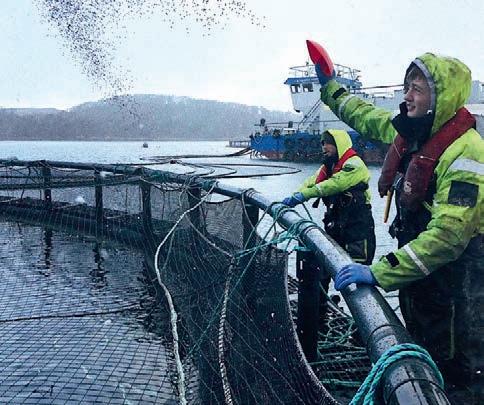
who is now Chairman.
With each generation of trout, survival rates have improved, and now the company is working with breeding and selection business Xelect to further improve selection. The aim is to improve growth rates and resistance to challenges such as PKD and sea lice.
The Kames team is also working with suppliers such as Gael Force, ScaleAQ and GroAqua to develop technology that is suited to trout – a smaller market than salmon.
That includes sensors to monitor fish health and biomass that will work in more brackish conditions where visibility is typically less good than in seawater.
Andrew Cannon is optimistic about the prospects for growth: “The portion trout market is fading, but there is a good opportunity for growth in the trout market. Trout production in Norway has gone up significantly and Scotland could do the same.”
He believes there is still capacity to grow production at Kames’ existing locations but is open to acquiring new farms if the opportunity arises. He explains: “There are sites that have not worked so well for salmon, for example where the water is brackish or the salinity is changeable. Salmon are generally less tolerant of changes in salinity.”
And he believes the trout market could get a lot bigger: “We are seeing more production
from countries like Turkey and Denmark in the market, but we need to be the leader in terms of quality.”
The supply of good quality, healthy ova is one of the most critical factors for the trout sector. The heavyweight player in this field is Troutlodge, part of the multinational genetic group Hendrix Genetics, which also includes salmon specialist Landcatch.
Based in Washington state, USA, Troutlodge is the world’s largest supplier of trout ova. It produces around 450 million eggs each year. Troutlodge has developed four distinct strains of trout that each spawn naturally at different times of the year, so there is no need for photo-period manipulation in order to provide year-round supply.
The company also works closely with Trova Trout, based in South Africa, the southern hemisphere’s largest supplier of eyed trout eggs. Trova rears Troutlodge’s genetic breeding stock in a “multiplication” model which are subsequently stripped and fertilised. This allows Trova to sell Troutlodge steelhead eggs from July through September. Troutlodge is looking to expand this model with partners in Latin America and Europe.
Jarl van den Berg, General Manager, Landcatch Natural Selection, says: “We are seeing organic growth across the board in the trout sector. Freshwater flow-through still represents the majority of the market. So far, RAS [recirculating aquaculture systems] production is a sliver, but it is growing.”
He notes, however, that farmers using conventional flow-through tanks and raceways are increasingly investing in technology to enhance production and grow out capacity, by partially recirculating some of the water and only removing some of the CO2 and re-oxygenating the water. Some go a step further and consider removing the ammonia using biofilters, coming closer to fully embracing RAS.
Trout is seen as more predictable and robust than salmon, even if it does not command salmon’s premium. Some producers are finding ways to increase trout’s appeal to consumers – in Turkey, for example, trout has been rebranded as “salmon trout” and astaxanthin-rich feed is being used to make the flesh pinker.
Meanwhile, Hendrix Genetics has an active research agenda, collaborating with a wide range of academic and industry partners, to accelerate genetic progress across its breeding programmes.
Van den Berg explains that Hendrix is working to exploit QTL






(quantitative trait loci) information in synergy with genomic selection for, for example, BCWD (bacterial cold water disease) resistance, to bring together the best of both worlds.
Most breeding programmes opt for either QTL selection or genomic selection, while Hendrix aims to bring those together, giving more accurate EBVs (estimated breeding values) and faster progress towards objectives.
“Disease resistance is one of these objectives. However, not all research is based on understanding the genome. We are also looking for various methods to produce a sterile diploid trout.”
Currently, if sterile trout are needed, triploids can be used. They are also suitable for growing to very large sizes in RAS facilities. Triploids do not mature, so they continue to grow. They, however, require different management than diploids and are more sensitive to high temperatures and low oxygen levels which can occur in the majority of the outdoor flow through sites. .
Diploid trout are therefore the ideal trout for such environments, and a sterile diploid could be very useful for both commercial, but also conservational purposes. Currently most production companies have extensive management plans to minimize the risk of escapees, and have action-plans ready in case an adverse event occurs. A sterile diploid will prevent the commercial fish to interbreed with wild fish if they ever escaped.
With seven farms and a big share of the market, particularly with its hot smoked trout offering, Danforel is one of the largest trout producers in Denmark.
Danforel raises rainbow trout in RAS farms, as well as processing and smoking its own fish.
In recent years the company has made advances in terms of its efficiency and in dealing with fish health and welfare issues. Now, according to CEO Steffen Nielsen, the biggest challenge is the market itself. The pressure from retailers to keep prices low is strong, and there is fierce competition from producers in countries such as Turkey, where the cost base is lower than in northern Europe.
Nielsen stresses: “We are setting high standards for quality, and we don’t want to
We need to be the leader in terms of quality ”
page from
employees in the lab; assessing growth (all photos: Troutlodge) Opposite from top: Danforel farm, Dambrug; Danforel sh processing; anforel eggs; ocky oschman etuna; etuna farm Tasmania; etuna whole ocean trout; Columbia River steelhead pack aci c Seafood



question that. Retailers are reducing prices, but that’s the name of the game.”
Danforel was acquired by aquafeed producer Aller Aqua, although Nielsen stresses that Danforel is paying a market price for its feed. The relationship does, however, create opportunities for working together on developing and improving feed solutions, which helps both Danforel and its parent. The company is also a pioneer in using the whole fish and making the best use of sidestreams. As well as providing ingredients for pet food, Danforel uses processing “waste” to extract fish oil of high quality. As Nielsen points out, the company can supply fresh fish oil to the European market with


much less oxidation than catch fisheries on the other side of the world can offer.
Technology also provides opportunities to reduce costs without compromising on quality. Nielsen says: “We see great benefits in automation… within a few years we expect to see some good financial results.”
Meanwhile Rocky Boschman, Managing Director of Tasmania-based Petuna, sees great opportunities for the trout sector: “Loved for its delicate texture, rich flavour, and high quality, trout is a favourite for both home dining and fine dining establishments.
“There’s strong potential for growth in both domestic Australian and international markets by tapping into consumer preference for responsibly farmed, nutritious protein. As more people prioritise sustainability and food origin, trout’s reputation as a versatile, health-conscious choice opens doors to new market segments, including sustainable retailers and highend culinary venues.”
into a state-of-the-art RAS hatchery, using less than 5% of the water that traditional systems require - highlighting Petuna’s commitment to sustainability. Petuna also holds BAP Four Star accreditation, the highest level in the programme, and it is the first hatchery in the southern hemisphere to achieve this certification.
Boschman adds: “A key part of our approach is our climate resilience breeding programme, which produces trout better adapted to rising water temperatures and the warmer conditions in Australia. This initiative is crucial to the long-term sustainability of our operations, helping to future-proof our stock against the challenges of a changing climate and ensuring Petuna’s continued commitment to responsible and resilient aquaculture.”
In the United States, Pacific Seafood operates both catch fisheries and aquaculture, though its subsidiary, Pacific Aquaculture. The latter includes its farmed Columbia steelhead trout, which are farmed in the waters of the Columbia River, in association with the local indigenous people, the Colville Confederated Tribes, in Washington state.
Danielle Florenzen, Fish Health Lab Manager with Pacific Aquaculture, says: “The biggest challenges or constraints on growth are: permitting and regulations in the United States and state-wide; access to good, viable breeding stock; and potentially [the rise of] plant based/artificial meat… this is a concern among all terrestrial meat-based operations.”



Petuna farms both “ocean trout” and “Atlantic salmon” in sea farms in Tasmania.
Boschman says: “Like most businesses, one of our biggest growth challenges is the rising cost of doing business. Increased operational expenses, energy costs, eco-friendly inputs, and biosecurity protocols all add financial pressure. We’re tackling these challenges head-on by investing in technology and infrastructure to boost efficiency and support sustainable growth. Our Best Aquaculture Practices (BAP) certification reinforces our commitment to global best practice in sustainability, traceability and fish welfare, even as costs rise.”
Petuna has recently made major advancements in its operations. Its multispecies hatchery in Cressy, Tasmania, now sustainably farms both trout and Atlantic salmon, boosting efficiency and market flexibility.
In June 2023, the company completed a A$15m (£7.8m) expansion, transforming it
She sees a key opportunity in educating the public about where their food comes from, and dispelling myths. Her outlook for the future is positive: “We are very optimistic that the industry and markets will continue to grow especially with the importance of building relationships and partnerships with other farmers and tribal partners to promote food security, high quality protein and promote research for future decision-making.”




recent poll suggests consumers would support the adoption of electrical stunning as a humane slaughter method for sea bass and sea bream

ANIMAL welfare is becoming an increasingly important issue in livestock farming. It is impossible to consider welfare without looking at humane slaughter methods, and aquaculture is no exception.
Traditionally, fish slaughter has not taken much account of this, but times are changing. Scientific research suggests that fish are more capable of suffering and distress than might have been thought in
the past,and there is also evidence that stress – which generates the production of cortisol in a fish’s body – can affect the quality of the product.
In the salmon industry, mechanical stunning prior to slaughter has become standard, but there is increasing interest in electrical stunning, whether for fullsize salmon or for smolts, or smaller fish. Ace Aquatec, for example, one of the companies pioneering electrical stunning in salmon, has also been working on projects for the tilapia and shrimp industries.
The Centre for Aquaculture Progress (CAP), a non-profit organisation dedicated to finding solutions to reduce fish stress, was interested to see how much support there would be for introducing more humane slaughter methods for farmed sea bass and sea bream
In Europe, these are species largely farmed in the Mediterranean and Aegean, and CAP commissioned leading market research firm Savanta to analyse consumer attitudes The survey received responses from a total of 1,600 consumers equally
distributed across Greece, Italy, Spain and France. These countries were selected due to their significant market size of sea bream and sea bass for fish producers from Greece.
The Greek aquaculture industry has experienced significant growth and is expected to grow further, with sea bream and sea bass being among the most commonly farmed fish species.
However, the CAG report says, the adoption of electrical stunning, a humane slaughter method that significantly improves fish welfare, has only been adopted to a very limited extent for these species.
The objectives of this study were: 1) to evaluate consumer attitudes towards electrical stunning as a humane slaughter method for sea bream and sea bass; and 2) to determine consumers’ willingness to pay a premium for humanely slaughtered fish.
A majority of 83% of respondents across all four countries expressed support for the use of pre-slaughter electrical stunning,


involve less fish stress and are willing to pay more to access them.









“Across Europe, we’ve observed a rising trend of consumers showing increased interest in how their food is produced. Our survey affirmed this trend, revealing that consumers care about animal welfare when making purchasing decisions at grocery stores.”
The CAP report argues that to position fish from Greek aquaculture as a responsible product for consumers to buy, fish welfare needs to be seriously considered.
It says: “In today’s market, consumers are increasingly conscious of the ethical implications of their purchasing decisions, seeking out products that align with their values and demonstrate a commitment to animal welfare.





indicating a widespread demand for improved fish welfare. This finding was consistent across all examined markets, suggesting that the desire for humane slaughter practices is consistent across Greece’s largest markets.
“Relevant studies indicate that the price increase per serving of fish (200g) would be significantly less than 0.05. Estimates for Greek aquaculture suggest an increase of less than 0.02 [£0.017] per serving. These findings underscore the cost-effectiveness of implementing pre-slaughter electrical stunning in the aquaculture of sea bream and sea bass, as it allows producers to meet strong consumer demand without incurring substantial additional costs.”
Naomi Murn believes the study shows that the adoption of humane stunning methods would benefit aquaculture producers and consumers, as well as improving fish welfare.
Opposite from top: Sea bass; Directors of the Centre for Aquaculture Progress, Naomi Murn and Mar�n icke presen�ng the study
This page from top: reek sea bass and sea bream top four markets Savanta CAP); Support for electrical stunning Savanta ; Consumers are willing to pay more for humane methods Savanta ; Sea bream
Furthermore, the study found that 80% of consumers who purchase sea bream and sea bass would be willing to pay an additional 0.05 (£0.04) per serving (defined as 200g) for fish that had been humanely slaughtered. While the observed willingness to pay more is similar across Greece, Italy, and France, it is lower in Spain. This result highlights the strong connection between consumer values and purchasing decisions, as well as the potential for producers to capitalise on this demand by implementing more humane practices.
No major differences have been observed between different demographic groups (age, gender, and income levels), indicating broad support for these issues in the population.
Naomi Murn, Director at CAP, comments: “This is the first study to directly assess European consumers’ preferences and willingness to pay for electrically stunned sea bream and sea bass, which meant we didn’t know what the results were going to be. It was exciting to find that consumers have a strong preference for products that
Consumers have a strong preference for products that involve less fish stress
She says: “Fish producers are increasingly recognising the growing demand for improved fish farming and slaughter practices. However, adopting new technologies can be challenging, and many fish producers perceive barriers to implementing new methods. This is why the Centre for Aquaculture Progress was initially established - to offer pro bono support to help producers adapt to evolving market needs and stay competitive.”
By working together, CAP argues, the industry can respond to the clear consumer preference for improved fish welfare, while also enhancing the overall sustainability and competitiveness of the sector.
Humane slaughter in Mediterranean sea bass and bream aquaculture: farm characteristics, stakeholder views, and policy implications (Frontiers in Aquaculture, 19 March 2024 - Koen van Pelt, Max Carpendale and Ren Ryba) bit.ly/4duIjS3
Report from the Commission to the European Parliament and the Council on the possibility of introducing certain requirements regarding the protection of fish at the time of killing (European Commission, March 2018) bit.ly/4epUik000Z
Producers interested in learning more about electrical stunning can contact CAP at info@centreforaquacultureprogress.org



















A study suggests that noise can be harmful for farmed salmon, as Vince McDonagh reports
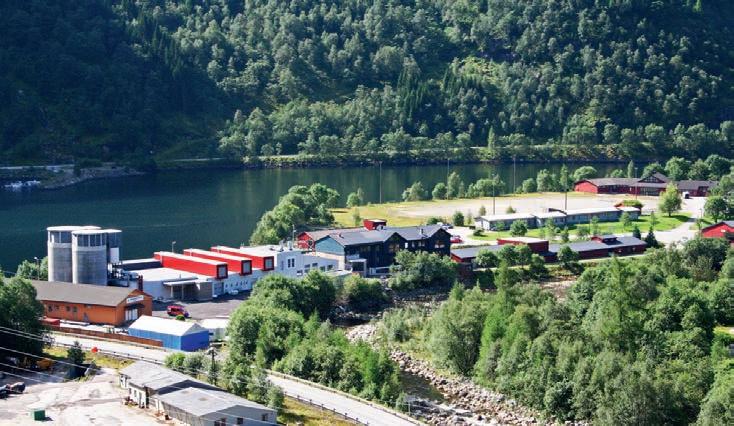
IMPORTANT new research has shown that man-made noise does affect salmon – and can inhibit the fish’s growth.
The study, which was carried out by the Norwegian University of Life Sciences (NMBU), has thrown fresh light on the behaviour of fish and why they behave in a certain manner when under stress.
Fish farms can be noisy places at times and a producer had been worried for a while that this was adversely affecting the development of the stock.
The university’s Professor Marco Vindas decided to find out for himself. He has come to the conclusion that excess noise does lead to poor welfare and adversely affects the ability of salmon to grow and reproduce.
monoaminergic signalling, and gene expression in four areas of the forebrain.
The results showed that sound exposure induced an activation of the stress response by eliciting an initial startle behavioural response, together with increased plasma cortisol levels and a decrease in neuronal activity.
He adds: “Together, our results suggest that prolonged exposure to sound results in chronic stress that leads to neurological changes which suggest a reduction of life fitness traits.”
Professor Vindas has researched both sporadic sounds that the fish are not prepared for, and sounds they hear often.
He says fish are probably used to people walking around and talking, and the pump always coming at the same time, but a sound that only comes once in a while can be experienced as stressful and frightening.



Farmed fish can hear people walking on the edge of the cage, pumps and boats, and if the facility is close to land or is land-based, there may also be cars and construction work nearby.
Low-frequency sound is particularly stressful for fish since it is an important factor in predator-prey interactions. Even though behavioural and physiological studies have been conducted to assess the effects of sound on fish species, neurobiological studies have been lacking.
In the study, the team exposed farmed salmon to low-frequency sound for five minutes a day for 30 trials and conducted behavioural observations and tissue sampling before sound exposure.
These trials included plasma cortisol, neuronal activity,

He also attempted to find out what the salmon can hear, at what frequencies, what the sounds are and how they affect behaviour, stress levels and the brain.
In the first study, the researchers ran an experiment at the Matre Research Station in Vestland.
“We used low-frequency sound because we know from nature that it affects the salmon,” says Vindas.
The researchers exposed the fish to a
The stress is more long-lasting than we thought

sound that they made using a machine that moved up and down in the water to create sound waves.
Vindas explains that the waves that occur when something moves in water are actually low-frequency sound.
“When a predatory fish swims, the sound of the waves comes first. The predatory fish thus reveals that it is on its way through the sound waves it creates, and then the salmon knows that it must get away. Therefore, we know that such lowfrequency sound stresses the salmon.”
The experiment lasted one and a half months and involved exposing the salmon to the same sound several times, at the same time and for the same amount of time each time.
The researchers took samples of the fish’s blood and brains before the experiment started, after they had heard the sound once and then after they had heard it 10, 20 and 30 times.
“We wanted to understand both what happens the first time they hear the sound and what happens over time,” he says.
“Can they get used to it if the same type of sound always comes at the same time? And how long does it take to get used to it?”
When it came to the fish’s behaviour, they saw that they responded strongly and tried to get away from the sound source the first time. Over time, the reactions became less.
“We do not know whether it is because they have become used to the sound or whether it is because they have learned the area in which the sound occurs, and that they




and reproduction is inhibited.”
He thinks it is too early to say precisely what this may mean for growth and reproductive capacity, but that these changes in the brain indicate that they are affected.
In addition, the researchers saw that several areas of the brain had an elevated level of the signalling substance serotonin.
An imbalance in the serotonin system can lead to many different diseases, and especially diseases that have to do with brain health.
Serotonin is a substance that affects, among other things, growth, sleep, regulation of emotions and appetite.
therefore stay away from that place. For the fish that were close to the sound source, they reacted just as strongly every time,” explains Vindas.
To find out if the fish were experiencing stress, the researchers measured the level of the stress hormone cortisol in the blood.
The first time they heard the sound there was a strong stress response, but when they had heard the sound 10 times, there was a significant decrease. And when they had heard it 20 times, their cortisol levels were almost down to normal, as they were before the experiment started.
Both the salmon’s behaviour and stress level may indicate that the fish are able to get used to sounds quite quickly, but the investigations of the fish brains showed a more lasting effect.
“When we look at individual parameters, we see that the stress is more long-lasting than we thought in advance,” says Vindas.
Several of the brain areas affected by stress were quite active throughout the experiment.
“We see that the expression of the various genes that have to do with growth
One of the areas in the brain that had elevated serotonin levels is an area that has not yet been fully researched, so the researchers cannot yet say what kind of consequences this may have.
“But we know that elevated serotonin levels in other areas of the brain lead to problems. And if the fish has it for a long time, it can lead to so-called ‘loser fish’. They are small fish with poor growth, and they have a chronically elevated serotonin level,” explains Vindas.
He believes that it is clear that sporadic noise is worse for the fish than constant noise, as they only partly get used to it.
Even constant sound at the same time, as we used in this study, affected the fish negatively, and this suggests that the fish’s welfare is impaired by being exposed to man-made sound.
He explains that the first time the fish hears a sound, the sound has a 100% negative effect on it. Over time, the impact decreases to about 50%.
“It is a big improvement, but it is still bad for the welfare of the fish. It is conceivable that the fish can get used to sounds in the long term, but it will depend on what type of sound it is and how powerful it is.”
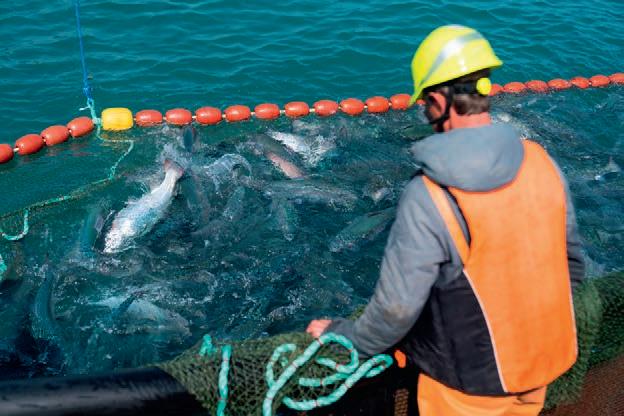
The research is based on the aquaculture industry’s need to know how sound can affect the development and health of farmed fish, but Vindas points out that the findings are also relevant for wild fish.
Prof Vindas concludes: “When we know that man-made sound, and especially sporadic sound that comes out of the blue, can affect the fish’s growth and ability to reproduce, it is clear that it is also relevant for wild fish that are located near a farm or elsewhere where there is a lot of man-made noise.”
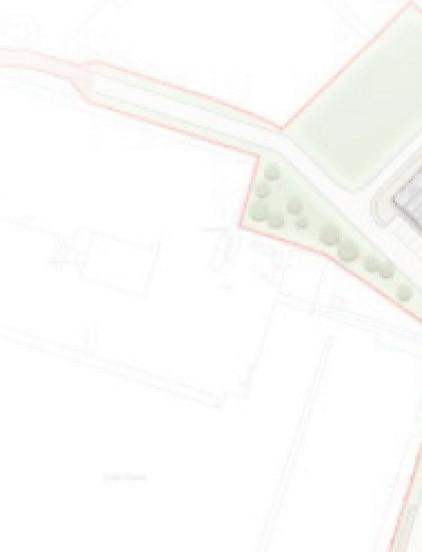















Hopes for an onshore salmon farm in Grimsby are once more in question in a High Court battle over planning procedure, as Sandy Neil reports
APLAN to build the UK’s first large-scale onshore salmon farm is in jeopardy, after animal rights campaigners won the right to challenge the local council’s consent. Their argument is that the decision in favour of the project was flawed because the council failed to take animal welfare into account.
Last November, North East Lincolnshire Council approved plans by AquaCultured Seafood to build a £120m salmon farm on former railway sidings at Grimsby docks, in the centre of England’s fish processing industry.
The pioneering fish farm – which could be the first in the UK to use recirculatory aquaculture system (RAS) for grow-out production – is intended to produce 5,000 tonnes of Atlantic salmon a year, each growing to four or five kilogrammes, aimed exclusively at the UK market.
The London-based start-up, which hopes to produce its first salmon within four years, said its enclosed system would optimise fish welfare, as well as prevent disease and invasions of sea lice, which can blight open-net salmon farms. Furthermore, it will cut emissions, create jobs, and help meet the nation’s huge demand for fish.
The seafood industry backed the scheme. Simon Smith, Chair of the Seafood Grimsby & Humber Alliance, said: “Having an onshore salmon farm investment in Grimsby makes eminent sense and will mean we












are less reliant on overseas imports of fresh salmon. It is a stepping stone towards the UK’s food security of a healthy raw material.”
But less than a year after getting the green light, the project is now at the centre of a legal battle, after Animal Equality UK successfully sought permission in the High Court to fight the council’s decision.
Edie Bowles, solicitor at Advocates for Animals, the legal firm representing Animal Equality UK, said: “This case is all about proper scrutiny being given for planning decisions that pose huge risks, including to animal welfare.



“We are glad the judge agrees that there is an arguable case. It will hopefully be a wake-up call to other planning authorities that they need to follow the correct process.”
The “mega-farm” has attracted much interest ever since February 2023, when AquaCultured Seafood first unveiled its plans to build a 40,000 square metre RAS salmon grow-out facility, to include a processing factory, on an industrial site close to Grimsby’s existing seafood hub.The company picked Grimsby after spending three years looking at potential sites around the UK and visiting other RAS farms abroad, explained Director and Founder Neil Jamieson. Why?
“Because of its access to fresh water and because of ABP’s (Associated British Ports) belief in using renewable energy,” he told Fish Farmer. “We were also enthused by the history of Grimsby and the fact that it has excellent support services in refrigeration, logistics, and other important matters.”
The farm will feature the latest cutting-edge technology, Jamieson added, such as a RAS filtration system from Israeli company AquaMaof, and artificial intelligence (AI). It will create at least 100 jobs, in a town where over 200 jobs were lost last year after Young’s Seafood closed one of its factories, now set to be demolished.
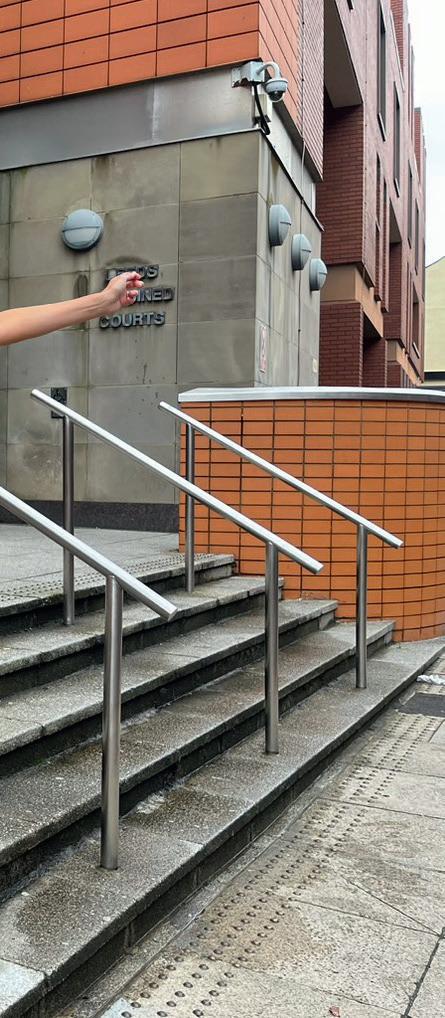

”There is no truly biosecure factory farm





Peter Dalton, Co-founder and Director of the Grimsby Seafood Village project, told Fish Farmer he thought the facility would be “absolutely brilliant” for the town’s economy. He said: “Some of the arguments being used by opponents were the same as those being used against us when we wanted to build our seafood business park. Today, the seafood village is full and we have a waiting list.”
However, others have strongly opposed the plans, including people who live close by who staged a large protest at a Grimsby Town FC match in March 2023. AquaCultured Seafood held a public consultation that May outlining what it intends to do. One of the company’s directors, Mike Berthet, assured people there would be practically no noise and no smells from the site, and waste products would leave in sealed containers.
Fish welfare ‘not material’ to planning decision
Opposite from top: Abigail enny E ecu�ve Director, Animal Equality (right) celebrates outside the court with colleagues a er permission to appeal the planning decision is granted; rimsby port; AquaCultured RAS farm plans
Above right: rimsby port ar�st s impression of salmon factory
Right: rimsby port salmon site
The planning application, formally submitted in June, was recommended for approval by council planners, and councillors on the North East Lincolnshire Planning Committee consented in November.
A report said: “The proposal would represent a significant economic investment into the area, creating a number of jobs through construction and then operation as well as supporting the food processing and manufacturing businesses in the area.
“It will not cause harm to residential amenities or business amenity, the visual character of the area, drainage and flood risk, highway safety and amenity, the Humber Estuary designations, the onsite biodiversity and local wildlife site allocation.”
Crucially though, Animal Equality UK said, councillors who approved the scheme were told concerns about fish welfare should be
noted, but “are not considered to be material land use planning considerations”.
The charity cited a submission to the planning committee from Mark Borthwick, a Doctoral Fellow in salmon farming, warning the farm would require high stocking densities. He said salmon ranged widely with a strong migration drive and it was unknown how they would cope in the cramped conditions of an onshore farm.
His submission stated: “The industry’s hope is that by doing the whole operation under factory conditions, they can control disease. However, as has been abundantly established in other farming environments, there is no truly biosecure factory farm and other diseases will emerge.”
At the High Court in September, Animal Equality UK was granted permission to challenge the council’s decision, after it argued animal welfare could be considered during the planning process, and the councillors were misdirected by officials.
The charity explained: “In a bid to stop the construction of the site, Animal Equality now intends to argue in court that the committee’s decision to permit the site’s construction was unlawful, with committee members being told they could not take into account animal welfare. As a result, we believe that the highly likely catastrophic and irreversible animal welfare ramifications were not included within their decision-making process.”
The council said it would not comment while legal proceedings were continuing. AquaCultured Seafood also said the company would not be commenting and added: “We await the result of due process.”
The case will now proceed to a full judicial review, and the court will examine whether the council’s approval of the on-land salmon farm was lawful or not. Both sides will present detailed arguments and evidence, and if the court finds the decision unlawful, councillors will need to reassess the planning application.























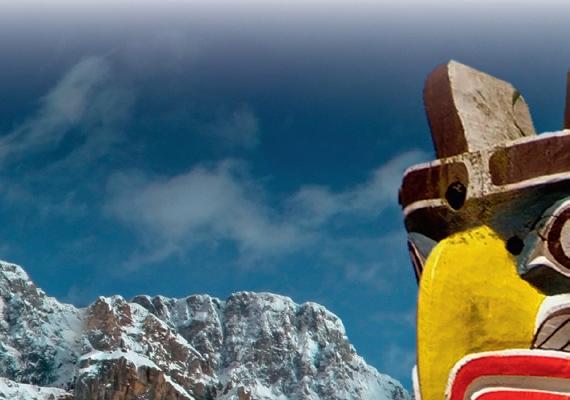




Federal government plans to reform the salmon industry in BC could simply kill it off, producers fear
DESPITE the scenic splendour of its great mountain ranges, British Columbia is not the preferred destination for some of Norway’s leading salmon farming companies these days.
When they set up their fish farms in Canada’s most westerly province more than two decades ago, the move was viewed as a bold adventure that would one day help to feed the entire North American continent.
Not anymore. Canada’s Liberal-led federal government has pledged to end open pen fish farming over the next five years, but only in British Columbia where it wants companies to switch to RAS (recirculating aquaculture systems) production.
The east coast provinces will be free to carry on with open farming at least for the time being, raising the question: Is the BC ban just a move to placate certain organisations and native groups, as some believe?

The move has led to two of the big Norwegian players to question their presence in BC. No-one has yet said they plan to pull out but the implied threat is there.
Grieg has suspended all strategic investment in BC while Mowi has initiated a strategic review of its presence in the province. Both companies directly and indirectly employ thousands of people, so their loss would be a huge economic blow.





Politically, the role of Canada’s indigenous peoples – the “First Nations” – is central, with some supporting the net pen ban on the grounds that it will help conserve wild salmon, and others seeing it as an intrusion by the federal government into their right to participate in a profitable industry.
In BC the big salmon companies are working closely with local First Nations









communities. Mowi, for example, says: “We are concerned with reconciliation and we have agreements in place with each of the indigenous groups in the territories we operate in. These agreements are founded on recognising the indigenous people’s right to exercise jurisdiction over land, resources and waters within their territories.”


Cermaq, which is Norwaybased but Japanese-owned, said it remains deeply concerned about the future of the sector in British Columbia. But it is not just the Norwegian companies who are likely to suffer. The province is also home to a number of Canadian-owned aquaculture businesses which are going to be hit hard if the government sticks to its policy.
That said, Prime Minister Justin Trudeau and his cabinet are not for budging although pressure is continuing to mount.
He completely ignored a recent demonstration by fish farm workers at a party rally in the province last month.
Federal Fisheries Minister Diane Lebouthillier is due to come up with a transition plan which will involve moving the open-net farms to closed containment facilities, in water and on land. This has not yet seen the light of day, however.
The industry insists that the five-year time limit is far too short and the cost of transitioning is likely to approach at least CA $3bn (£1.7bn). For some companies it might be a question of “do we stay or pull out and invest elsewhere?”
At the moment they are keeping their powder dry, merely hinting at a possible withdrawal. There are other investment opportunities, however, notably in Iceland,

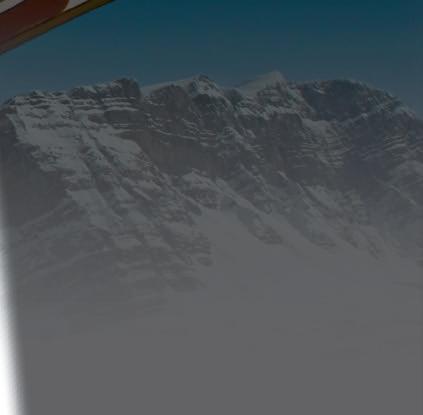
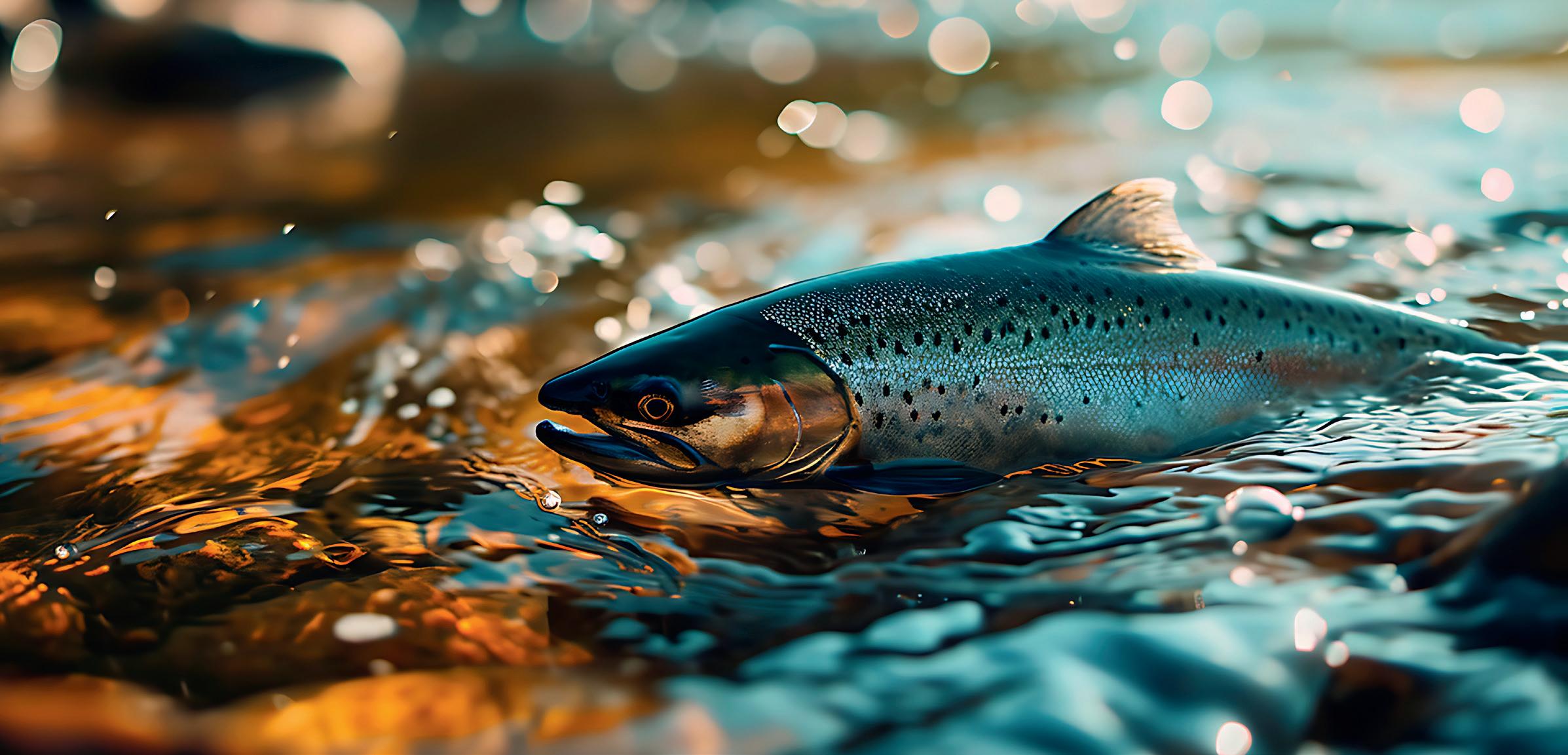
with the government) and Scotland. There is little doubt they are thinking seriously about their future in that part of Canada. In contrast there seems to be few problems on the eastern side of the country where Grieg has a relatively young Newfoundland salmon investment programme.
Brian Kingzett, Executive Director of the BC Salmon Farmers Association, said recently: “The expectation to produce 70,000 tonnes of BC salmon in land-based or marine closed-containment systems by 2029 is unrealistic and irresponsible.”
Kingzett also believes the timeline for transition to closed containment has been made in the absence of any scientific assessment of the environmental impacts of this category of technology.
The important and often outspoken Canadian seafood website SeaWest News, which has campaigned against government policy, says criticism of Trudeau’s decision has increased to include indigenous groups like the Coalition of First Nations for Finfish Stewardship. The Coalition views the policy as a return to the paternalism of Ottawa dictating resource management in their territories.


Canadian Aquaculture Suppliers Association and fisheries experts from around the world.
The decision, says SeaWest News, also flies in the face of calls by the United Nations, which is urging member nations to grow their aquaculture output by at least 35% by 2030.
The other problem is that the First Nation groups are split on the issue with those who depend on wild salmon supporting the government, while those involved in fish farming do not.
Many people in British Columbia, however, believe the federal government is bowing to eco-extremists and would like to see a reasonable compromise.
The anti-fish farm lobby certainly has a number of high-profile supporters, including Leonardo Di Caprio who waded into the debate by criticising the decision to extend the licences to five years.
The 93-year-old Star Trek actor William Shatner has also added his voice against open pen farming with a profanity-laden video.
BC currently has more than 70 fish farms providing the province with its largest food export commodity so it is clearly a major issue.
In fact BC’s original fish farmers date back to the mid-1970s when it was largely experimental and run by small family enterprises.
It only began to become organised a decade later when the established Norwegian farming companies began arriving with plenty of cash and know-how.


Other groups that have called for a rethink of the plan include the Canadian Federation of Agriculture (CFA), the BC Agriculture Council (BCAC), The United Steelworkers Union, The

One of the major criticisms from the “anti” lobby has centred on the spread of salmon lice. A recent Norwegian report, however, which reviewed the Norwegian regulatory management of the salmon farming sector, also concluded that sea lice infections on farms are not associated with a measurable impact on wild salmon. The information was recently published in a peer-reviewed scientific journal, Reviews in Aquaculture
“This is an important finding, as it aligns with the research and data we are seeing on sea lice in Canada,” said Simon Jones, Emeritus Scientist of Fisheries and Oceans Canada (DFO), commenting on the study.
The expectation… is unrealistic and irresponsible
He added: “The highly variable relationship between lice levels on wild salmon and salmon aquaculture in BC indicates the need for a greater understanding of all factors affecting the survival of wild salmon.”
But whatever the evidence, the government appears unlikely to change its mind over the five-year time limit.
The salmon industry faces the bleak prospect of spending tens of millions of dollars on conversion or pulling out and investing in a country that is less hostile to fish farming.
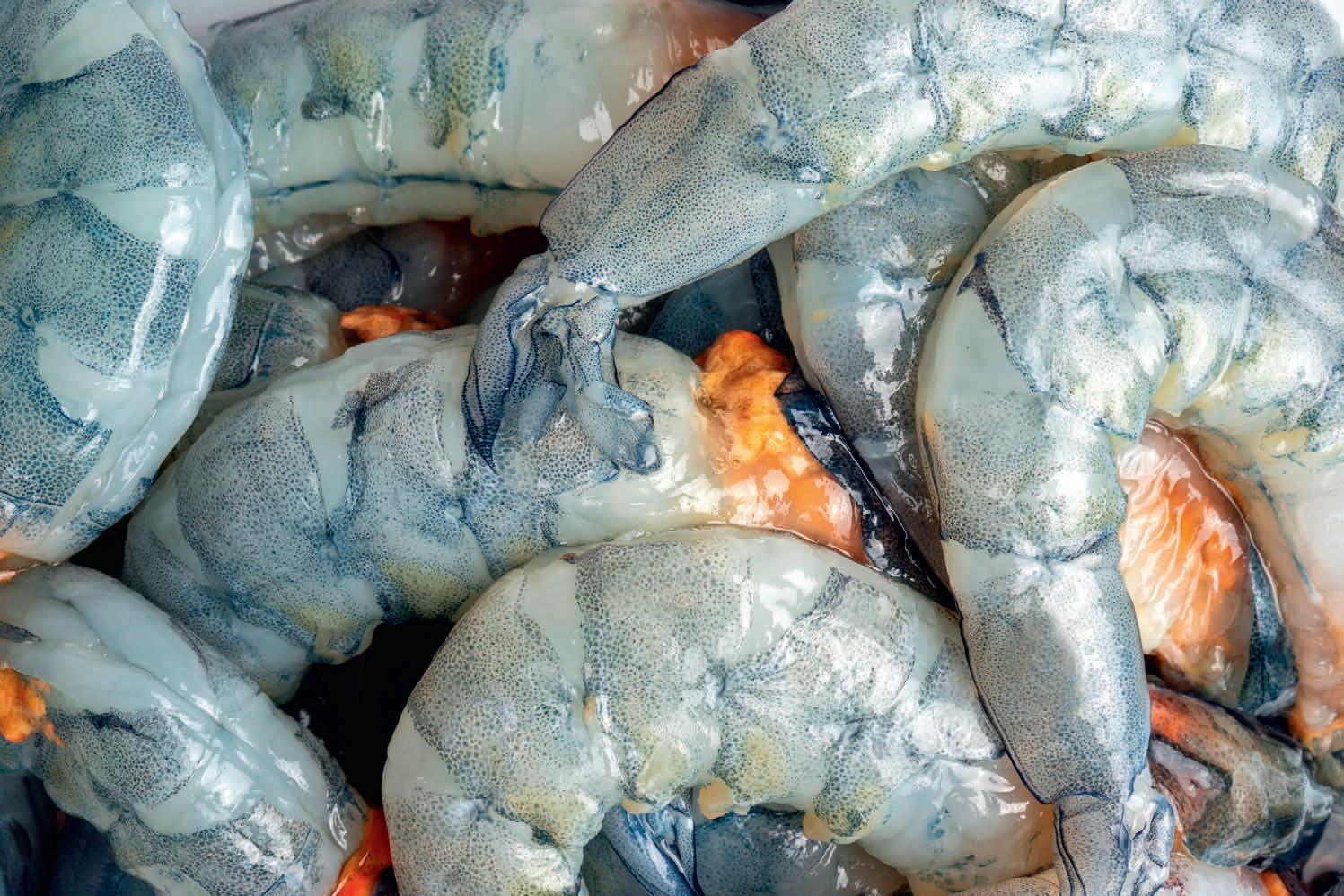
Europe loves to import shrimp, but would we be better off growing our own? Robert Outram investigates
THE world’s favourite shrimp is without doubt Litopenaeus vannamei, a crustacean known variously as Pacific white leg shrimp, white tiger prawn or – for most British consumers – “king prawn”.
This is by far the most commonly farmed shrimp, and producer countries like Thailand, Vietnam, India and Ecuador export it to consumers all around the world.
The success of the sector has come with problems, however. Coastal shrimp farming is associated with pollution and over-use of antibiotics, as well as environmental damage, particularly in terms of the destruction of precious mangrove forests which remove more CO2 per m2 than any other ecosystem on Earth and provide coastal protection against storms and sea-level rise.
A number of recent reports have highlighted labour force abuses in several shrimp-producing countries. And, of course, there is the issue of freezing shrimp – which sometimes stays in storage for many months – before shipping it many hundreds or thousands of miles to customers in Europe and North America. What if, however, shrimp could be produced as a
domestic product in European countries?
The UK Sustainable King Prawn Project (https://sites.exeter.ac.uk/kingprawn) was set up to answer that question. As Professor Rod Wilson of the University of Exeter explains, it began with a study into crustaceans and what they need in order to moult and grow successfully.
He and his colleague, Rob Ellis, were visiting Thailand as part of that research, and saw at first hand the reality of coastal shrimp farming in some places.



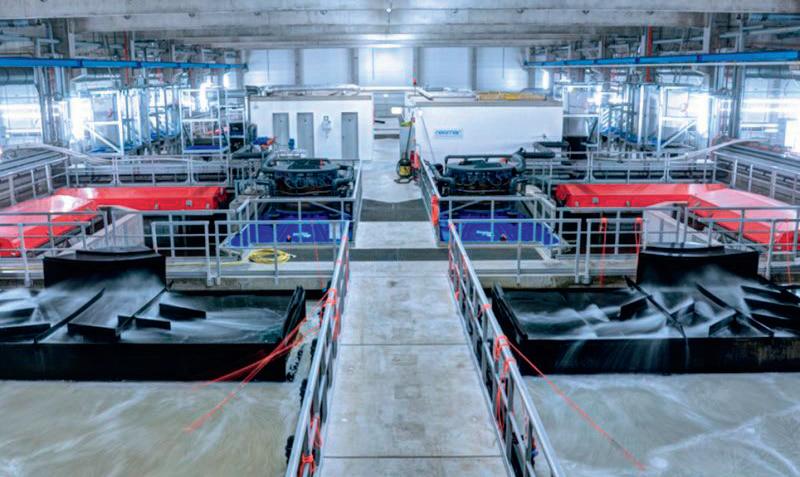
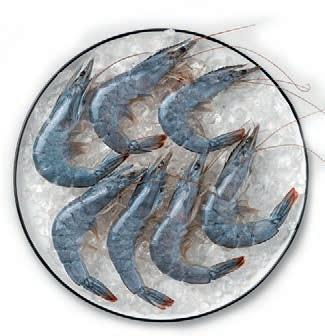
Wilson explains: “We thought ‘there is a lot to be improved here’, but we could see how as biologists we could help the industry because there were some obvious easy wins if we could find the ideal conditions for growing shrimp indoors in RAS using renewable sources of heat for this tropical species.”
The initiative now has several strands or “work packages”. The first is a study of the environmental economics of prawn RAS production; and the second is a study of the biological factors, including water chemistry and diet, to find the optimal conditions for
The only way to survive in this market is to scale up production
growing L. vannamei. A third involves a demonstrator shrimp farm near St Andrews (see page 48 for more on this).
The initiative has received funding from the BBSRC (Biotechnology and Biological Sciences Research Council) which is looking for ideas to help transform the UK’s food systems (ukfoodsystems.ukri.org/).
The king prawn is already a well-liked product and there is a ready market for it.
Wilson says: “We could grow the freshest prawns you’ll ever have and, importantly, they can be completely sustainable.”
Linking the initiative to existing terrestrial farming, the team are looking at how farm waste (manure and crop sidestreams) in anaerobic digesters can be used to produce both methane and – as part of the process – heat. Currently the latter is mostly wasted because heat is hard to transfer over any distance. So why not put a tropical shrimp farm that needs warm water next to an anaerobic digester?
Farmers would be able to add to their revenue from either farming shrimp themselves or, more likely, letting the farm to specialist operators.
There is still a lot to learn, since this approach is very different from typical coastal pond farming. As Wilson stresses: “We are still in the early days of knowing what prawns need to grow optimally in an indoor recirculating system.”
Researchers are also looking at whether shrimp can flourish at lower levels of salinity – this would mean the effluent from the farm is less salty and easier to find uses for.





Wilson says: “We want to produce guidelines for water salinity, calcium, pH, alkalinity and so on, for which we ideally need real-time sensors to monitor and manage the water chemistry.”
Technology exists for some of those but not all – for example calcium sensors would need to be developed as shrimp actively remove so much calcium from the water to harden their new exoskeletons after each moult.
The researchers are also looking at how waste from the shrimp farms could be valorised – as fertilisers or soil enhancers, for example.
The initiative is two years into a three and a half year programme, with 11 academic researchers from Exeter and Reading universities and Rothamsted Research, as well as 11 industry partners involved.
The fourth work package addresses a potential limitation though. Currently, any UK farmer would need to import shrimp juveniles as there is no hatchery in the country. Wilson says: “We would need a hatchery in the UK to guarantee a biosecure supply. There isn’t one at present, but a lot of people are interested in the idea.”
The idea of a National Aquaculture Centre has been mooted which could involve not only a hatchery to supply farming operations for shrimp (and why not other aquaculture species too?), but also a centre to provide a trained workforce and a research and development capability, as well as engaging in outreach to get important messages to consumers.
The end result, if this initiative succeeds, would be a premium, fresh product with a greatly reduced environmental footprint, if not a completely circular and sustainable healthy seafood production concept. As Wilson stresses: “The UK might not compete on price with the cheapest overseas pond-based imports, but if the true environmental cost of producing shrimp was taken into account, we would blow the competition out of the water.”
Meanwhile in Germany, Oceanloop operates RAS shrimp farming facilities in Munich, Bavaria, and in Kiel, on the country’s north coast. The company, founded in 2016, has developed its own unique platform-technology for land-based farming of diverse seafood species and is currently also farming grouper, a premium grade tropical fish. Dr Fabian Riedel, Founder and CEO of Oceanloop, estimates there are already around 20 shrimp farms in Europe, but so far all of them are fairly small. Oceanloop’s Munich facility produces 20 tonnes per annum and the Kiel plant produces five tonnes. The company has plans to
scale up significantly, however.


First, the pilot plant at Kiel will be expanded to an annual capacity of 60 tonnes, while a project being developed in Spain is hoped to produce up to 2,500 tonnes annually. Riedel stresses: “The only way to survive in this market is to scale up production. Our Spanish farm, at 2,000-2,500 tonnes, would bring our opex [operating expenditure] down to 5.80 per kilogramme (£4.88), which is competitive with imported shrimp.”
Oceanloop is already selling “Bavarian shrimp” through its distribution arm, Honest Catch, which also sells a range of externally sourced, sustainable seafood.
Riedel says: “We had first mover advantage, so the question was what price point do we go for?”
The answer was to price the homegrown shrimp as a premium product. Fresh, sashimi-grade Bavarian shrimp is currently on sale at 99.96 per kilogramme (about £84) – but it is finding a market.
Probably the most important aspect of Oceanloop’s offering, however, is the RAS technology. As Riedel stresses: “Shrimp are very sensitive and mortality is quite high. There is also a high danger of disease, so shrimp farming needs a controlled environment.”
The most common system for shrimp farming in RAS is biofloc, where cultivated microorganisms are used to help detoxify the recycled water. This, Riedel argues, does not scale up very well and instead, Oceanloop operates a clearwater RAS system, with mechanical filtration. Also, it uses raceways with a constant flow rather than the typical round tanks seen in most RAS systems, keeping the water fresh.
Because shrimp tend to prefer staying close to surfaces, to make the best use of the volume in the raceways Oceanloop has developed “urban mangroves”: stacked shelf-type units that offer the shrimp some shelter. Riedel describes the set up as “Manhattan underwater”.
Another advantage of the raceway system is that it can accommodate a three-compartment layout with moveable walls, so the space for each cohort can be expanded as the crustaceans grow. This avoids the need to pump the shrimp into larger tanks as they grow, a process that can be highly stressful.
The company has also developed a computer vision modelling system to monitor the biomass and welfare levels of the shrimp in ways the human eye could not match.
Energy is a key issue for RAS farming, but the Kiel plant uses waste heat from a public water treatment system, while the Spanish farm will have access to solar and wind power.
Oceanloop has already invested 20m (£16.8m) and is looking to raise a further 120m (£101m), having already secured debt facilities of 35m (£29.5m).
With shrimp consumption in Europe alone estimated to reach $13bn (£9.9bn) by 2028 (source: Statista/ Straits Research), even a small part of that market represents a huge opportunity.

On the east coast of Scotland, an innovative project is seeking to show that tropical shrimp can be grown – at commercial scale – in colder climes

GROWING king prawns in the UK for same-day delivery to the local market is an appealing alternative to shipping them from halfway around the world. The obvious drawback, however, is that L.vannamei is a tropical species and – spoiler alert –Britain is far from being a tropical country.
Even a comparatively pleasant summer day in these climes falls short of what these shrimp need to thrive, so to grow them, an artificially warmed environment is required. That presents a problem when energy prices are high and likely to remain so – but it is a problem to which Andrew Whiston, founder of Rastech, believes he has found a solution.
Rastech’s experimental farm site is based at the St Andrews University Eden Campus at Guardbridge, in Fife, on Scotland’s east coast.
It is situated on land reclaimed from the sea over the years with waste dumped from the now defunct paper mill – which means that several feet below ground level there is a protective membrane, shielding a variety of potentially hazardous waste materials. It means that potential uses of the site are limited, but the Rastech site does not need deep foundations and its water is drawn from the North Sea, not groundwater.
The Eden Campus is being developed by the university as a centre for innovation and technology, and Rastech is the first tenant, although the Eden Mill distillery is a near neighbour.
The Rastech team’s solution to the energy problem is twofold. First, the farm is heated and powered entirely by renewable energy. It is not on the main energy grid – instead, its power sources are a solar panel array run by the university and a biomass boiler run on woodchips. The CO2 waste from the boiler is catalysed to create an alkali supplement for the shrimp farm, as
part of the project’s “circular economy” ethos.
As Whiston puts it: “We’re circularising somebody else’s waste and using it in a way that benefits us.”
Running off-grid not only helps to cut costs, but also shows that the farm’s model could work in remote locations – either on the Scottish coast or for example in Africa – where there is little or no access to mains electricity.
The second element involves ensuring that as little heat as possible is wasted. For this, the Rastech team drew from the experience of Fife’s fruit growing sector, which uses polytunnels to keep its crop safe while taking advantage of the region’s long hours of summer sunshine.
These polytunnels were the inspiration for the design of the Rastech’s insulated unit, which looks something like a larger version of a Nissen hut from the Second World War.
It is basically a 30-metre polytunnel with insulation. Fibre glass – the material typically used for insulating houses – would have been too heavy for the structure, but instead a polyester-based material, like the insulation found inside a duvet, was used. It is derived from recycled, single use plastic bottles.
And it works. Whiston says: “This winter it was -7C outside, with snow on the roof, but it was 32C inside.”
Shrimp farming can be green
Inside, there are two separate sections. The first is a functioning RAS (recirculating aquaculture system) unit – or rather, two units running in parallel with separate filter systems.
This, when Fish Farmer visited, housed the farm’s shrimp in two sets of four tanks each. The parallel set-up means that research and development can be carried out on one set while the other acts as a control group.
The second and larger section will operate on a near-commercial scale, with five tanks, each with a capacity of 23,000 litres, giving a total capacity of 115,000 compared with the 8,000 litres capacity of the R&D unit.
The larger tanks are built from low-carbon concrete, a material that preserves heat much better than the plastic tanks in a typical RAS system. At the time of our visit, the tanks were being prepared to accept their new inhabitants.
The shrimp at the Guardbridge site are imported as juveniles from the United States. This is a more biosecure source than bringing them in from one of the big shrimp farming regions in













from top: Andrew Whiston, Rastech; solar panels, Eden campus, St Andrews
This page, clockwise from top: Rastech farm; juvenile shrimp; samphire grown using hydroponics; R&D tanks
the tropics, but even so the supply could potentially be interrupted, either by a disease problem leading to a ban by the UK authorities, or major weather events such as hurricanes affecting the southern US.
The plan, therefore, is to move – at some point next year – to obtaining broodstock and producing homegrown juveniles, for Rastech and for other UK producers. This would create more security for the UK industry, Whiston believes.
Water from the farm is drawn from the Eden estuary, which is a site of special scientific interest. Ironically – or sadly – it is too dirty to farm L.vannamei so it has to be filtered before use. In fact, says Whiston, the filtered effluent from the shrimp farm is actually much cleaner than the water in the estuary.
Solid waste from the tanks is filtered out and the nutrients in the liquid waste are used to grow salt-tolerant crops. In this case, Rastech is growing samphire, a succulent seashore plant often used as a garnish for seafood.
Will UK grown shrimp be cheaper? No –but it will be much more environmentally friendly, Whiston says.

Much the world’s shrimp production in coastal ponds contributes to marine pollution, with minimally filtered effluent returned to the sea, degradation of local ecosystems like mangrove forests and excessive use of antibiotics. And that’s without calculating the airmiles.
He stresses: “If they [pond farming
Our shrimp will incur NO airmiles and NO antibiotics, ever ”
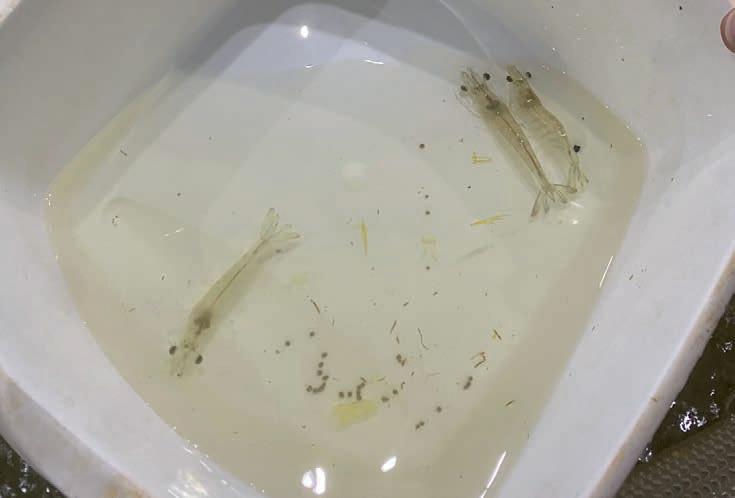
producers] had to farm to our standards, we would not be more expensive.
“Our shrimp will incur NO airmiles and NO antibiotics, ever.”
The Guardbridge site is currently operating as a research and proof of concept project, but it could easily be expanded to a fully commercial scale, Whiston believes.
Rastech, as well as producing its own shrimp for sale, could operate as a hatchery for other producers and as a supplier, offering RAS shrimp farms on what would be more or less a “plug and play” basis. To achieve these ambitions, however, the company will need outside investment – so far it has been selffunded, but scaling up will require more capital.
So far, what Rastech has shown is that shrimp farming in the UK is more than possible, and also that it can be done in a sustainable manner.
Even the site’s office unit is recycled – it was originally part of a refrigerated lorry operated by a national supermarket chain, and it could also function as a container for shipping out RAS components to other would-be farmers.
As Whiston puts it: “We are trying to prove that environmentally friendly production can be profitable!”

A Donegal-based business is now Ireland’s leading boatbuilder for aquaculture vessels
SEABOUND Engineering Ltd, located on the harbour in Greencastle, Co. Donegal is a vastly growing boatbuilding company, with a client base extending throughout Ireland and the UK.
Seabound Engineering Ltd is now Ireland’s leading boatbuilder of aluminium vessels for the aquaculture sector. Seabound Engineering is an SCMS-certified (Society of Consulting Marine Engineers) shipyard, ensuring all orders from the UK are built to SCMS shipyard standards as well as SCMS Certification.
On Friday 30 August, Seabound Engineering Ltd officially launched its newest vessel build, Lena Quinn, for the Donegalbased company, Mulroy Bay Mussels, owned by the Wilhare family. Mulroy Bay Mussels are sustainably farmed using continuous rope and biodegradable cotton. The seed is sourced naturally from spat in the bay with a growth cycle of 18 – 22 months. The vessel was designed by Atlantek Maritime.
Vessel specifications
Main Dimensions Length: 16.0 m (moulded): Width 6.8 m (moulded): Deck to Keel 1.8 (moulded).
The vessel is a twin hull double chined displacement catamaran fitted with an aft wheelhouse and powered by two off hydraulic thrusters. Wheelhouse and hull are fabricated from marine grade aluminium. The wheelhouse is positioned aft to maximise the working deck space and to suit cargo offloading arrangements in Mulroy Bay.
Each hull is divided into four watertight compartments, with the machinery space being located on the aft of the port hull. Around the sides of the hull a solid aluminium fender is provided all the way to two large rubber fenders at the bow.
The deckhouse accommodates a galley, a WC and the bridge. The bridge is raised to provide good visibility when cargo is loaded on the deck. Gross clear deck space forward of the wheelhouse is 84m2
Four off davits are provided on the port side of the vessel for lifting mussel ropes on board and there is a sea crane on the starboard side.
The vessel is designed and built as a “P5” Passenger Boat. Structurally, the hull was designed to Lloyd’s Register Rules for




the Classification of Special Service Craft “G3 Service Group 3”. “G3” means craft intended for service in waters where the range to refuge is 150 nautical miles or less.

The vessel is designed with a ballast system to enable the vessel to be lowered to a working height for harvesting mussels, which also creates further stability for deck cargo. Vessel propulsion is a 300hp Scania hydraulic powerpack, supplied by Hydro Armor, which drives twin hydraulic thrust units mounted port and starboard aft of the hulls, giving the vessel incredible manoeuvrability in deep and shallow waters.
From the completion of its first vessel build in March 2021, Seabound Engineering has since completed a further 23 builds ranging from 7-metre to 16-metre vessels, including Ireland’s largest aluminium catamaran and Ireland’s first amphibious vessel build. Each build is turnkey ready and built to the requirements for each customer.
Recently, Seabound Engineering received two major contracts for a 15-metre crew transfer vessel and a 24-metre mussel harvesting vessel for the UK.
For further information visit the Seabound Engineering page on Facebook or email seaboundengineering@gmail.com
”The wheelhouse is positioned aft to maximise the working deck space

XIAMEN Huison Biotech Co Ltd have been dedicated to the research and production of algal oil for over 20 years, with rich experience and advanced technology.
Using algal oil rich in DHA (docosahexaenoic acid) –Rayson has DHA>55% – makes salmon farming easier and more efficient. Feeding salmon with DHA, an essential omega-3 fatty acid, offers several key benefits including: improved fish health and growth; enhanced nutritional value; boosting the immune system; improved reproductive performance; stress resistance; and sustainable alternative to fish oil.
These benefits make DHA-rich feeds a key factor in improving both





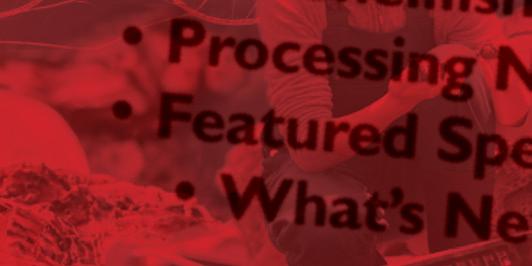




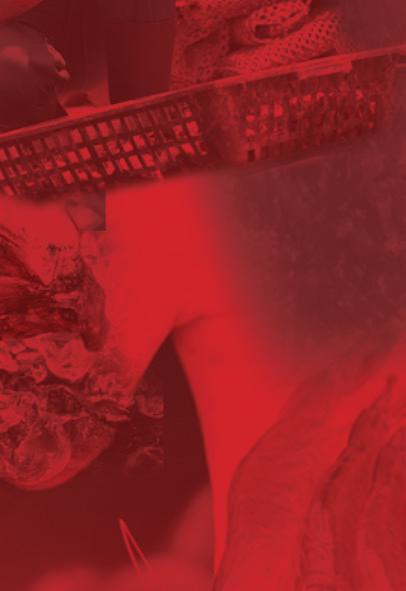




the health of farmed salmon and the quality of the final product for consumers.
RaySon algal oil is rich in important nutrients such as high concentration DHA, which can effectively enhance growth rate, immunity, and survival rate of salmon, and significantly improves meat quality.
The company has independent intellectual property rights throughout the entire process from algae cultivation to production, utilising patented technologies such as mechanical wall breaking, non-solvent extraction, and winterization to ensure the purity and activity of DHA algal oil.
manufacturer and product
This ingredient is non-GMO, kosher & halal-certified and the company is ISO 900 and ISO 22000 certified, with production capacity of 6,000 tons annually.
Choosing Rayson algal oil, is adding core competitiveness to salmon feed. By collaborating with them, farmers will receive highquality products and professional support to jointly promote the development of salmon farming.
Please reach out to us for more information on this product, to discuss cooperation matters, and feature a better future!
E-mail: info@chinahuison.com; Website:www.chinahuison.com; Tel:+86 592 711 5887












A rare Chinook salmon species in California has been given a chance to survive drought conditions thanks to a helicopter airlift, as Julia Hollister reports
AN innovative programme to save endangered, winterrun Chinook salmon to the McCloud River in northern California sees fish eggs making the journey by first class helicopter.
“This pilot project was initiated in July 2022 in partnership with the Winnemem Wintu Tribe, NOAA Fisheries, the US Fish and Wildlife Service and California Department of Fish and Wildlife,” says Kaitlin Dunham, Livingston Stone National Fish Hatchery Manager.
“Eggs were taken from this fish hatchery and incubated in the McCloud River. The baby salmon were released to grow naturally in the river and were later caught and transported to the Sacramento River below Shasta Reservoir so the fish could resume their journey to the Pacific Ocean.”
The hatchery is the only one in the world that raises listed winter-run Chinook salmon, which is federally listed as an endangered species. It is also the site of one of two captive broodstock programmes for threatened delta smelt (Hypomesus transpacificus) in the state of California.
Livingston Stone National Fish Hatchery, a substation of Coleman National Fish Hatchery, was constructed by the Bureau of Reclamation in late 1997. It is one of the newest hatcheries in the US Fish and Wildlife Service’s National Fish Hatchery System.
The facility was constructed for the purpose of propagating endangered Sacramento River winter-run Chinook salmon (SRWCS) to assist in the recovery efforts for this species.


Found only in the Sacramento River, the SRWCS is listed as endangered by the California Department of Fish and Wildlife and the National Marine Fisheries Service.
Construction of a hatchery facility on the Sacramento River was deemed the most appropriate method to ensure hatchery-origin SRWCS would imprint on and return to spawning habitats used by natural spawning fish.
A group of California’s fish and wildlife leading experts met recently to celebrate the return of Chinook salmon eggs to the McCloud River.
The group included: Caleen Sisk, Chief and Spiritual Leader of the Winnemem Wintu Tribe, a Native American band of the













Wintu tribe originally located along the lower McCloud River, above Shasta Dam near Redding, California; the California Department of Fish and Wildlife (CDFW); the National Oceanic and Atmospheric Administration (NOAA) Fisheries; and the US Fish and Wildlife Service (USFWS). They were able to celebrate the return of endangered winter-run Chinook salmon eggs to the McCloud River upstream of Shasta Reservoir for the first time since the construction of the Shasta Dam in the 1940s.
The eggs were placed into specialised incubators alongside the McCloud River’s cold waters where the species once spawned.
“The historic return of winter-run Chinook salmon eggs to the mountains upstream of Shasta Reservoir is in urgent response to reduce the extinction risk during a third year of severe drought,” says Peter Tira, Information Officer, California Department of Fish and Wildlife. “It is not a species reintroduction programme. The drought action, however, is expected to inform future long-term recovery and reintroduction efforts as biologists learn how the species uses its historical habitat.”
Once the eggs hatch later this year, salmon fry will swim into the McCloud River for the first time since construction of the Shasta Dam in the 1940s blocked the migration of adult salmon back to these same mountain waters. Rotary screw traps in the river will collect the salmon fry, which will then be transported downstream of Shasta Dam and released to the Sacramento River to migrate to the Pacific Ocean.
The return of winter-run Chinook salmon eggs to the McCloud River was accompanied by a tribal celebration by the Winnemem Wintu, who have long advocated for the return of salmon to their ancestral homeland. Staff from CDFW and tribal representatives will camp alongside the incubators, monitoring the eggs and the young salmon as they develop and disperse into the river over the next few months.
“We are asking that the river receive these eggs. We are asking that the old-time ways continue and that they grow in that way,” Sisk says, in explaining the native words, songs and ceremony immediately preceding the eggs’ return to the McCloud River. “We put down that song so they have a fighting chance.”
CDFW Director Charlton H Bonham says: “While we have carried out a number of different actions to see this iconic species through another year of drought, there’s no denying that Monday’s work [when the egg transport started] just feels huge. It’s historic and healing and incredibly hopeful for the future.“
Scott Rumsey, Acting Regional Administrator for NOAA Fisheries’ West Coast Region, says, “Given the drought and the harsh reality of climate change, these endangered fish face the longest odds they ever have. The Winnemem Wintu Tribe has long sought to return them to the McCloud. This crucial collaboration with the tribe, state, and other agencies now reflects more support for the species than ever before and is finally taking an important step toward making that happen.”
Paul Souza, Regional Director of the USFWS’ Pacific Southwest Region, says: “We know the impacts of drought can have

devastating impacts on some of our most precious aquatic species, but it is heartening to know that when we come together with our partners,”
The eggs are transported by helicopter.
As CDFW’s Matt Johnson explains: “Approximately 60,000 eggs were transported to the McCloud River this year for the project. The eggs are sourced from Livingston Stone Nation Fish Hatchery. The eggs (winter-run Chinook salmon) are taken from the hatchery’s annual production of winter-run Chinook which are used to supplement a natural-spawning population of winter-run Chinook in the Sacramento River.
“The eggs are delivered to the McCloud River at the ‘eyed’ stage, or approximately 30 days old following fertilisation. The eggs are transported in an insulated, fivegallon round cooler. The eggs are placed in a mesh bag inside the cooler and the cooler is filled with water supplied by the hatchery.”
Last year, the Winnemem Wintu, CDFW and the federal government all signed an agreement to co-manage the return of these fish to the McCloud River. The aim for the hatchery is to provide fertilised winter-run Chinook eggs to the Winnemem Wintu tribe so they can rear them in the McCloud River.
Returning salmon to their historic watersheds behind dams is seen as a crucial step needed to help these fish survive a warming climate. These waters provide some of the best, cool-water habitat for spawning and rearing fish and efforts are underway elsewhere in California to help other salmon runs get past dams.
Opposite from top: Shasta Dam; Salmon saviours from le hief aleen Sisk hief of the Winnemem intu; Ma ohnson Senior Environmental Scien�st Supervisor with the alifornia epartment of ish and Wildlife; Taylor ipscomb S ish and Wildlife Service Top left: elicopter Mc loud iver Top right: Salmon eggs
”It’s historic and healing and incredibly hopeful

A leading Irish food transport specialist is celebrating the five-year anniversary of its Scottish operation
AWARD-winning food-logistics and transport company, O’Toole Transport, is a family business, established in Galway, Ireland nearly 30 years ago.
But it’s another anniversary that O’Toole is currently celebrating. Back in 2019, O’Toole Transport saw an opportunity for expansion. They had already built a successful company, with many years’ experience of transporting seafood and salmon in Ireland – and knew that the Scottish market was growing.
The decision was made. Five years ago, O’Toole launched its operations in Scotland, with a third depot – in Bellshill, near Glasgow, in addition to its Galway and Dublin hubs. It has since added another two operating centres: one in Orkney and the other in Warrington.
At this time, the UK’s official departure from the European Union, following the Brexit vote, was just around the corner − as was the as-yet unanticipated disruption that Covid would bring. But the business rose to the challenges and O’Toole’s hunch that there would be interest in and demand for the company’s services has been validated.
Reflecting on the early days of the firm’s Scottish operations, Laurence O’Toole says: “When we came to Scotland initially we had no contacts, but we knew that the Scottish seafood exporters wanted a choice. We had built a strong foothold in Ireland for exporting into Europe, and a reputation for excellent customer service.”



And it was now or never, as he adds: “While the timing of our launch might not have been perfect, due to Brexit, we took the view that if we didn’t move in 2019, we would have been sitting on the fence for another few years. That did not seem like the right option.”
Preparation was key, with a strong focus on planning and

establishing efficient processes ahead of the new Brexit regulations coming into force in January 2021. This ensured that the business navigated changes effectively.
Five years on from launch, O’Toole Transport now provides temperature-controlled warehousing and cross-dock and transport services, as well as export health-certification and customs services, to support customers seamlessly from one end of the export process to the other.
It offers its Scottish customers a daily service to Boulogne-surMer, which started with four trucks: now there are twenty four.
The company now runs fresh and frozen departures from Scotland to Spain, Italy, Holland, Poland, Belgium and all of France. The O’Toole team are connected to the customers’ IT systems and there are scanners in the warehouse to check goods in and out of the warehouse. A typical day in Bellshill involves truck loads of salmon arriving from Orkney and Shetland, with white fish arriving from Peterhead, Fraserburgh and Aberdeen. The goods are checked by the vets on site, trailers sealed and dispatched to Europe in quick order. Staff numbers have increased too. When the Scottish base opened, it had just five full-time staff members: now it has 34, bringing the total number of the company’s employees to around 300.
And there are more to come, as O’Toole explains: “We’re recruiting across all aspects of the business. We’ve already grown to a significant size in Scotland and plan to grow further every year. We expect head count here to be around 50 in 2025.”




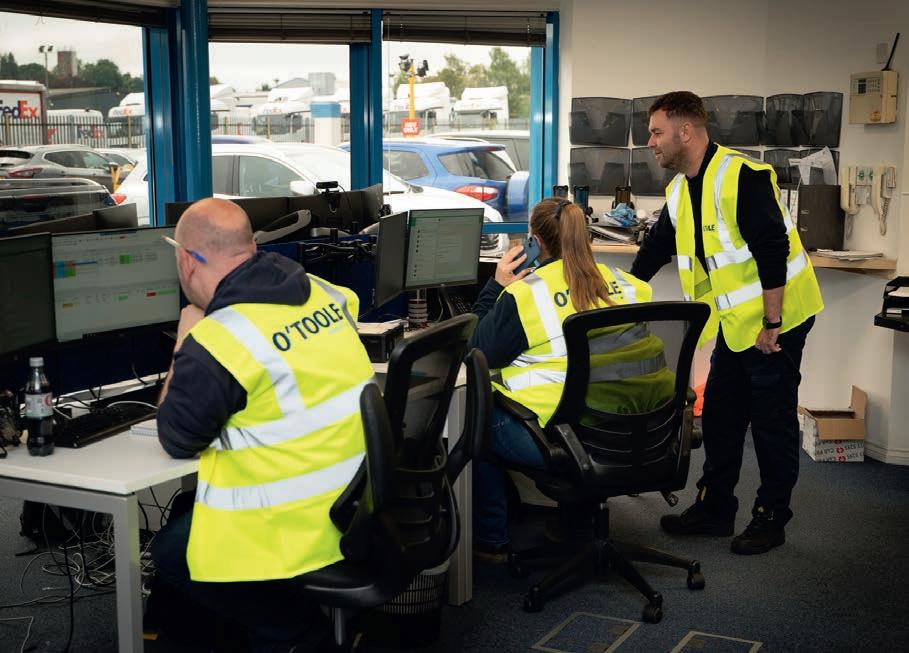








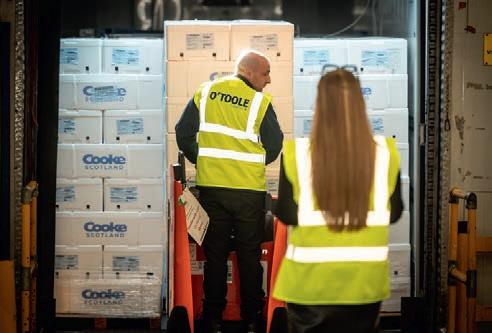
Opposite from top: Control center planning deliveries of Sco sh Salmon into Europe; MD Laurence O’Toole, O’Toole Transport
This page from top: O’Toole Truck, loaded for France; Driver brief; Salmon being loaded for delivery throughout Europe; The ellshill depot
Considering the secrets of the company’s success in Scotland, Laura Edgar, Operations Manager, says: “Our main strength is quality of service. As well as our expertise in our field, customers also appreciate that it’s easy to contact us.
“Our customers have direct access to the people they need to speak to. They can pick up the phone to Laurence, to me or to anyone else in the business –there’s no ‘wild-goose chase’ if they’re looking for information. If they have a question, we can give them answers there and then. That’s been instrumental in building strong relationships – we now have between 8-10 regular customers in
Scotland who are exporting fresh fish with us every day.”

There are other customer benefits, as Edgar explains: “All of our fresh fish exports to Europe are run on O’Toole Vehicles with two drivers in the cab, this guarantees that our lorries arrive in SIVEP (Veterinary and Phytosanitary Inspection Service) Boulogne on time, regardless of delays at the Eurotunnel, or traffic diversions. The two driver operation is a game changer & our customers love it!”
She adds: “We don’t have any trucks in Scotland that are over four years old. The trucks have GPS, which enables us to see where they are anywhere in the world at any given time, and we give customers access to this too. In addition, we have realtime temperature information, which is vital for transporting temperature-controlled fresh or frozen fish or seafood. At any time of the day or night we can tell our customers the exact temperature of their product, at that point in time.”
O’Toole Transport also delivers a seamless process on the other side of the Channel. It has a longstanding relationship with another family business, in France, which takes over distribution of the fish and seafood on arrival, dealing with all the formalities quickly and efficiently: “It’s like a Formula One pitstop operation,” observes O’Toole.
She concludes: “I believe the process is as fast now as it was before Brexit. So, there are no delays in getting the product onto the shelves and to the customer. And that’s what it’s all about –transporting fresh fish and seafood into France and beyond, as quickly and efficiently as possible.”





TWO underwater technology companies have made the shortlist for the Responsible Fisheries Innovation Awards, with the winner to be announced at the Responsible Seafood Summit in St Andrews later this month.

They are GenusWave, for its Targeted Acoustic Startle Technology (TAST) predator protection system, and Ace Aquatec for its biomass camera.

The GenusWave system is based on technology developed at the University of St Andrews, Scotland. It seeks to address the problems of previous models of acoustic deterrent devices (ADDs), which use a continuous sound emission to keep seals (and sealions, in the Pacific) away from fish farms.

Previous ADDs have been criticised for causing distress and disorientation to other marine mammals, such as whales and dolphins, and also run the risk that predators will simply become habituated to the sound and ignore it.
In contrast, the TAST system emits a burst of sound for less than half a second when predators are detected, at a frequency designed to scare seals while not distressing whales and dolphins.
Ace Aquatec’s biomass system, A-BIOMASS®, is an advanced underwater camera designed to bring more efficiency and precision to biomass measurement and distributions of a range of fish species.







The camera utilises machine learning and artificial intelligence (AI) to achieve real-time millimetre accuracy. Weighing just 8.5kg, this fully automated camera is smaller and easier to deploy than many others on the market. It leverages the latest AI technologies to ensure consistent average weight and accurate distribution over multiple harvests.
The camera is already being deployed by fish farmers around the world. The latest contract, announced last month, was with Mount Cook Alpine Salmon in New Zealand.
Mount Cook Alpine Salmon’s farms are located within a network of continuously flowing waterways, connecting three alpine lakes





and creating a unique set of circumstances. The camera’s unique training processes allows Ace Aquatec to tackle some of the toughest environments, like glacial melt water, low light conditions (starlight visibility) and a variety of fish types. This new precision has enabled Alpine Salmon to identify which fish to harvest whilst significantly minimising handling, thereby reducing stress for the fish and creating a safer and less labour-intensive environment for workers.
Jon Bailey, General Manager at Mount Cook Alpine Salmon, added: “The advanced A-BIOMASS® camera technology has consistently been very precise, with predictions aligning closely to our actual harvest rates and showing increased accuracy across multiple harvests over the past 18 months. Individual harvest results have significantly improved, and we hope to expand the use of these devices across more sites in the future to further optimise our operations.”
Underwater Contracting (UCO) and Mowi have announced a significant expansion of their partnership, focusing on the integration of cutting-edge remotely operated vehicle (ROV) technology in salmon farming. This collaboration underscores a shared commitment to enhancing operational efficiency and ensuring the highest welfare standards in aquaculture, the companies say, and will see a 40% expansion in the number of ROVs taken by Mowi for use on its sites.
UCO, with a focus on ROV development and subsurface innovation, supplies specialised tools and solutions tailored for the aquaculture industry. It maintains a particular emphasis on routine husbandry tasks such as mortality removal, net inspections and general stock maintenance.

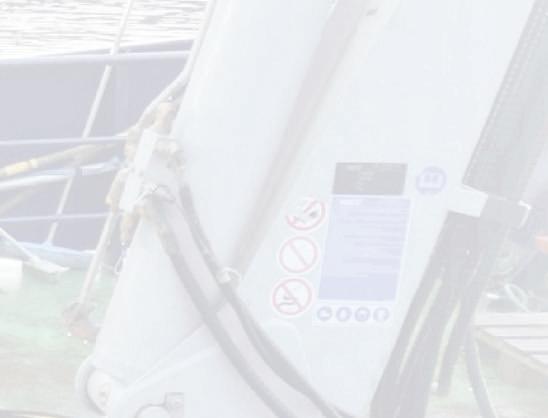



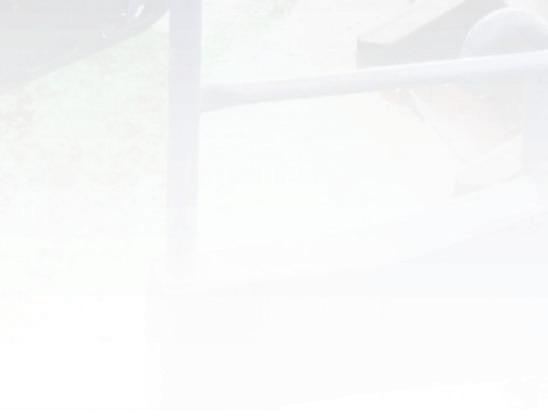
Announcing the deal, Michael Bower, Managing Director at UCO, said: “UCO is proud to provide solutions that solve subsurface challenges not only in aquaculture but also across industries such as renewable energy, oil and gas, and environmental surveying. Our research and development efforts, all based in Scotland, are key to delivering practical, usable solutions that enhance our customers’ operations.”




Mowi, globally the largest salmon farming company with operations in eight regions and an annual production of close to half a million tonnes of salmon, has been a long-standing partner of UCO since 2018. Over the last five years, the use of ROV systems on Mowi farm sites has increased significantly. In a new extended agreement, Mowi has increased its ROV fleet to a record high over 25 “Foover” units designed for removing mortalities (“morts”) from salmon pens.
”The… camera technology has consistently been very precise
Opposite from top: Mount Cook Alpine Salmon farm; Ace Aquatec’s
A-BIOMASS® camera
This page clockwise from top left: SAAB eM1-7 Electric Manipulator; Foover ROV; UCO Foover ROV; GenusWave TAST system; Chiari Petrioli

The next stage of UCO and Mowi’s partnership will focus on further enhancing the Foover system, developing capabilities for monitoring and removing surface moribund fish.
UCO is owner of the world’s largest fleet of Saab Seaeye Falcon ROVs, which serve as the platform for the Foover. Earlier this year, UCO added to its pool through the purchase of five new machines to give it a total of 38 Falcon systems.

in underwater monitoring and communication systems, was named as one of the European Union’s “Blue Champions” businesses. The announcement was made in May.


The SAAB Seaeye range of underwater remotely operated vehicles (ROVs), including the Falcon, Lynx and Cougar, is capable of being equipped with a range of tools and sensors.

This year, the company raised the bar with the introduction of the Seaeye eM1-7 Electric Manipulator, which SAAB describes as “the epitome of electric manipulation advancement”.
The new manipulator tool was unveiled at the Oceanology International trade show.
The eM1-7 has a lift capacity of 445kg in minimum extension and a 122kg in full extension. It features an advanced control system allowing both manual and automated operation.
SAAB says: “The Seaeye eM1-7 offers significant advantages over hydraulic alternatives, including more precise positioning with force feedback, increased dexterity, lower water weight and greater reliability - expanding the potential for more autonomous and resident applications.”
Earlier this year, WSense, an Italianbased deep tech company specialising


WSense, founded by engineering professor Chiari Petrioli, who is also the company’s CEO, has developed technology for a subsea “Internet of Things”. It was one of 70 projects from the EU and from European Economic Area (EEA) countries submitted for the newly created Blue Champions scheme.

The final list selected those companies that best met the criteria, as being
• aligned with the EU Mission “Restore our Ocean and Waters”
• likely to be profitable
• meeting the required quality standards
• mature enough and displayed the type of technology required.
WSense and the other winners will receive advisory support from the European Investment Bank Advisory Services and the European Investment Bank Projects Directorate for Innovation and Competitiveness. Some of the companies might also qualify for EIB (European Investment Bank) venture debt, a type of loan designed specifically for early-stage, high-growth companies.
The EU Blue Champions scheme not only promotes and supports promising ocean innovation but also identifies market failures and gaps in forward-looking technologies across blue economy sectors, from green shipping to new ocean energy solutions.





Lindgren-Pitman’s innovative net
cleaner





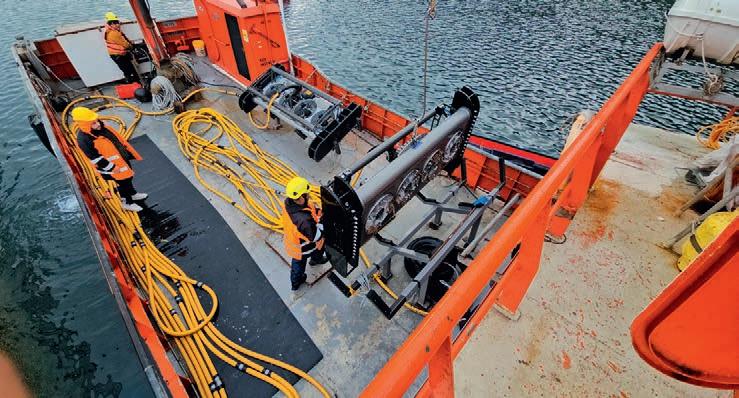
THROUGH more than a decade of R&D working with various farms and an in-house experienced aquaculture specialist, Lindgren-Pitman Inc has introduced the most effective and reliable net cleaner available today: the Stingray E230 ROV net cleaner system.
The Stingray E230 Series aquaculture net cleaner is a completely novel method of cleaning fouled nets in place. It is all electric, with AC-powered architecture, reducing greenhouse gas emissions significantly by reducing the use of diesel fuel while only using an 11-kW diesel powered generator vs the large generators required by inefficient, unreliable high-pressure saltwater pump cleaners.
The system relies on low-speed electric powered propellers with patented stainless-steel knuckles to implement “VibraClean” technology. This innovation vibrates, scrubs and sucks to remove all types of fouling while allowing the biofouling to flow in one direction. This includes but is not limited to mussel, kelp and other difficult growth that high-pressure cleaners cannot efficiently clean, while still being able to clean the soft growth. Through the elimination of highpressure water jets there is no stress to the fish from high decibel noise during the net cleaning, as documented by an on-site acoustic study. Extensive testing and real-world use have proven that these propellers and knuckles reduce wear on nets compared to highpressure cleaners.

The patented “Safetrak” glides above the net. It comprises of smooth stainlesssteel studs, mounted to flexible rubber stumps that bend over at a designed load to protect the net. The studs gently push the net to slide the Stingray over the net. The tracks also allow the ROV (remotely operated vehicle) to come partially out of the water to clean at and above the water line. The Stingray E230 is operated remotely via a corded remote joystick control and touchscreen with a four-camera video screen to operate and monitor the cleaning.
”The most effective and reliable net cleaner available today
The Stingray E230 in situ net cleaner, designed and fabricated in Pompano Beach, Florida (USA), has been working continuously in the Chilean market, cleaning where other net cleaners could not succeed. On any nonmetallic net, the patented technology and all-electric ROV has proven that biofouling including hard mussel and kelp growth can be removed without additional stress on the net and counter-intuitively using significantly less fuel.
With the following innovations of the Stingray E230 series net cleaner, Lindgren-Pitman offers a more efficient, environmentally, net and fish friendly netcleaning option to the aquaculture industry.
• 90% reduction in diesel fuel consumption vs high-pressure jet net cleaners
- All electric AC power
- Variable speed DC motors
- No large diesel-powered pump
• Patented VibraClean” Propellers and Knuckles (US Patent plus foreign No. US 11,116,188 B2)
• Patented “Safetrak” Tracks cannot damage nets (US Patent Pending plus foreign No. US 2021/0245205 A1)
• Small footprint allows multiple Stingrays on current vessels
• No scheduled maintenance
• Two-metre cleaning width
• Cleans all fouling at a fraction of the cost
From the top: The S�ngray E230 is rugged and reliable; Mul�ple units per vessel mul�plies work capacity; The S�ngray cleans all types of fouling

















Despite enlisting celebrity firepower, campaigners have not (yet) managed to stop plans for the UK’s biggest seaweed farm, as Sandy Neil reports
PLANS for two giant “no waste” seaweed farms off the north coast of Cornwall are back on the go with the authorities even after huge local objection, as the area’s MP asks ministers to ensure communities are consulted amid a “surge” of applications.
Biome Algae alongside Camel Fish Limited filed a double application with the Marine Management Organisation (MMO) for two 50-hectare seaweed farms in Port Quin Bay, between Polzeath and Port Isaac, in July 2023, with a 50-year licence running until 2073.
The Cornwall-based applicants say the cultivated seaweed, native to the UK, will provide food, low-carbon animal feed, fertiliser, and biomaterials to replace singleuse plastic and take-away cartons.
Moreover, they add, farming seaweed does not require freshwater, land, feed, fertilisers, does not produce waste, and can sequester carbon at a rate six times that of trees, as well as restore habitat and increase marine life. Each would deploy 144 160-metre longlines in the bay during September over two to three years, with seeded lines installed in October and early November each year, when sea temperatures are favourable. Harvesting would take place annually in April or May, when growth is maximised but biofouling is
avoided. Over 1,720 buoys with marker lights on at night would be installed.
The original applications did not receive any objection, which campaigners said was due to no-one locally knowing about it. The applicants had advertised their project, as requested by the MMO, in a local newspaper (Cornish Post), in Fishing News, and on Padstow Marina notice board, in October. However, after further consideration, the MMO concluded the public notice did not bring the application to the attention of people likely to be interested in it. So it asked the applicant to undertake a second public consultation between 16 February until 15 March 2024, during which it received “a large volume of public representations” – more

than 712, according to local reports, with 94.9% in opposition.


The issues, the MMO explained, related to the entanglement of marine mammals, impacts on seabird colonies and local fishermen, use of the bay as an anchorage, damage to the gear, and the visual impact of buoys on the Area of Outstanding Natural Beauty.
Cornwall-loving celebrities also came out in support of a campaign. Andrew Lincoln, star of The Walking Dead and Love, Actually, also waded in. The actor, who has a house near Tregardock which overlooks the bay, said: “As a surfer I always believed the sea is free; well, apparently not. It can be privatised and commercialised on an industrial scale without even consulting any locals.”
Dr Angela Mead, Biome Algae’s founder and CEO, said: “Both applications have been progressing through the formal channels in place and will continue to do so. As responsible operators we have and will provide regulatory bodies with a range of reports that assess plans in relation to the environment.
“Both Biome and Camel Fish’s intentions are not to harm the marine environment. We will










Opposite from top: Port Quin, Cornwall; Dr Angela Mead
This page from top: Seaweed; coastal footpath, Port Quin



add positively to the local economy, provide career opportunities and support education. Lighting on the farms will be the minimum required for navigational safety.
“It has been demonstrated that sustainable seaweed farming helps restore our marine environments. The seaweed itself has great potential to address a number of planetary issues such as replacing oil-based plastics, food security and net zero.”
After reviewing all the evidence from consultees, the MMO gave the applicants 42 days to respond to further information requests (FIRs) relating to marine mammal entanglement and the Habitats Regulations Assessment (HRA) - which they did, on the day of the deadline, 13 June.
But the MMO did not consider the submissions sufficient to fulfil the initial requests. Therefore, it placed the applications on hold and asked for more information to satisfy the FIRs within 14 days. If the applicants were unable to do so by 23 July, the MMO would issue a final sevenday “minded to refuse to proceed” letter. If a response was still not forthcoming, the MMO would reject the applications.
Save Our Bays campaigner and local resident Barnaby Kay cautiously welcomed the news. “It’s the beginning of the end for the project,” he said. “It isn’t a guarantee of victory for the campaigners, but we can’t see how Biome Algae can satisfy the MMO in the next 14 days, in which case the MMO will move to reject. We are not organising a party yet, but we’re beginning to think about it.”
However, they soon had to postpone planning any celebrations, because an MMO update said the applicants’ responses had been submitted on 23 July - and accepted. After a detailed review, the MMO will update its HRA, and reconsult consultees and the public.
Biome Algae and Camel Fish said they had “responded in full” to the MMO FIRs, and would “continue to comply with and work through the legal MMO framework related to the marine licence applications.
“The latest proposed public consultation round will enable the local community to consider information provided by the applicants in response to concerns they have raised.”
Mr Kay, backed by the local North Cornwall MP, Lib Dem Ben Maguire, local scientists and environmental campaigners, sent an open
Biome and Camel Fish’s intentions are not to harm the marine environment
letter to the Labour Secretary of State for the Environment, Food and Rural Affairs, Steve Reed. “The MMO now states that there will be a further public consultation period,” it said. “This is devastating for the local community, who cannot afford the cost, the hours, or the impact on their mental health of repeating this process.
“The issue is that there is a lack of experience, regulation and governance in marine planning, and as a result the MMO has been overwhelmed by the unprecedented surge in applications over the last two years, and are considering and granting long licences for vast, untested farm infrastructures.
“We do believe there is a place for seaweed production in the UK, likely further offshore and away from protected species and sustainable fisheries.”
In September Mr Maguire also asked Parliament to debate the issue of seaweed farm applications in his constituency, in particular “making sure the MMO properly informs, involves and consults with communities when processing marine licences for seaweed farms”. Certainly more people are now aware of the plans off Cornwall’s picturesque coast.
ACROSS the Bristol Channel in Wales, the pioneering Câr-y-Môr seaweed and shellfish farm in Pembrokeshire has been shortlisted for a prestigious BBC Food & Farming Award, in the Food Innovation category.
Câr-y-Môr, the first commercial seaweed and shellfish farm in Wales, was chosen from thousands of nominations by an expert panel of judges led by celebrity chef and broadcaster, Hugh FearnleyWhittingstall.
It employs zero input farming methods, which use no fertiliser, pesticides, or freshwater. Its goal is to improve the coastal environment and the well-being of the local community, stimulate jobs and give people a route into the Welsh seafood sector.
“This incredible recognition wouldn’t have been possible without our amazing community of gatherers and fishermen who provide us with the finest Welsh seafood, and our dedicated team who carefully harvest seaweed from our ocean farms, as well as process the shellfish in the early hours of the morning,” said Câr-y-Môr. “Together, we are driving sustainable practices and celebrating the bounty of our beautiful Welsh coast.”
The winners of the BBC Food & Farming Awards will be announced on 2 December in Glasgow.
The latest aquaculture events, conferences and courses
OCTOBER 24
ASSG CONFERENCE 2024
www.assg.org.uk
Corran Halls, Oban UK
October 29-30, 2024
With the theme “Scottish Cultivated ShellfishAssuring Value”, the Association of Scottish Shellfish Growers annual conference takes place in Oban.

NOVEMBER 24
SCOTTISH SEAWEED INDUSTRY ASSOCIATION
www.ssia.scot
Corran Halls, Oban UK
November 19-21, 2024
SSIA is an organisation dedicated to the growth and innovation of the seaweed industry.
AFRAQ 2024
www.was.org
Hammamet, Tunisia
November 19-22, 2024

24
ALGAEUROPE 2024
www.algaeurope.org
Athens, Greece
December 10-13, 2024
Venue: Divani Caravel Hotel
Conference on science, technology and business in the algae biomass sector.

25
AQUACULTURE 2025
www.was.org
New Orleans, Louisiana USA
March 6-10, 2025
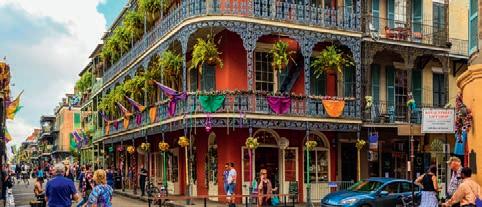
SEAGRICULTURE ASIAPACIFIC 2025
seagriculture-asiapacific.com
Adelaide, Australia 18-20 March 2025
APRIL 25
WORLD AQUACULTURE 2025 CHINA
www.was.org
Qingdao, China
April 24-27, 2025
MAY 25
AQUAFUTURE SPAIN 2025
www.aquafuturespain.com
Vigo, Spain
May 20-22, 2025
Venue: Ifevi Fairgrounds
An international meeting space for the Spanish aquaculture industry.
JUNE 25
SEAWORK
www.seawork.com
Southampton, United Kingdom
June 10-12, 2025
Europe’s largest on-water commercial marine and workboat exhibition.

SEAGRICULTURE EU 2025
www.seagriculture.eu
Rotterdam, The Netherlands
June 17-19, 2025
Leading conference for the seaweed industry in Europe
WORLD AQUACULTURE SAFARI 2025
www.was.org
Entebbe, Uganda
June 23-26, 2025
AUGUST 25
AQUA NOR 2025
www.aquanor.no
Trondheim, Norway
August 19-21, 2025
The world’s largest aquaculture technology showcase.

SEPTEMBER 25
AQUACULTURE EUROPE 2025
www.aquaeas.org
Valencia, Spain
September 22-25, 2025

OCTOBER 25
LACQUA 2025
www.was.org
Puerto Varas, Chile
October 6-9, 2025
FEBRUARY 26
AQUACULTURE AMERICA 2026
www.was.org
Las Vegas, Nevada, USA
February 16-19, 2026
Omega-3 pioneer prepares to scale up
A Scottish-based biotech company looking to develop a new source of natural omega-3 is planning to expand after raising £14m in funding. MiAlgae uses nutrient-rich by-products from the whisky industry to grow microalgae which are a source of omega-3, a crucial ingredient in aquafeed. The company hopes that using alternative sources like this will reduce the aquaculture sector’s reliance on wildcaught fish as a source of omega-3.

Dundee-based Ace Aquatech has secured grant funding from Michelin Development, an arm of tyre group Michelin that supports highpotential, small and medium-sized enterprises in and around the Dundee and Angus region. Ace Aquatec has developed a diverse portfolio of award-winning products aimed at making aquaculture more efficient and improving fish welfare. Nathan Pyne-Carter, CEO at Ace Aquatec, said: “Access to the funding has been invaluable to us in supporting our hiring programme and investment in technological innovations.”
PicturedareNathanPyne-Carter(left)withBrianCairnsofMichelin Development.
Technology company Aquabyte is launching a camera-based system that measures biomass and scores the welfare of smolt. The system uses a specially adapted camera that captures over one million images from the smolt tank each day. The images are analysed using machine learning and newly developed algorithms for smolt as small as 50 grams. Automatic weight measurement and welfare scoring with cameras also reduces the need for manual handling at the smolt facility.
Kristin Aase, Insight Manager at Aquabyte, said: “For farmers, it’s important to know the size and quality of the fish they receive so they can make the right decisions at the pen from day one.”

Vónin, a leader in innovative aquaculture solutions, has introduced its latest breakthrough: ROYAL antipredator netting. Designed to offer top-tier predator protection, ROYAL features high-performance fibres with exceptional strength and cut resistance. Its standout feature is its antifouling properties, ensuring long-lasting net cleanliness and reduced maintenance needs. The nonfloating design, combined with uncomfortable knots to deter predators, creates an effective barrier while maintaining peak performance. With ROYAL, Vónin continues to deliver cutting-edge solutions, providing fish farmers with unmatched security and efficiency in their operations. www.vonin.com



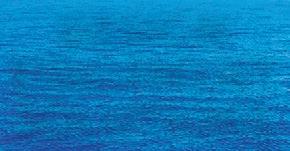

















































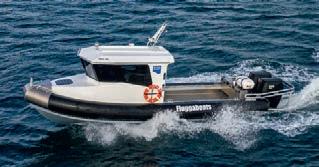
























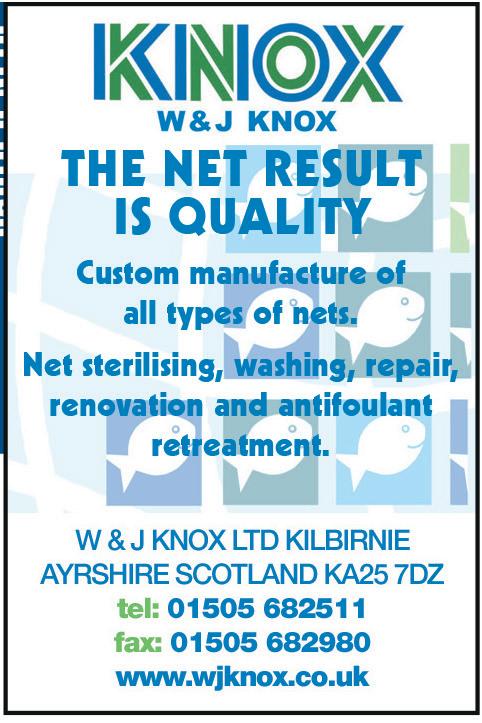
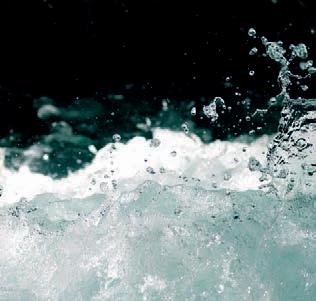




























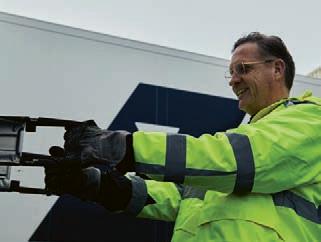
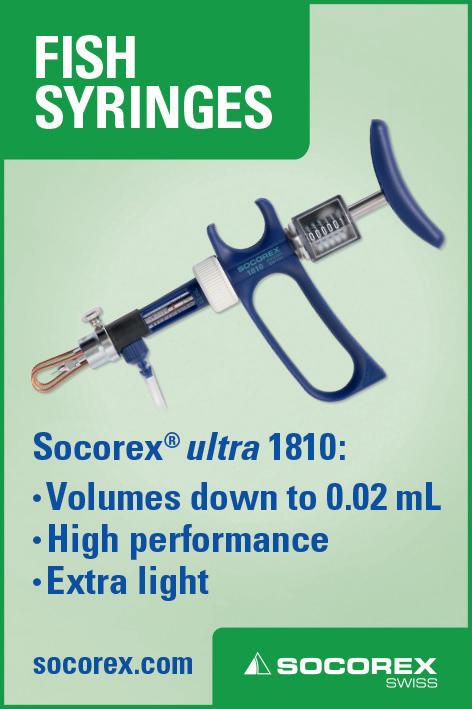













By Nick Joy
LUCKILY, age has not dimmed my memory yet, so I can remember the first discussions about serious commercial RAS (recirculating aquaculture systems) farming of salmon. I thought then it was a bad idea, and I have found no reason over the decades since to think any differently. Perhaps, though, it has become time to actually detail a bit more why I think it to be a red herring.
So let me break it down into sections. Recirculation is a complex business in any situation but the simplest is undoubtedly freshwater. Here the “only” issues are pH, oxygen, carbon dioxide and excretion products. When I say only I hope the irony is clear. These matters are complex to deal with when you are trying to manage a vulnerable fish. Of course some have had considerable success in freshwater but I would suggest that this is mostly because the production tonnage is small generally.
Seawater comes with a very different set of issues. Like a lot of things analysed by modern science, there was an assumption that seawater was a set of dissolved salts well-mixed and relatively stable. Science as we know it tends to like to break complex systems into single components and then reconstruct them assuming that this will work the same. History shows that too often this is a simplistic view. Interaction between components of a complex system often creates a different effect to the effect of those individual components added together. The next issue in production is the volume involved. To grow a significant weight of fish, particularly salmon, requires a very large amount of water or a significantly fast turnover of water. Both require highly complex systems managed by complex computer systems with inputs and maintenance by human beings. This tends to end up with a lot of fish dying or being very stressed.
Also, the stocking levels required for any reasonable form of economic return are very high. Every time I have been involved in such discussions, the numbers required have been too high for comfort. One case needed 4.5kg average at harvest, with a sub 1 FCR and a stocking density of 80kg/m3. This creates the next problem: to make the system pay, every tank has to be full as much of the time as possible. For farms at sea you can factor in a period when the pens are empty, to allow for poor performance and time for the fish to grow. If you have fish waiting to go into a tank and the fish in the tank have grown poorly then you have to harvest. Lastly, the market for these fish needs to be looked at carefully. The only reason for the production of these fish is because activists have put pressure on the industry for supposed environmental impact. At no time has the impact of these campaigns affected the growth of the fish farming market. At times it affected the price but rarely significantly and rarely for long.
The only place it has had an effect is with governments. I remember the time when the organic market took off and went from 0 to 1% of product sold in an extremely short time. We were told that this was the future of food production and we should all
”
This tends to end up with a lot of fish dying…
get ready for the change. In fact it tailed off pretty quickly and has settled down into a steady production and supply.
So, when you take a product that is grown in buildings with an easy comparison to a feed lot for cattle, it will be hard to market unless the environmentalists will fund your market campaign – and they won’t. Even if all of salmon farming moved onshore, I would like to bet you that the environmental groups would still attack it. After all, they have to earn their money somehow.
Finally if you are of the rather mad, risktaking persuasion and you need to virtue signal yourself to bankruptcy by creating a RAS farm, then may I suggest that you find another fish to do it with. Why not try John Dory or Dover sole, which at least command a high price? A small RAS farm could make enough money from a small tonnage.
People have said to me a few times, after buying a salmon farm when ISA (infectious salmon anaemia) was rife and the price was awful, that I was rather mad and seemed to want to take risks with the little money I had. I cannot argue with that sentiment but I am not mad enough to try RAS… yet! Maybe I will be persuaded one day.




































































